pyplot
matplotlib.pyplot
Provides a MATLAB-like plotting framework.
pylab combines pyplot with numpy into a single namespace. This is convenient for interactive work, but for programming it is recommended that the namespaces be kept separate, e.g.:
import numpy as np import matplotlib.pyplot as plt x = np.arange(0, 5, 0.1); y = np.sin(x) plt.plot(x, y)
-
matplotlib.pyplot.acorr(x, hold=None, data=None, **kwargs) -
Plot the autocorrelation of
x.Parameters: x : sequence of scalar
hold : boolean, optional, default: True
detrend : callable, optional, default:
mlab.detrend_nonex is detrended by the
detrendcallable. Default is no normalization.normed : boolean, optional, default: True
if True, normalize the data by the autocorrelation at the 0-th lag.
usevlines : boolean, optional, default: True
if True, Axes.vlines is used to plot the vertical lines from the origin to the acorr. Otherwise, Axes.plot is used.
maxlags : integer, optional, default: 10
number of lags to show. If None, will return all 2 * len(x) - 1 lags.
Returns: (lags, c, line, b) : where:
Other Parameters: linestyle :
Line2Dprop, optional, default: NoneOnly used if usevlines is False.
marker : string, optional, default: ?o?
Notes
In addition to the above described arguments, this function can take a data keyword argument. If such a data argument is given, the following arguments are replaced by data[<arg>]:
- All arguments with the following names: ?x?.
Additional kwargs: hold = [True|False] overrides default hold state
Examples
xcorris top graph, andacorris bottom graph.(Source code, png, hires.png, pdf)
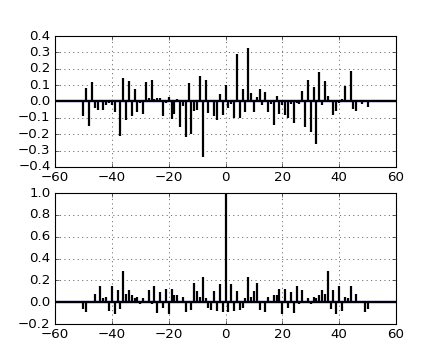
-
matplotlib.pyplot.angle_spectrum(x, Fs=None, Fc=None, window=None, pad_to=None, sides=None, hold=None, data=None, **kwargs) -
Plot the angle spectrum.
Call signature:
angle_spectrum(x, Fs=2, Fc=0, window=mlab.window_hanning, pad_to=None, sides='default', **kwargs)Compute the angle spectrum (wrapped phase spectrum) of x. Data is padded to a length of pad_to and the windowing function window is applied to the signal.
- x: 1-D array or sequence
- Array or sequence containing the data
Keyword arguments:
- Fs: scalar
- The sampling frequency (samples per time unit). It is used to calculate the Fourier frequencies, freqs, in cycles per time unit. The default value is 2.
- window: callable or ndarray
- A function or a vector of length NFFT. To create window vectors see
window_hanning(),window_none(),numpy.blackman(),numpy.hamming(),numpy.bartlett(),scipy.signal(),scipy.signal.get_window(), etc. The default iswindow_hanning(). If a function is passed as the argument, it must take a data segment as an argument and return the windowed version of the segment. - sides: [ ?default? | ?onesided? | ?twosided? ]
- Specifies which sides of the spectrum to return. Default gives the default behavior, which returns one-sided for real data and both for complex data. ?onesided? forces the return of a one-sided spectrum, while ?twosided? forces two-sided.
- pad_to: integer
- The number of points to which the data segment is padded when performing the FFT. While not increasing the actual resolution of the spectrum (the minimum distance between resolvable peaks), this can give more points in the plot, allowing for more detail. This corresponds to the n parameter in the call to fft(). The default is None, which sets pad_to equal to the length of the input signal (i.e. no padding).
- Fc: integer
- The center frequency of x (defaults to 0), which offsets the x extents of the plot to reflect the frequency range used when a signal is acquired and then filtered and downsampled to baseband.
Returns the tuple (spectrum, freqs, line):
- spectrum: 1-D array
- The values for the angle spectrum in radians (real valued)
- freqs: 1-D array
- The frequencies corresponding to the elements in spectrum
-
line: a Line2D instance - The line created by this function
kwargs control the
Line2Dproperties:Property Description agg_filterunknown alphafloat (0.0 transparent through 1.0 opaque) animated[True | False] antialiasedor aa[True | False] axesan Axesinstanceclip_boxa matplotlib.transforms.Bboxinstanceclip_on[True | False] clip_path[ ( Path,Transform) |Patch| None ]coloror cany matplotlib color containsa callable function dash_capstyle[?butt? | ?round? | ?projecting?] dash_joinstyle[?miter? | ?round? | ?bevel?] dashessequence of on/off ink in points drawstyle[?default? | ?steps? | ?steps-pre? | ?steps-mid? | ?steps-post?] figurea matplotlib.figure.Figureinstancefillstyle[?full? | ?left? | ?right? | ?bottom? | ?top? | ?none?] gidan id string labelstring or anything printable with ?%s? conversion. linestyleor ls[?solid? | ?dashed?, ?dashdot?, ?dotted? | (offset, on-off-dash-seq) | '-'|'--'|'-.'|':'|'None'|' '|'']linewidthor lwfloat value in points markerA valid marker stylemarkeredgecoloror mecany matplotlib color markeredgewidthor mewfloat value in points markerfacecoloror mfcany matplotlib color markerfacecoloraltor mfcaltany matplotlib color markersizeor msfloat markevery[None | int | length-2 tuple of int | slice | list/array of int | float | length-2 tuple of float] path_effectsunknown pickerfloat distance in points or callable pick function fn(artist, event)pickradiusfloat distance in points rasterized[True | False | None] sketch_paramsunknown snapunknown solid_capstyle[?butt? | ?round? | ?projecting?] solid_joinstyle[?miter? | ?round? | ?bevel?] transforma matplotlib.transforms.Transforminstanceurla url string visible[True | False] xdata1D array ydata1D array zorderany number Example:
(Source code, png, hires.png, pdf)
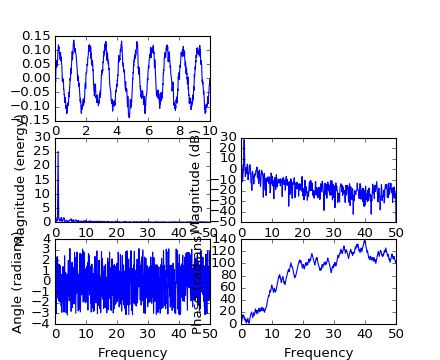
See also
-
magnitude_spectrum() -
angle_spectrum()plots the magnitudes of the corresponding frequencies. -
phase_spectrum() -
phase_spectrum()plots the unwrapped version of this function. -
specgram() -
specgram()can plot the angle spectrum of segments within the signal in a colormap.
Notes
In addition to the above described arguments, this function can take a data keyword argument. If such a data argument is given, the following arguments are replaced by data[<arg>]:
- All arguments with the following names: ?x?.
Additional kwargs: hold = [True|False] overrides default hold state
-
matplotlib.pyplot.annotate(*args, **kwargs) -
Annotate the point
xywith texts.Additional kwargs are passed to
Text.Parameters: s : str
The text of the annotation
xy : iterable
Length 2 sequence specifying the (x,y) point to annotate
xytext : iterable, optional
Length 2 sequence specifying the (x,y) to place the text at. If None, defaults to
xy.xycoords : str, Artist, Transform, callable or tuple, optional
The coordinate system that
xyis given in.For a
strthe allowed values are:Property Description ?figure points? points from the lower left of the figure ?figure pixels? pixels from the lower left of the figure ?figure fraction? fraction of figure from lower left ?axes points? points from lower left corner of axes ?axes pixels? pixels from lower left corner of axes ?axes fraction? fraction of axes from lower left ?data? use the coordinate system of the object being annotated (default) ?polar? (theta,r) if not native ?data? coordinates If a
Artistobject is passed in the units are fraction if it?s bounding box.If a
Transformobject is passed in use that to transformxyto screen coordinatesIf a callable it must take a
RendererBaseobject as input and return aTransformorBboxobjectIf a
tuplemust be length 2 tuple of str,Artist,Transformor callable objects. The first transform is used for the x coordinate and the second for y.See Annotating Axes for more details.
Defaults to
'data'textcoords : str,
Artist,Transform, callable or tuple, optionalThe coordinate system that
xytextis given, which may be different than the coordinate system used forxy.All
xycoordsvalues are valid as well as the following strings:Property Description ?offset points? offset (in points) from the xy value ?offset pixels? offset (in pixels) from the xy value defaults to the input of
xycoordsarrowprops : dict, optional
If not None, properties used to draw a
FancyArrowPatcharrow betweenxyandxytext.If
arrowpropsdoes not contain the key'arrowstyle'the allowed keys are:Key Description width the width of the arrow in points headwidth the width of the base of the arrow head in points headlength the length of the arrow head in points shrink fraction of total length to ?shrink? from both ends ? any key to matplotlib.patches.FancyArrowPatchIf the
arrowpropscontains the key'arrowstyle'the above keys are forbidden. The allowed values of'arrowstyle'are:Name Attrs '-'None '->'head_length=0.4,head_width=0.2 '-['widthB=1.0,lengthB=0.2,angleB=None '|-|'widthA=1.0,widthB=1.0 '-|>'head_length=0.4,head_width=0.2 '<-'head_length=0.4,head_width=0.2 '<->'head_length=0.4,head_width=0.2 '<|-'head_length=0.4,head_width=0.2 '<|-|>'head_length=0.4,head_width=0.2 'fancy'head_length=0.4,head_width=0.4,tail_width=0.4 'simple'head_length=0.5,head_width=0.5,tail_width=0.2 'wedge'tail_width=0.3,shrink_factor=0.5 Valid keys for
FancyArrowPatchare:Key Description arrowstyle the arrow style connectionstyle the connection style relpos default is (0.5, 0.5) patchA default is bounding box of the text patchB default is None shrinkA default is 2 points shrinkB default is 2 points mutation_scale default is text size (in points) mutation_aspect default is 1. ? any key for matplotlib.patches.PathPatchDefaults to None
annotation_clip : bool, optional
Controls the visibility of the annotation when it goes outside the axes area.
If
True, the annotation will only be drawn when thexyis inside the axes. IfFalse, the annotation will always be drawn regardless of its position.The default is
None, which behave asTrueonly if xycoords is ?data?.Returns: Annotation
-
matplotlib.pyplot.arrow(x, y, dx, dy, hold=None, **kwargs) -
Add an arrow to the axes.
Call signature:
arrow(x, y, dx, dy, **kwargs)
Draws arrow on specified axis from (x, y) to (x + dx, y + dy). Uses FancyArrow patch to construct the arrow.
The resulting arrow is affected by the axes aspect ratio and limits. This may produce an arrow whose head is not square with its stem. To create an arrow whose head is square with its stem, use
annotate()for example:ax.annotate("", xy=(0.5, 0.5), xytext=(0, 0), arrowprops=dict(arrowstyle="->"))Optional kwargs control the arrow construction and properties:
- Constructor arguments
-
- width: float (default: 0.001)
- width of full arrow tail
- length_includes_head: [True | False] (default: False)
- True if head is to be counted in calculating the length.
- head_width: float or None (default: 3*width)
- total width of the full arrow head
- head_length: float or None (default: 1.5 * head_width)
- length of arrow head
- shape: [?full?, ?left?, ?right?] (default: ?full?)
- draw the left-half, right-half, or full arrow
- overhang: float (default: 0)
- fraction that the arrow is swept back (0 overhang means triangular shape). Can be negative or greater than one.
- head_starts_at_zero: [True | False] (default: False)
- if True, the head starts being drawn at coordinate 0 instead of ending at coordinate 0.
Other valid kwargs (inherited from
Patch) are:Property Description agg_filterunknown alphafloat or None animated[True | False] antialiasedor aa[True | False] or None for default axesan Axesinstancecapstyle[?butt? | ?round? | ?projecting?] clip_boxa matplotlib.transforms.Bboxinstanceclip_on[True | False] clip_path[ ( Path,Transform) |Patch| None ]colormatplotlib color spec containsa callable function edgecoloror ecmpl color spec, or None for default, or ?none? for no color facecoloror fcmpl color spec, or None for default, or ?none? for no color figurea matplotlib.figure.Figureinstancefill[True | False] gidan id string hatch[?/? | ?\? | ?|? | ?-? | ?+? | ?x? | ?o? | ?O? | ?.? | ?*?] joinstyle[?miter? | ?round? | ?bevel?] labelstring or anything printable with ?%s? conversion. linestyleor ls[?solid? | ?dashed?, ?dashdot?, ?dotted? | (offset, on-off-dash-seq) | '-'|'--'|'-.'|':'|'None'|' '|'']linewidthor lwfloat or None for default path_effectsunknown picker[None|float|boolean|callable] rasterized[True | False | None] sketch_paramsunknown snapunknown transformTransforminstanceurla url string visible[True | False] zorderany number Example:
(Source code, png, hires.png, pdf)
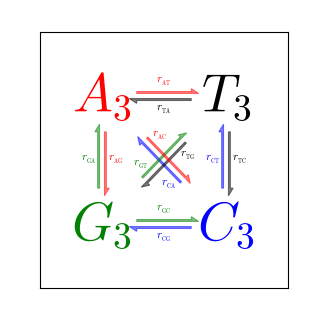
Additional kwargs: hold = [True|False] overrides default hold state
-
matplotlib.pyplot.autoscale(enable=True, axis='both', tight=None) -
Autoscale the axis view to the data (toggle).
Convenience method for simple axis view autoscaling. It turns autoscaling on or off, and then, if autoscaling for either axis is on, it performs the autoscaling on the specified axis or axes.
- enable: [True | False | None]
- True (default) turns autoscaling on, False turns it off. None leaves the autoscaling state unchanged.
- axis: [?x? | ?y? | ?both?]
- which axis to operate on; default is ?both?
- tight: [True | False | None]
- If True, set view limits to data limits; if False, let the locator and margins expand the view limits; if None, use tight scaling if the only artist is an image, otherwise treat tight as False. The tight setting is retained for future autoscaling until it is explicitly changed.
Returns None.
-
matplotlib.pyplot.autumn() -
set the default colormap to autumn and apply to current image if any. See help(colormaps) for more information
-
matplotlib.pyplot.axes(*args, **kwargs) -
Add an axes to the figure.
The axes is added at position rect specified by:
-
axes()by itself creates a default fullsubplot(111)window axis. -
axes(rect, axisbg='w')where rect = [left, bottom, width, height] in normalized (0, 1) units. axisbg is the background color for the axis, default white. -
axes(h)where h is an axes instance makes h the current axis. AnAxesinstance is returned.
kwarg Accepts Description axisbg color the axes background color frameon [True|False] display the frame? sharex otherax current axes shares xaxis attribute with otherax sharey otherax current axes shares yaxis attribute with otherax polar [True|False] use a polar axes? aspect [str | num] [?equal?, ?auto?] or a number. If a number the ratio of x-unit/y-unit in screen-space. Also see set_aspect().Examples:
-
examples/pylab_examples/axes_demo.pyplaces custom axes. -
examples/pylab_examples/shared_axis_demo.pyuses sharex and sharey.
-
-
matplotlib.pyplot.axhline(y=0, xmin=0, xmax=1, hold=None, **kwargs) -
Add a horizontal line across the axis.
Parameters: y : scalar, optional, default: 0
y position in data coordinates of the horizontal line.
xmin : scalar, optional, default: 0
Should be between 0 and 1, 0 being the far left of the plot, 1 the far right of the plot.
xmax : scalar, optional, default: 1
Should be between 0 and 1, 0 being the far left of the plot, 1 the far right of the plot.
Returns: Notes
kwargs are passed to
Line2Dand can be used to control the line properties.Examples
-
draw a thick red hline at ?y? = 0 that spans the xrange:
>>> axhline(linewidth=4, color='r')
-
draw a default hline at ?y? = 1 that spans the xrange:
>>> axhline(y=1)
-
draw a default hline at ?y? = .5 that spans the middle half of the xrange:
>>> axhline(y=.5, xmin=0.25, xmax=0.75)
Valid kwargs are
Line2Dproperties, with the exception of ?transform?:Property Description agg_filterunknown alphafloat (0.0 transparent through 1.0 opaque) animated[True | False] antialiasedor aa[True | False] axesan Axesinstanceclip_boxa matplotlib.transforms.Bboxinstanceclip_on[True | False] clip_path[ ( Path,Transform) |Patch| None ]coloror cany matplotlib color containsa callable function dash_capstyle[?butt? | ?round? | ?projecting?] dash_joinstyle[?miter? | ?round? | ?bevel?] dashessequence of on/off ink in points drawstyle[?default? | ?steps? | ?steps-pre? | ?steps-mid? | ?steps-post?] figurea matplotlib.figure.Figureinstancefillstyle[?full? | ?left? | ?right? | ?bottom? | ?top? | ?none?] gidan id string labelstring or anything printable with ?%s? conversion. linestyleor ls[?solid? | ?dashed?, ?dashdot?, ?dotted? | (offset, on-off-dash-seq) | '-'|'--'|'-.'|':'|'None'|' '|'']linewidthor lwfloat value in points markerA valid marker stylemarkeredgecoloror mecany matplotlib color markeredgewidthor mewfloat value in points markerfacecoloror mfcany matplotlib color markerfacecoloraltor mfcaltany matplotlib color markersizeor msfloat markevery[None | int | length-2 tuple of int | slice | list/array of int | float | length-2 tuple of float] path_effectsunknown pickerfloat distance in points or callable pick function fn(artist, event)pickradiusfloat distance in points rasterized[True | False | None] sketch_paramsunknown snapunknown solid_capstyle[?butt? | ?round? | ?projecting?] solid_joinstyle[?miter? | ?round? | ?bevel?] transforma matplotlib.transforms.Transforminstanceurla url string visible[True | False] xdata1D array ydata1D array zorderany number -
-
matplotlib.pyplot.axhspan(ymin, ymax, xmin=0, xmax=1, hold=None, **kwargs) -
Add a horizontal span (rectangle) across the axis.
Call signature:
axhspan(ymin, ymax, xmin=0, xmax=1, **kwargs)
y coords are in data units and x coords are in axes (relative 0-1) units.
Draw a horizontal span (rectangle) from ymin to ymax. With the default values of xmin = 0 and xmax = 1, this always spans the xrange, regardless of the xlim settings, even if you change them, e.g., with the
set_xlim()command. That is, the horizontal extent is in axes coords: 0=left, 0.5=middle, 1.0=right but the y location is in data coordinates.Return value is a
matplotlib.patches.Polygoninstance.Examples:
-
draw a gray rectangle from y = 0.25-0.75 that spans the horizontal extent of the axes:
>>> axhspan(0.25, 0.75, facecolor='0.5', alpha=0.5)
Valid kwargs are
Polygonproperties:Property Description agg_filterunknown alphafloat or None animated[True | False] antialiasedor aa[True | False] or None for default axesan Axesinstancecapstyle[?butt? | ?round? | ?projecting?] clip_boxa matplotlib.transforms.Bboxinstanceclip_on[True | False] clip_path[ ( Path,Transform) |Patch| None ]colormatplotlib color spec containsa callable function edgecoloror ecmpl color spec, or None for default, or ?none? for no color facecoloror fcmpl color spec, or None for default, or ?none? for no color figurea matplotlib.figure.Figureinstancefill[True | False] gidan id string hatch[?/? | ?\? | ?|? | ?-? | ?+? | ?x? | ?o? | ?O? | ?.? | ?*?] joinstyle[?miter? | ?round? | ?bevel?] labelstring or anything printable with ?%s? conversion. linestyleor ls[?solid? | ?dashed?, ?dashdot?, ?dotted? | (offset, on-off-dash-seq) | '-'|'--'|'-.'|':'|'None'|' '|'']linewidthor lwfloat or None for default path_effectsunknown picker[None|float|boolean|callable] rasterized[True | False | None] sketch_paramsunknown snapunknown transformTransforminstanceurla url string visible[True | False] zorderany number Example:
(Source code, png, hires.png, pdf)
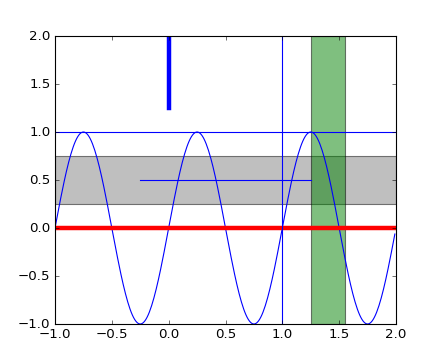
Additional kwargs: hold = [True|False] overrides default hold state
-
-
matplotlib.pyplot.axis(*v, **kwargs) -
Convenience method to get or set axis properties.
Calling with no arguments:
>>> axis()
returns the current axes limits
[xmin, xmax, ymin, ymax].:>>> axis(v)
sets the min and max of the x and y axes, with
v = [xmin, xmax, ymin, ymax].:>>> axis('off')turns off the axis lines and labels.:
>>> axis('equal')changes limits of x or y axis so that equal increments of x and y have the same length; a circle is circular.:
>>> axis('scaled')achieves the same result by changing the dimensions of the plot box instead of the axis data limits.:
>>> axis('tight')changes x and y axis limits such that all data is shown. If all data is already shown, it will move it to the center of the figure without modifying (xmax - xmin) or (ymax - ymin). Note this is slightly different than in MATLAB.:
>>> axis('image')is ?scaled? with the axis limits equal to the data limits.:
>>> axis('auto')and:
>>> axis('normal')are deprecated. They restore default behavior; axis limits are automatically scaled to make the data fit comfortably within the plot box.
if
len(*v)==0, you can pass in xmin, xmax, ymin, ymax as kwargs selectively to alter just those limits without changing the others.>>> axis('square')changes the limit ranges (xmax-xmin) and (ymax-ymin) of the x and y axes to be the same, and have the same scaling, resulting in a square plot.
The xmin, xmax, ymin, ymax tuple is returned
See also
-
xlim(),ylim() - For setting the x- and y-limits individually.
-
-
matplotlib.pyplot.axvline(x=0, ymin=0, ymax=1, hold=None, **kwargs) -
Add a vertical line across the axes.
Parameters: x : scalar, optional, default: 0
x position in data coordinates of the vertical line.
ymin : scalar, optional, default: 0
Should be between 0 and 1, 0 being the bottom of the plot, 1 the top of the plot.
ymax : scalar, optional, default: 1
Should be between 0 and 1, 0 being the bottom of the plot, 1 the top of the plot.
Returns: Examples
-
draw a thick red vline at x = 0 that spans the yrange:
>>> axvline(linewidth=4, color='r')
-
draw a default vline at x = 1 that spans the yrange:
>>> axvline(x=1)
-
draw a default vline at x = .5 that spans the middle half of the yrange:
>>> axvline(x=.5, ymin=0.25, ymax=0.75)
Valid kwargs are
Line2Dproperties, with the exception of ?transform?:Property Description agg_filterunknown alphafloat (0.0 transparent through 1.0 opaque) animated[True | False] antialiasedor aa[True | False] axesan Axesinstanceclip_boxa matplotlib.transforms.Bboxinstanceclip_on[True | False] clip_path[ ( Path,Transform) |Patch| None ]coloror cany matplotlib color containsa callable function dash_capstyle[?butt? | ?round? | ?projecting?] dash_joinstyle[?miter? | ?round? | ?bevel?] dashessequence of on/off ink in points drawstyle[?default? | ?steps? | ?steps-pre? | ?steps-mid? | ?steps-post?] figurea matplotlib.figure.Figureinstancefillstyle[?full? | ?left? | ?right? | ?bottom? | ?top? | ?none?] gidan id string labelstring or anything printable with ?%s? conversion. linestyleor ls[?solid? | ?dashed?, ?dashdot?, ?dotted? | (offset, on-off-dash-seq) | '-'|'--'|'-.'|':'|'None'|' '|'']linewidthor lwfloat value in points markerA valid marker stylemarkeredgecoloror mecany matplotlib color markeredgewidthor mewfloat value in points markerfacecoloror mfcany matplotlib color markerfacecoloraltor mfcaltany matplotlib color markersizeor msfloat markevery[None | int | length-2 tuple of int | slice | list/array of int | float | length-2 tuple of float] path_effectsunknown pickerfloat distance in points or callable pick function fn(artist, event)pickradiusfloat distance in points rasterized[True | False | None] sketch_paramsunknown snapunknown solid_capstyle[?butt? | ?round? | ?projecting?] solid_joinstyle[?miter? | ?round? | ?bevel?] transforma matplotlib.transforms.Transforminstanceurla url string visible[True | False] xdata1D array ydata1D array zorderany number -
-
matplotlib.pyplot.axvspan(xmin, xmax, ymin=0, ymax=1, hold=None, **kwargs) -
Add a vertical span (rectangle) across the axes.
Call signature:
axvspan(xmin, xmax, ymin=0, ymax=1, **kwargs)
x coords are in data units and y coords are in axes (relative 0-1) units.
Draw a vertical span (rectangle) from xmin to xmax. With the default values of ymin = 0 and ymax = 1, this always spans the yrange, regardless of the ylim settings, even if you change them, e.g., with the
set_ylim()command. That is, the vertical extent is in axes coords: 0=bottom, 0.5=middle, 1.0=top but the y location is in data coordinates.Return value is the
matplotlib.patches.Polygoninstance.Examples:
-
draw a vertical green translucent rectangle from x=1.25 to 1.55 that spans the yrange of the axes:
>>> axvspan(1.25, 1.55, facecolor='g', alpha=0.5)
Valid kwargs are
Polygonproperties:Property Description agg_filterunknown alphafloat or None animated[True | False] antialiasedor aa[True | False] or None for default axesan Axesinstancecapstyle[?butt? | ?round? | ?projecting?] clip_boxa matplotlib.transforms.Bboxinstanceclip_on[True | False] clip_path[ ( Path,Transform) |Patch| None ]colormatplotlib color spec containsa callable function edgecoloror ecmpl color spec, or None for default, or ?none? for no color facecoloror fcmpl color spec, or None for default, or ?none? for no color figurea matplotlib.figure.Figureinstancefill[True | False] gidan id string hatch[?/? | ?\? | ?|? | ?-? | ?+? | ?x? | ?o? | ?O? | ?.? | ?*?] joinstyle[?miter? | ?round? | ?bevel?] labelstring or anything printable with ?%s? conversion. linestyleor ls[?solid? | ?dashed?, ?dashdot?, ?dotted? | (offset, on-off-dash-seq) | '-'|'--'|'-.'|':'|'None'|' '|'']linewidthor lwfloat or None for default path_effectsunknown picker[None|float|boolean|callable] rasterized[True | False | None] sketch_paramsunknown snapunknown transformTransforminstanceurla url string visible[True | False] zorderany number See also
-
axhspan() - for example plot and source code
Additional kwargs: hold = [True|False] overrides default hold state
-
-
matplotlib.pyplot.bar(left, height, width=0.8, bottom=None, hold=None, data=None, **kwargs) -
Make a bar plot.
Make a bar plot with rectangles bounded by:
-
left, left + width, bottom, bottom + height - (left, right, bottom and top edges)
Parameters: left : sequence of scalars
the x coordinates of the left sides of the bars
height : sequence of scalars
the heights of the bars
width : scalar or array-like, optional
the width(s) of the bars default: 0.8
bottom : scalar or array-like, optional
the y coordinate(s) of the bars default: None
color : scalar or array-like, optional
the colors of the bar faces
edgecolor : scalar or array-like, optional
the colors of the bar edges
linewidth : scalar or array-like, optional
width of bar edge(s). If None, use default linewidth; If 0, don?t draw edges. default: None
tick_label : string or array-like, optional
the tick labels of the bars default: None
xerr : scalar or array-like, optional
if not None, will be used to generate errorbar(s) on the bar chart default: None
yerr : scalar or array-like, optional
if not None, will be used to generate errorbar(s) on the bar chart default: None
ecolor : scalar or array-like, optional
specifies the color of errorbar(s) default: None
capsize : scalar, optional
determines the length in points of the error bar caps default: None, which will take the value from the
errorbar.capsizercParam.error_kw : dict, optional
dictionary of kwargs to be passed to errorbar method. ecolor and capsize may be specified here rather than as independent kwargs.
align : {?edge?, ?center?}, optional
If ?edge?, aligns bars by their left edges (for vertical bars) and by their bottom edges (for horizontal bars). If ?center?, interpret the
leftargument as the coordinates of the centers of the bars. To align on the align bars on the right edge pass a negativewidth.orientation : {?vertical?, ?horizontal?}, optional
The orientation of the bars.
log : boolean, optional
If true, sets the axis to be log scale. default: False
Returns: bars : matplotlib.container.BarContainer
Container with all of the bars + errorbars
See also
-
barh - Plot a horizontal bar plot.
Notes
In addition to the above described arguments, this function can take a data keyword argument. If such a data argument is given, the following arguments are replaced by data[<arg>]:
- All arguments with the following names: ?linewidth?, ?bottom?, ?yerr?, ?height?, ?xerr?, ?edgecolor?, ?tick_label?, ?color?, ?left?, ?width?, ?ecolor?.
Additional kwargs: hold = [True|False] overrides default hold state
Examples
Example: A stacked bar chart.
(Source code, png, hires.png, pdf)
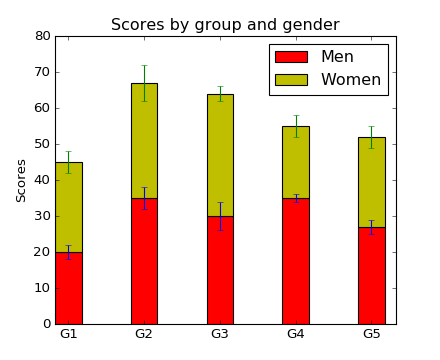
-
-
matplotlib.pyplot.barbs(*args, **kw) -
Plot a 2-D field of barbs.
Call signatures:
barb(U, V, **kw) barb(U, V, C, **kw) barb(X, Y, U, V, **kw) barb(X, Y, U, V, C, **kw)
Arguments:
- X, Y:
- The x and y coordinates of the barb locations (default is head of barb; see pivot kwarg)
- U, V:
- Give the x and y components of the barb shaft
- C:
- An optional array used to map colors to the barbs
All arguments may be 1-D or 2-D arrays or sequences. If X and Y are absent, they will be generated as a uniform grid. If U and V are 2-D arrays but X and Y are 1-D, and if
len(X)andlen(Y)match the column and row dimensions of U, then X and Y will be expanded withnumpy.meshgrid().U, V, C may be masked arrays, but masked X, Y are not supported at present.
Keyword arguments:
- length:
- Length of the barb in points; the other parts of the barb are scaled against this. Default is 9
- pivot: [ ?tip? | ?middle? ]
- The part of the arrow that is at the grid point; the arrow rotates about this point, hence the name pivot. Default is ?tip?
- barbcolor: [ color | color sequence ]
- Specifies the color all parts of the barb except any flags. This parameter is analagous to the edgecolor parameter for polygons, which can be used instead. However this parameter will override facecolor.
- flagcolor: [ color | color sequence ]
- Specifies the color of any flags on the barb. This parameter is analagous to the facecolor parameter for polygons, which can be used instead. However this parameter will override facecolor. If this is not set (and C has not either) then flagcolor will be set to match barbcolor so that the barb has a uniform color. If C has been set, flagcolor has no effect.
- sizes:
-
A dictionary of coefficients specifying the ratio of a given feature to the length of the barb. Only those values one wishes to override need to be included. These features include:
- ?spacing? - space between features (flags, full/half barbs)
- ?height? - height (distance from shaft to top) of a flag or full barb
- ?width? - width of a flag, twice the width of a full barb
- ?emptybarb? - radius of the circle used for low magnitudes
- fill_empty:
- A flag on whether the empty barbs (circles) that are drawn should be filled with the flag color. If they are not filled, they will be drawn such that no color is applied to the center. Default is False
- rounding:
- A flag to indicate whether the vector magnitude should be rounded when allocating barb components. If True, the magnitude is rounded to the nearest multiple of the half-barb increment. If False, the magnitude is simply truncated to the next lowest multiple. Default is True
- barb_increments:
-
A dictionary of increments specifying values to associate with different parts of the barb. Only those values one wishes to override need to be included.
- ?half? - half barbs (Default is 5)
- ?full? - full barbs (Default is 10)
- ?flag? - flags (default is 50)
- flip_barb:
- Either a single boolean flag or an array of booleans. Single boolean indicates whether the lines and flags should point opposite to normal for all barbs. An array (which should be the same size as the other data arrays) indicates whether to flip for each individual barb. Normal behavior is for the barbs and lines to point right (comes from wind barbs having these features point towards low pressure in the Northern Hemisphere.) Default is False
Barbs are traditionally used in meteorology as a way to plot the speed and direction of wind observations, but can technically be used to plot any two dimensional vector quantity. As opposed to arrows, which give vector magnitude by the length of the arrow, the barbs give more quantitative information about the vector magnitude by putting slanted lines or a triangle for various increments in magnitude, as show schematically below:
: /\ \ : / \ \ : / \ \ \ : / \ \ \ : ------------------------------
The largest increment is given by a triangle (or ?flag?). After those come full lines (barbs). The smallest increment is a half line. There is only, of course, ever at most 1 half line. If the magnitude is small and only needs a single half-line and no full lines or triangles, the half-line is offset from the end of the barb so that it can be easily distinguished from barbs with a single full line. The magnitude for the barb shown above would nominally be 65, using the standard increments of 50, 10, and 5.
linewidths and edgecolors can be used to customize the barb. Additional
PolyCollectionkeyword arguments:Property Description agg_filterunknown alphafloat or None animated[True | False] antialiasedor antialiasedsBoolean or sequence of booleans arrayunknown axesan Axesinstanceclima length 2 sequence of floats clip_boxa matplotlib.transforms.Bboxinstanceclip_on[True | False] clip_path[ ( Path,Transform) |Patch| None ]cmapa colormap or registered colormap name colormatplotlib color arg or sequence of rgba tuples containsa callable function edgecoloror edgecolorsmatplotlib color spec or sequence of specs facecoloror facecolorsmatplotlib color spec or sequence of specs figurea matplotlib.figure.Figureinstancegidan id string hatch[ ?/? | ?\? | ?|? | ?-? | ?+? | ?x? | ?o? | ?O? | ?.? | ?*? ] labelstring or anything printable with ?%s? conversion. linestyleor linestyles or dashes[?solid? | ?dashed?, ?dashdot?, ?dotted? | (offset, on-off-dash-seq) | '-'|'--'|'-.'|':'|'None'|' '|'']linewidthor linewidths or lwfloat or sequence of floats normunknown offset_positionunknown offsetsfloat or sequence of floats path_effectsunknown picker[None|float|boolean|callable] pickradiusunknown rasterized[True | False | None] sketch_paramsunknown snapunknown transformTransforminstanceurla url string urlsunknown visible[True | False] zorderany number Example:
Notes
In addition to the above described arguments, this function can take a data keyword argument. If such a data argument is given, the following arguments are replaced by data[<arg>]:
- All positional and all keyword arguments.
Additional kwargs: hold = [True|False] overrides default hold state
-
matplotlib.pyplot.barh(bottom, width, height=0.8, left=None, hold=None, **kwargs) -
Make a horizontal bar plot.
Make a horizontal bar plot with rectangles bounded by:
-
left, left + width, bottom, bottom + height - (left, right, bottom and top edges)
bottom,width,height, andleftcan be either scalars or sequencesParameters: bottom : scalar or array-like
the y coordinate(s) of the bars
width : scalar or array-like
the width(s) of the bars
height : sequence of scalars, optional, default: 0.8
the heights of the bars
left : sequence of scalars
the x coordinates of the left sides of the bars
Returns: matplotlib.patches.Rectangleinstances.Other Parameters: color : scalar or array-like, optional
the colors of the bars
edgecolor : scalar or array-like, optional
the colors of the bar edges
linewidth : scalar or array-like, optional, default: None
width of bar edge(s). If None, use default linewidth; If 0, don?t draw edges.
tick_label : string or array-like, optional, default: None
the tick labels of the bars
xerr : scalar or array-like, optional, default: None
if not None, will be used to generate errorbar(s) on the bar chart
yerr : scalar or array-like, optional, default: None
if not None, will be used to generate errorbar(s) on the bar chart
ecolor : scalar or array-like, optional, default: None
specifies the color of errorbar(s)
capsize : scalar, optional
determines the length in points of the error bar caps default: None, which will take the value from the
errorbar.capsizercParam.error_kw :
dictionary of kwargs to be passed to errorbar method.
ecolorandcapsizemay be specified here rather than as independent kwargs.align : [?edge? | ?center?], optional, default: ?edge?
If
edge, aligns bars by their left edges (for vertical bars) and by their bottom edges (for horizontal bars). Ifcenter, interpret theleftargument as the coordinates of the centers of the bars.log : boolean, optional, default: False
If true, sets the axis to be log scale
Notes
The optional arguments
color,edgecolor,linewidth,xerr, andyerrcan be either scalars or sequences of length equal to the number of bars. This enables you to use bar as the basis for stacked bar charts, or candlestick plots. Detail:xerrandyerrare passed directly toerrorbar(), so they can also have shape 2xN for independent specification of lower and upper errors.Other optional kwargs:
Property Description agg_filterunknown alphafloat or None animated[True | False] antialiasedor aa[True | False] or None for default axesan Axesinstancecapstyle[?butt? | ?round? | ?projecting?] clip_boxa matplotlib.transforms.Bboxinstanceclip_on[True | False] clip_path[ ( Path,Transform) |Patch| None ]colormatplotlib color spec containsa callable function edgecoloror ecmpl color spec, or None for default, or ?none? for no color facecoloror fcmpl color spec, or None for default, or ?none? for no color figurea matplotlib.figure.Figureinstancefill[True | False] gidan id string hatch[?/? | ?\? | ?|? | ?-? | ?+? | ?x? | ?o? | ?O? | ?.? | ?*?] joinstyle[?miter? | ?round? | ?bevel?] labelstring or anything printable with ?%s? conversion. linestyleor ls[?solid? | ?dashed?, ?dashdot?, ?dotted? | (offset, on-off-dash-seq) | '-'|'--'|'-.'|':'|'None'|' '|'']linewidthor lwfloat or None for default path_effectsunknown picker[None|float|boolean|callable] rasterized[True | False | None] sketch_paramsunknown snapunknown transformTransforminstanceurla url string visible[True | False] zorderany number -
-
matplotlib.pyplot.bone() -
set the default colormap to bone and apply to current image if any. See help(colormaps) for more information
-
matplotlib.pyplot.box(on=None) -
Turn the axes box on or off. on may be a boolean or a string, ?on? or ?off?.
If on is None, toggle state.
-
matplotlib.pyplot.boxplot(x, notch=None, sym=None, vert=None, whis=None, positions=None, widths=None, patch_artist=None, bootstrap=None, usermedians=None, conf_intervals=None, meanline=None, showmeans=None, showcaps=None, showbox=None, showfliers=None, boxprops=None, labels=None, flierprops=None, medianprops=None, meanprops=None, capprops=None, whiskerprops=None, manage_xticks=True, hold=None, data=None) -
Make a box and whisker plot.
Call signature:
boxplot(self, x, notch=None, sym=None, vert=None, whis=None, positions=None, widths=None, patch_artist=False, bootstrap=None, usermedians=None, conf_intervals=None, meanline=False, showmeans=False, showcaps=True, showbox=True, showfliers=True, boxprops=None, labels=None, flierprops=None, medianprops=None, meanprops=None, capprops=None, whiskerprops=None, manage_xticks=True, autorange=False):Make a box and whisker plot for each column of
xor each vector in sequencex. The box extends from the lower to upper quartile values of the data, with a line at the median. The whiskers extend from the box to show the range of the data. Flier points are those past the end of the whiskers.Parameters: x : Array or a sequence of vectors.
The input data.
notch : bool, optional (False)
If
True, will produce a notched box plot. Otherwise, a rectangular boxplot is produced.sym : str, optional
The default symbol for flier points. Enter an empty string (??) if you don?t want to show fliers. If
None, then the fliers default to ?b+? If you want more control use the flierprops kwarg.vert : bool, optional (True)
If
True(default), makes the boxes vertical. IfFalse, everything is drawn horizontally.whis : float, sequence, or string (default = 1.5)
As a float, determines the reach of the whiskers past the first and third quartiles (e.g., Q3 + whis*IQR, IQR = interquartile range, Q3-Q1). Beyond the whiskers, data are considered outliers and are plotted as individual points. Set this to an unreasonably high value to force the whiskers to show the min and max values. Alternatively, set this to an ascending sequence of percentile (e.g., [5, 95]) to set the whiskers at specific percentiles of the data. Finally,
whiscan be the string'range'to force the whiskers to the min and max of the data.bootstrap : int, optional
Specifies whether to bootstrap the confidence intervals around the median for notched boxplots. If
bootstrapis None, no bootstrapping is performed, and notches are calculated using a Gaussian-based asymptotic approximation (see McGill, R., Tukey, J.W., and Larsen, W.A., 1978, and Kendall and Stuart, 1967). Otherwise, bootstrap specifies the number of times to bootstrap the median to determine its 95% confidence intervals. Values between 1000 and 10000 are recommended.usermedians : array-like, optional
An array or sequence whose first dimension (or length) is compatible with
x. This overrides the medians computed by matplotlib for each element ofusermediansthat is notNone. When an element ofusermediansis None, the median will be computed by matplotlib as normal.conf_intervals : array-like, optional
Array or sequence whose first dimension (or length) is compatible with
xand whose second dimension is 2. When the an element ofconf_intervalsis not None, the notch locations computed by matplotlib are overridden (providednotchisTrue). When an element ofconf_intervalsisNone, the notches are computed by the method specified by the other kwargs (e.g.,bootstrap).positions : array-like, optional
Sets the positions of the boxes. The ticks and limits are automatically set to match the positions. Defaults to
range(1, N+1)where N is the number of boxes to be drawn.widths : scalar or array-like
Sets the width of each box either with a scalar or a sequence. The default is 0.5, or
0.15*(distance between extreme positions), if that is smaller.patch_artist : bool, optional (False)
If
Falseproduces boxes with the Line2D artist. Otherwise, boxes and drawn with Patch artists.labels : sequence, optional
Labels for each dataset. Length must be compatible with dimensions of
x.manage_xticks : bool, optional (True)
If the function should adjust the xlim and xtick locations.
autorange : bool, optional (False)
When
Trueand the data are distributed such that the 25th and 75th percentiles are equal,whisis set to'range'such that the whisker ends are at the minimum and maximum of the data.meanline : bool, optional (False)
If
True(andshowmeansisTrue), will try to render the mean as a line spanning the full width of the box according tomeanprops(see below). Not recommended ifshownotchesis also True. Otherwise, means will be shown as points.Returns: result : dict
A dictionary mapping each component of the boxplot to a list of the
matplotlib.lines.Line2Dinstances created. That dictionary has the following keys (assuming vertical boxplots):-
boxes: the main body of the boxplot showing the quartiles and the median?s confidence intervals if enabled. -
medians: horizontal lines at the median of each box. -
whiskers: the vertical lines extending to the most extreme, non-outlier data points. -
caps: the horizontal lines at the ends of the whiskers. -
fliers: points representing data that extend beyond the whiskers (fliers). -
means: points or lines representing the means.
Other Parameters: The following boolean options toggle the drawing of individual
components of the boxplots:
- showcaps: the caps on the ends of whiskers (default is True)
- showbox: the central box (default is True)
- showfliers: the outliers beyond the caps (default is True)
- showmeans: the arithmetic means (default is False)
The remaining options can accept dictionaries that specify the
style of the individual artists:
- capprops
- boxprops
- whiskerprops
- flierprops
- medianprops
- meanprops
Notes
In addition to the above described arguments, this function can take a data keyword argument. If such a data argument is given, the following arguments are replaced by data[<arg>]:
- All positional and all keyword arguments.
Additional kwargs: hold = [True|False] overrides default hold state
Examples
(Source code, png, hires.png, pdf)

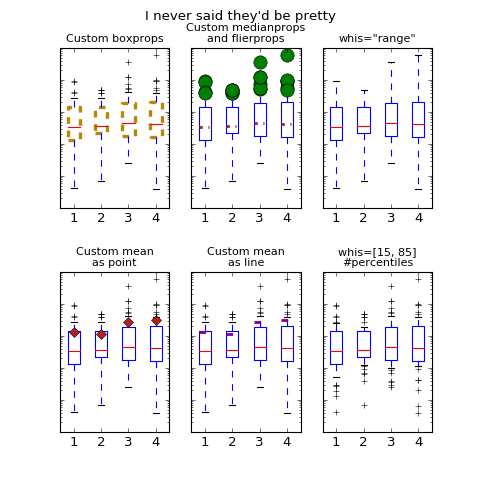
-
-
matplotlib.pyplot.broken_barh(xranges, yrange, hold=None, data=None, **kwargs) -
Plot horizontal bars.
Call signature:
broken_barh(self, xranges, yrange, **kwargs)
A collection of horizontal bars spanning yrange with a sequence of xranges.
Required arguments:
Argument Description xranges sequence of (xmin, xwidth) yrange sequence of (ymin, ywidth) kwargs are
matplotlib.collections.BrokenBarHCollectionproperties:Property Description agg_filterunknown alphafloat or None animated[True | False] antialiasedor antialiasedsBoolean or sequence of booleans arrayunknown axesan Axesinstanceclima length 2 sequence of floats clip_boxa matplotlib.transforms.Bboxinstanceclip_on[True | False] clip_path[ ( Path,Transform) |Patch| None ]cmapa colormap or registered colormap name colormatplotlib color arg or sequence of rgba tuples containsa callable function edgecoloror edgecolorsmatplotlib color spec or sequence of specs facecoloror facecolorsmatplotlib color spec or sequence of specs figurea matplotlib.figure.Figureinstancegidan id string hatch[ ?/? | ?\? | ?|? | ?-? | ?+? | ?x? | ?o? | ?O? | ?.? | ?*? ] labelstring or anything printable with ?%s? conversion. linestyleor linestyles or dashes[?solid? | ?dashed?, ?dashdot?, ?dotted? | (offset, on-off-dash-seq) | '-'|'--'|'-.'|':'|'None'|' '|'']linewidthor linewidths or lwfloat or sequence of floats normunknown offset_positionunknown offsetsfloat or sequence of floats path_effectsunknown picker[None|float|boolean|callable] pickradiusunknown rasterized[True | False | None] sketch_paramsunknown snapunknown transformTransforminstanceurla url string urlsunknown visible[True | False] zorderany number these can either be a single argument, i.e.,:
facecolors = 'black'
or a sequence of arguments for the various bars, i.e.,:
facecolors = ('black', 'red', 'green')Example:
(Source code, png, hires.png, pdf)
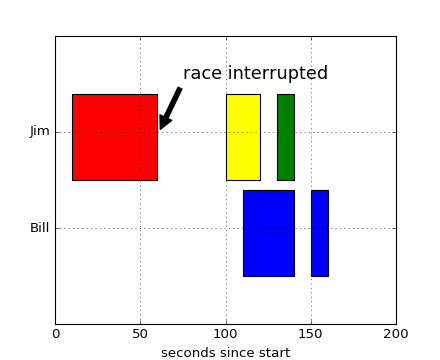
Notes
In addition to the above described arguments, this function can take a data keyword argument. If such a data argument is given, the following arguments are replaced by data[<arg>]:
- All positional and all keyword arguments.
Additional kwargs: hold = [True|False] overrides default hold state
-
matplotlib.pyplot.cla() -
Clear the current axes.
-
matplotlib.pyplot.clabel(CS, *args, **kwargs) -
Label a contour plot.
Call signature:
clabel(cs, **kwargs)
Adds labels to line contours in cs, where cs is a
ContourSetobject returned by contour.clabel(cs, v, **kwargs)
only labels contours listed in v.
Optional keyword arguments:
- fontsize:
- size in points or relative size e.g., ?smaller?, ?x-large?
- colors:
-
- if None, the color of each label matches the color of the corresponding contour
- if one string color, e.g., colors = ?r? or colors = ?red?, all labels will be plotted in this color
- if a tuple of matplotlib color args (string, float, rgb, etc), different labels will be plotted in different colors in the order specified
- inline:
- controls whether the underlying contour is removed or not. Default is True.
- inline_spacing:
- space in pixels to leave on each side of label when placing inline. Defaults to 5. This spacing will be exact for labels at locations where the contour is straight, less so for labels on curved contours.
- fmt:
- a format string for the label. Default is ?%1.3f? Alternatively, this can be a dictionary matching contour levels with arbitrary strings to use for each contour level (i.e., fmt[level]=string), or it can be any callable, such as a
Formatterinstance, that returns a string when called with a numeric contour level. - manual:
-
if True, contour labels will be placed manually using mouse clicks. Click the first button near a contour to add a label, click the second button (or potentially both mouse buttons at once) to finish adding labels. The third button can be used to remove the last label added, but only if labels are not inline. Alternatively, the keyboard can be used to select label locations (enter to end label placement, delete or backspace act like the third mouse button, and any other key will select a label location).
manual can be an iterable object of x,y tuples. Contour labels will be created as if mouse is clicked at each x,y positions.
- rightside_up:
- if True (default), label rotations will always be plus or minus 90 degrees from level.
- use_clabeltext:
- if True (default is False), ClabelText class (instead of matplotlib.Text) is used to create labels. ClabelText recalculates rotation angles of texts during the drawing time, therefore this can be used if aspect of the axes changes.
Additional kwargs: hold = [True|False] overrides default hold state
-
matplotlib.pyplot.clf() -
Clear the current figure.
-
matplotlib.pyplot.clim(vmin=None, vmax=None) -
Set the color limits of the current image.
To apply clim to all axes images do:
clim(0, 0.5)
If either vmin or vmax is None, the image min/max respectively will be used for color scaling.
If you want to set the clim of multiple images, use, for example:
for im in gca().get_images(): im.set_clim(0, 0.05)
-
matplotlib.pyplot.close(*args) -
Close a figure window.
close()by itself closes the current figureclose(h)where h is aFigureinstance, closes that figureclose(num)closes figure number numclose(name)where name is a string, closes figure with that labelclose('all')closes all the figure windows
-
matplotlib.pyplot.cohere(x, y, NFFT=256, Fs=2, Fc=0, detrend=, window=, noverlap=0, pad_to=None, sides='default', scale_by_freq=None, hold=None, data=None, **kwargs) -
Plot the coherence between x and y.
Call signature:
cohere(x, y, NFFT=256, Fs=2, Fc=0, detrend = mlab.detrend_none, window = mlab.window_hanning, noverlap=0, pad_to=None, sides='default', scale_by_freq=None, **kwargs)Plot the coherence between x and y. Coherence is the normalized cross spectral density:

Keyword arguments:
- Fs: scalar
- The sampling frequency (samples per time unit). It is used to calculate the Fourier frequencies, freqs, in cycles per time unit. The default value is 2.
- window: callable or ndarray
- A function or a vector of length NFFT. To create window vectors see
window_hanning(),window_none(),numpy.blackman(),numpy.hamming(),numpy.bartlett(),scipy.signal(),scipy.signal.get_window(), etc. The default iswindow_hanning(). If a function is passed as the argument, it must take a data segment as an argument and return the windowed version of the segment. - sides: [ ?default? | ?onesided? | ?twosided? ]
- Specifies which sides of the spectrum to return. Default gives the default behavior, which returns one-sided for real data and both for complex data. ?onesided? forces the return of a one-sided spectrum, while ?twosided? forces two-sided.
- pad_to: integer
- The number of points to which the data segment is padded when performing the FFT. This can be different from NFFT, which specifies the number of data points used. While not increasing the actual resolution of the spectrum (the minimum distance between resolvable peaks), this can give more points in the plot, allowing for more detail. This corresponds to the n parameter in the call to fft(). The default is None, which sets pad_to equal to NFFT
- NFFT: integer
- The number of data points used in each block for the FFT. A power 2 is most efficient. The default value is 256. This should NOT be used to get zero padding, or the scaling of the result will be incorrect. Use pad_to for this instead.
- detrend: [ ?default? | ?constant? | ?mean? | ?linear? | ?none?] or
- callable
The function applied to each segment before fft-ing, designed to remove the mean or linear trend. Unlike in MATLAB, where the detrend parameter is a vector, in matplotlib is it a function. The
pylabmodule definesdetrend_none(),detrend_mean(), anddetrend_linear(), but you can use a custom function as well. You can also use a string to choose one of the functions. ?default?, ?constant?, and ?mean? calldetrend_mean(). ?linear? callsdetrend_linear(). ?none? callsdetrend_none(). - scale_by_freq: boolean
- Specifies whether the resulting density values should be scaled by the scaling frequency, which gives density in units of Hz^-1. This allows for integration over the returned frequency values. The default is True for MATLAB compatibility.
- noverlap: integer
- The number of points of overlap between blocks. The default value is 0 (no overlap).
- Fc: integer
- The center frequency of x (defaults to 0), which offsets the x extents of the plot to reflect the frequency range used when a signal is acquired and then filtered and downsampled to baseband.
The return value is a tuple (Cxy, f), where f are the frequencies of the coherence vector.
kwargs are applied to the lines.
References:
- Bendat & Piersol ? Random Data: Analysis and Measurement Procedures, John Wiley & Sons (1986)
kwargs control the
Line2Dproperties of the coherence plot:Property Description agg_filterunknown alphafloat (0.0 transparent through 1.0 opaque) animated[True | False] antialiasedor aa[True | False] axesan Axesinstanceclip_boxa matplotlib.transforms.Bboxinstanceclip_on[True | False] clip_path[ ( Path,Transform) |Patch| None ]coloror cany matplotlib color containsa callable function dash_capstyle[?butt? | ?round? | ?projecting?] dash_joinstyle[?miter? | ?round? | ?bevel?] dashessequence of on/off ink in points drawstyle[?default? | ?steps? | ?steps-pre? | ?steps-mid? | ?steps-post?] figurea matplotlib.figure.Figureinstancefillstyle[?full? | ?left? | ?right? | ?bottom? | ?top? | ?none?] gidan id string labelstring or anything printable with ?%s? conversion. linestyleor ls[?solid? | ?dashed?, ?dashdot?, ?dotted? | (offset, on-off-dash-seq) | '-'|'--'|'-.'|':'|'None'|' '|'']linewidthor lwfloat value in points markerA valid marker stylemarkeredgecoloror mecany matplotlib color markeredgewidthor mewfloat value in points markerfacecoloror mfcany matplotlib color markerfacecoloraltor mfcaltany matplotlib color markersizeor msfloat markevery[None | int | length-2 tuple of int | slice | list/array of int | float | length-2 tuple of float] path_effectsunknown pickerfloat distance in points or callable pick function fn(artist, event)pickradiusfloat distance in points rasterized[True | False | None] sketch_paramsunknown snapunknown solid_capstyle[?butt? | ?round? | ?projecting?] solid_joinstyle[?miter? | ?round? | ?bevel?] transforma matplotlib.transforms.Transforminstanceurla url string visible[True | False] xdata1D array ydata1D array zorderany number Example:
(Source code, png, hires.png, pdf)
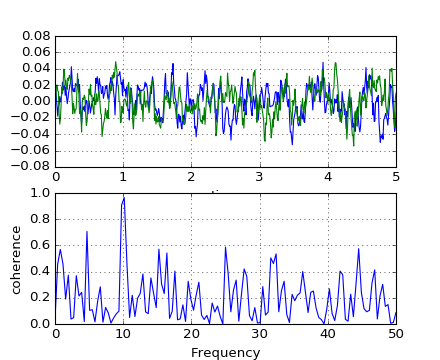
Notes
In addition to the above described arguments, this function can take a data keyword argument. If such a data argument is given, the following arguments are replaced by data[<arg>]:
- All arguments with the following names: ?y?, ?x?.
Additional kwargs: hold = [True|False] overrides default hold state
-
matplotlib.pyplot.colorbar(mappable=None, cax=None, ax=None, **kw) -
Add a colorbar to a plot.
Function signatures for the
pyplotinterface; all but the first are also method signatures for thecolorbar()method:colorbar(**kwargs) colorbar(mappable, **kwargs) colorbar(mappable, cax=cax, **kwargs) colorbar(mappable, ax=ax, **kwargs)
arguments:
- mappable
- the
Image,ContourSet, etc. to which the colorbar applies; this argument is mandatory for thecolorbar()method but optional for thecolorbar()function, which sets the default to the current image.
keyword arguments:
- cax
- None | axes object into which the colorbar will be drawn
- ax
- None | parent axes object(s) from which space for a new colorbar axes will be stolen. If a list of axes is given they will all be resized to make room for the colorbar axes.
- use_gridspec
- False | If cax is None, a new cax is created as an instance of Axes. If ax is an instance of Subplot and use_gridspec is True, cax is created as an instance of Subplot using the grid_spec module.
Additional keyword arguments are of two kinds:
axes properties:
Property Description orientation vertical or horizontal fraction 0.15; fraction of original axes to use for colorbar pad 0.05 if vertical, 0.15 if horizontal; fraction of original axes between colorbar and new image axes shrink 1.0; fraction by which to shrink the colorbar aspect 20; ratio of long to short dimensions anchor (0.0, 0.5) if vertical; (0.5, 1.0) if horizontal; the anchor point of the colorbar axes panchor (1.0, 0.5) if vertical; (0.5, 0.0) if horizontal; the anchor point of the colorbar parent axes. If False, the parent axes? anchor will be unchanged colorbar properties:
Property Description extend [ ?neither? | ?both? | ?min? | ?max? ] If not ?neither?, make pointed end(s) for out-of- range values. These are set for a given colormap using the colormap set_under and set_over methods. extendfrac [ None | ?auto? | length | lengths ] If set to None, both the minimum and maximum triangular colorbar extensions with have a length of 5% of the interior colorbar length (this is the default setting). If set to ?auto?, makes the triangular colorbar extensions the same lengths as the interior boxes (when spacing is set to ?uniform?) or the same lengths as the respective adjacent interior boxes (when spacing is set to ?proportional?). If a scalar, indicates the length of both the minimum and maximum triangular colorbar extensions as a fraction of the interior colorbar length. A two-element sequence of fractions may also be given, indicating the lengths of the minimum and maximum colorbar extensions respectively as a fraction of the interior colorbar length. extendrect [ False | True ] If False the minimum and maximum colorbar extensions will be triangular (the default). If True the extensions will be rectangular. spacing [ ?uniform? | ?proportional? ] Uniform spacing gives each discrete color the same space; proportional makes the space proportional to the data interval. ticks [ None | list of ticks | Locator object ] If None, ticks are determined automatically from the input. format [ None | format string | Formatter object ] If None, the ScalarFormatteris used. If a format string is given, e.g., ?%.3f?, that is used. An alternativeFormatterobject may be given instead.drawedges [ False | True ] If true, draw lines at color boundaries. The following will probably be useful only in the context of indexed colors (that is, when the mappable has norm=NoNorm()), or other unusual circumstances.
Property Description boundaries None or a sequence values None or a sequence which must be of length 1 less than the sequence of boundaries. For each region delimited by adjacent entries in boundaries, the color mapped to the corresponding value in values will be used. If mappable is a
ContourSet, its extend kwarg is included automatically.Note that the shrink kwarg provides a simple way to keep a vertical colorbar, for example, from being taller than the axes of the mappable to which the colorbar is attached; but it is a manual method requiring some trial and error. If the colorbar is too tall (or a horizontal colorbar is too wide) use a smaller value of shrink.
For more precise control, you can manually specify the positions of the axes objects in which the mappable and the colorbar are drawn. In this case, do not use any of the axes properties kwargs.
It is known that some vector graphics viewer (svg and pdf) renders white gaps between segments of the colorbar. This is due to bugs in the viewers not matplotlib. As a workaround the colorbar can be rendered with overlapping segments:
cbar = colorbar() cbar.solids.set_edgecolor("face") draw()However this has negative consequences in other circumstances. Particularly with semi transparent images (alpha < 1) and colorbar extensions and is not enabled by default see (issue #1188).
- returns:
-
Colorbarinstance; see also its base class,ColorbarBase. Call theset_label()method to label the colorbar.
-
matplotlib.pyplot.colors() -
This is a do-nothing function to provide you with help on how matplotlib handles colors.
Commands which take color arguments can use several formats to specify the colors. For the basic built-in colors, you can use a single letter
Alias Color ?b? blue ?g? green ?r? red ?c? cyan ?m? magenta ?y? yellow ?k? black ?w? white For a greater range of colors, you have two options. You can specify the color using an html hex string, as in:
color = '#eeefff'
or you can pass an R,G,B tuple, where each of R,G,B are in the range [0,1].
You can also use any legal html name for a color, for example:
color = 'red' color = 'burlywood' color = 'chartreuse'
The example below creates a subplot with a dark slate gray background:
subplot(111, axisbg=(0.1843, 0.3098, 0.3098))
Here is an example that creates a pale turquoise title:
title('Is this the best color?', color='#afeeee')
-
matplotlib.pyplot.connect(s, func) -
Connect event with string s to func. The signature of func is:
def func(event)
where event is a
matplotlib.backend_bases.Event. The following events are recognized- ?button_press_event?
- ?button_release_event?
- ?draw_event?
- ?key_press_event?
- ?key_release_event?
- ?motion_notify_event?
- ?pick_event?
- ?resize_event?
- ?scroll_event?
- ?figure_enter_event?,
- ?figure_leave_event?,
- ?axes_enter_event?,
- ?axes_leave_event?
- ?close_event?
For the location events (button and key press/release), if the mouse is over the axes, the variable
event.inaxeswill be set to theAxesthe event occurs is over, and additionally, the variablesevent.xdataandevent.ydatawill be defined. This is the mouse location in data coords. SeeKeyEventandMouseEventfor more info.Return value is a connection id that can be used with
mpl_disconnect().Example usage:
def on_press(event): print('you pressed', event.button, event.xdata, event.ydata) cid = canvas.mpl_connect('button_press_event', on_press)
-
matplotlib.pyplot.contour(*args, **kwargs) -
Plot contours.
contour()andcontourf()draw contour lines and filled contours, respectively. Except as noted, function signatures and return values are the same for both versions.contourf()differs from the MATLAB version in that it does not draw the polygon edges. To draw edges, add line contours with calls tocontour().Call signatures:
contour(Z)
make a contour plot of an array Z. The level values are chosen automatically.
contour(X,Y,Z)
X, Y specify the (x, y) coordinates of the surface
contour(Z,N) contour(X,Y,Z,N)
contour up to N automatically-chosen levels.
contour(Z,V) contour(X,Y,Z,V)
draw contour lines at the values specified in sequence V, which must be in increasing order.
contourf(..., V)
fill the
len(V)-1regions between the values in V, which must be in increasing order.contour(Z, **kwargs)
Use keyword args to control colors, linewidth, origin, cmap ... see below for more details.
X and Y must both be 2-D with the same shape as Z, or they must both be 1-D such that
len(X)is the number of columns in Z andlen(Y)is the number of rows in Z.C = contour(...)returns aQuadContourSetobject.Optional keyword arguments:
- corner_mask: [ True | False | ?legacy? ]
-
Enable/disable corner masking, which only has an effect if Z is a masked array. If False, any quad touching a masked point is masked out. If True, only the triangular corners of quads nearest those points are always masked out, other triangular corners comprising three unmasked points are contoured as usual. If ?legacy?, the old contouring algorithm is used, which is equivalent to False and is deprecated, only remaining whilst the new algorithm is tested fully.
If not specified, the default is taken from rcParams[?contour.corner_mask?], which is True unless it has been modified.
- colors: [ None | string | (mpl_colors) ]
-
If None, the colormap specified by cmap will be used.
If a string, like ?r? or ?red?, all levels will be plotted in this color.
If a tuple of matplotlib color args (string, float, rgb, etc), different levels will be plotted in different colors in the order specified.
- alpha: float
- The alpha blending value
- cmap: [ None | Colormap ]
- A cm
Colormapinstance or None. If cmap is None and colors is None, a default Colormap is used. - norm: [ None | Normalize ]
- A
matplotlib.colors.Normalizeinstance for scaling data values to colors. If norm is None and colors is None, the default linear scaling is used. - vmin, vmax: [ None | scalar ]
- If not None, either or both of these values will be supplied to the
matplotlib.colors.Normalizeinstance, overriding the default color scaling based on levels. - levels: [level0, level1, ..., leveln]
- A list of floating point numbers indicating the level curves to draw, in increasing order; e.g., to draw just the zero contour pass
levels=[0] - origin: [ None | ?upper? | ?lower? | ?image? ]
-
If None, the first value of Z will correspond to the lower left corner, location (0,0). If ?image?, the rc value for
image.originwill be used.This keyword is not active if X and Y are specified in the call to contour.
extent: [ None | (x0,x1,y0,y1) ]
If origin is not None, then extent is interpreted as in
matplotlib.pyplot.imshow(): it gives the outer pixel boundaries. In this case, the position of Z[0,0] is the center of the pixel, not a corner. If origin is None, then (x0, y0) is the position of Z[0,0], and (x1, y1) is the position of Z[-1,-1].This keyword is not active if X and Y are specified in the call to contour.
- locator: [ None | ticker.Locator subclass ]
- If locator is None, the default
MaxNLocatoris used. The locator is used to determine the contour levels if they are not given explicitly via the V argument. - extend: [ ?neither? | ?both? | ?min? | ?max? ]
- Unless this is ?neither?, contour levels are automatically added to one or both ends of the range so that all data are included. These added ranges are then mapped to the special colormap values which default to the ends of the colormap range, but can be set via
matplotlib.colors.Colormap.set_under()andmatplotlib.colors.Colormap.set_over()methods. - xunits, yunits: [ None | registered units ]
- Override axis units by specifying an instance of a
matplotlib.units.ConversionInterface. - antialiased: [ True | False ]
- enable antialiasing, overriding the defaults. For filled contours, the default is True. For line contours, it is taken from rcParams[?lines.antialiased?].
- nchunk: [ 0 | integer ]
- If 0, no subdivision of the domain. Specify a positive integer to divide the domain into subdomains of nchunk by nchunk quads. Chunking reduces the maximum length of polygons generated by the contouring algorithm which reduces the rendering workload passed on to the backend and also requires slightly less RAM. It can however introduce rendering artifacts at chunk boundaries depending on the backend, the antialiased flag and value of alpha.
contour-only keyword arguments:
- linewidths: [ None | number | tuple of numbers ]
-
If linewidths is None, the default width in
lines.linewidthinmatplotlibrcis used.If a number, all levels will be plotted with this linewidth.
If a tuple, different levels will be plotted with different linewidths in the order specified.
- linestyles: [ None | ?solid? | ?dashed? | ?dashdot? | ?dotted? ]
-
If linestyles is None, the default is ?solid? unless the lines are monochrome. In that case, negative contours will take their linestyle from the
matplotlibrccontour.negative_linestylesetting.linestyles can also be an iterable of the above strings specifying a set of linestyles to be used. If this iterable is shorter than the number of contour levels it will be repeated as necessary.
contourf-only keyword arguments:
- hatches:
- A list of cross hatch patterns to use on the filled areas. If None, no hatching will be added to the contour. Hatching is supported in the PostScript, PDF, SVG and Agg backends only.
Note: contourf fills intervals that are closed at the top; that is, for boundaries z1 and z2, the filled region is:
z1 < z <= z2
There is one exception: if the lowest boundary coincides with the minimum value of the z array, then that minimum value will be included in the lowest interval.
Examples:
(Source code, png, hires.png, pdf)
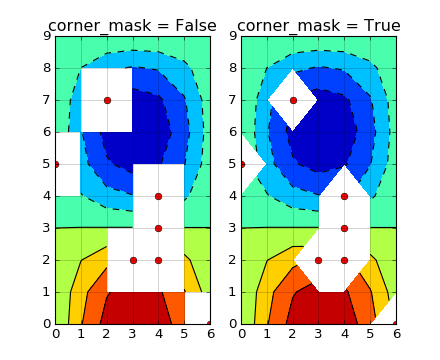
Additional kwargs: hold = [True|False] overrides default hold state
-
matplotlib.pyplot.contourf(*args, **kwargs) -
Plot contours.
contour()andcontourf()draw contour lines and filled contours, respectively. Except as noted, function signatures and return values are the same for both versions.contourf()differs from the MATLAB version in that it does not draw the polygon edges. To draw edges, add line contours with calls tocontour().Call signatures:
contour(Z)
make a contour plot of an array Z. The level values are chosen automatically.
contour(X,Y,Z)
X, Y specify the (x, y) coordinates of the surface
contour(Z,N) contour(X,Y,Z,N)
contour up to N automatically-chosen levels.
contour(Z,V) contour(X,Y,Z,V)
draw contour lines at the values specified in sequence V, which must be in increasing order.
contourf(..., V)
fill the
len(V)-1regions between the values in V, which must be in increasing order.contour(Z, **kwargs)
Use keyword args to control colors, linewidth, origin, cmap ... see below for more details.
X and Y must both be 2-D with the same shape as Z, or they must both be 1-D such that
len(X)is the number of columns in Z andlen(Y)is the number of rows in Z.C = contour(...)returns aQuadContourSetobject.Optional keyword arguments:
- corner_mask: [ True | False | ?legacy? ]
-
Enable/disable corner masking, which only has an effect if Z is a masked array. If False, any quad touching a masked point is masked out. If True, only the triangular corners of quads nearest those points are always masked out, other triangular corners comprising three unmasked points are contoured as usual. If ?legacy?, the old contouring algorithm is used, which is equivalent to False and is deprecated, only remaining whilst the new algorithm is tested fully.
If not specified, the default is taken from rcParams[?contour.corner_mask?], which is True unless it has been modified.
- colors: [ None | string | (mpl_colors) ]
-
If None, the colormap specified by cmap will be used.
If a string, like ?r? or ?red?, all levels will be plotted in this color.
If a tuple of matplotlib color args (string, float, rgb, etc), different levels will be plotted in different colors in the order specified.
- alpha: float
- The alpha blending value
- cmap: [ None | Colormap ]
- A cm
Colormapinstance or None. If cmap is None and colors is None, a default Colormap is used. - norm: [ None | Normalize ]
- A
matplotlib.colors.Normalizeinstance for scaling data values to colors. If norm is None and colors is None, the default linear scaling is used. - vmin, vmax: [ None | scalar ]
- If not None, either or both of these values will be supplied to the
matplotlib.colors.Normalizeinstance, overriding the default color scaling based on levels. - levels: [level0, level1, ..., leveln]
- A list of floating point numbers indicating the level curves to draw, in increasing order; e.g., to draw just the zero contour pass
levels=[0] - origin: [ None | ?upper? | ?lower? | ?image? ]
-
If None, the first value of Z will correspond to the lower left corner, location (0,0). If ?image?, the rc value for
image.originwill be used.This keyword is not active if X and Y are specified in the call to contour.
extent: [ None | (x0,x1,y0,y1) ]
If origin is not None, then extent is interpreted as in
matplotlib.pyplot.imshow(): it gives the outer pixel boundaries. In this case, the position of Z[0,0] is the center of the pixel, not a corner. If origin is None, then (x0, y0) is the position of Z[0,0], and (x1, y1) is the position of Z[-1,-1].This keyword is not active if X and Y are specified in the call to contour.
- locator: [ None | ticker.Locator subclass ]
- If locator is None, the default
MaxNLocatoris used. The locator is used to determine the contour levels if they are not given explicitly via the V argument. - extend: [ ?neither? | ?both? | ?min? | ?max? ]
- Unless this is ?neither?, contour levels are automatically added to one or both ends of the range so that all data are included. These added ranges are then mapped to the special colormap values which default to the ends of the colormap range, but can be set via
matplotlib.colors.Colormap.set_under()andmatplotlib.colors.Colormap.set_over()methods. - xunits, yunits: [ None | registered units ]
- Override axis units by specifying an instance of a
matplotlib.units.ConversionInterface. - antialiased: [ True | False ]
- enable antialiasing, overriding the defaults. For filled contours, the default is True. For line contours, it is taken from rcParams[?lines.antialiased?].
- nchunk: [ 0 | integer ]
- If 0, no subdivision of the domain. Specify a positive integer to divide the domain into subdomains of nchunk by nchunk quads. Chunking reduces the maximum length of polygons generated by the contouring algorithm which reduces the rendering workload passed on to the backend and also requires slightly less RAM. It can however introduce rendering artifacts at chunk boundaries depending on the backend, the antialiased flag and value of alpha.
contour-only keyword arguments:
- linewidths: [ None | number | tuple of numbers ]
-
If linewidths is None, the default width in
lines.linewidthinmatplotlibrcis used.If a number, all levels will be plotted with this linewidth.
If a tuple, different levels will be plotted with different linewidths in the order specified.
- linestyles: [ None | ?solid? | ?dashed? | ?dashdot? | ?dotted? ]
-
If linestyles is None, the default is ?solid? unless the lines are monochrome. In that case, negative contours will take their linestyle from the
matplotlibrccontour.negative_linestylesetting.linestyles can also be an iterable of the above strings specifying a set of linestyles to be used. If this iterable is shorter than the number of contour levels it will be repeated as necessary.
contourf-only keyword arguments:
- hatches:
- A list of cross hatch patterns to use on the filled areas. If None, no hatching will be added to the contour. Hatching is supported in the PostScript, PDF, SVG and Agg backends only.
Note: contourf fills intervals that are closed at the top; that is, for boundaries z1 and z2, the filled region is:
z1 < z <= z2
There is one exception: if the lowest boundary coincides with the minimum value of the z array, then that minimum value will be included in the lowest interval.
Examples:
(Source code, png, hires.png, pdf)

Additional kwargs: hold = [True|False] overrides default hold state
-
matplotlib.pyplot.cool() -
set the default colormap to cool and apply to current image if any. See help(colormaps) for more information
-
matplotlib.pyplot.copper() -
set the default colormap to copper and apply to current image if any. See help(colormaps) for more information
-
matplotlib.pyplot.csd(x, y, NFFT=None, Fs=None, Fc=None, detrend=None, window=None, noverlap=None, pad_to=None, sides=None, scale_by_freq=None, return_line=None, hold=None, data=None, **kwargs) -
Plot the cross-spectral density.
Call signature:
csd(x, y, NFFT=256, Fs=2, Fc=0, detrend=mlab.detrend_none, window=mlab.window_hanning, noverlap=0, pad_to=None, sides='default', scale_by_freq=None, return_line=None, **kwargs)The cross spectral density
 by Welch?s average periodogram method. The vectors x and y are divided into NFFT length segments. Each segment is detrended by function detrend and windowed by function window. noverlap gives the length of the overlap between segments. The product of the direct FFTs of x and y are averaged over each segment to compute
by Welch?s average periodogram method. The vectors x and y are divided into NFFT length segments. Each segment is detrended by function detrend and windowed by function window. noverlap gives the length of the overlap between segments. The product of the direct FFTs of x and y are averaged over each segment to compute  , with a scaling to correct for power loss due to windowing.
, with a scaling to correct for power loss due to windowing.If len(x) < NFFT or len(y) < NFFT, they will be zero padded to NFFT.
- x, y: 1-D arrays or sequences
- Arrays or sequences containing the data
Keyword arguments:
- Fs: scalar
- The sampling frequency (samples per time unit). It is used to calculate the Fourier frequencies, freqs, in cycles per time unit. The default value is 2.
- window: callable or ndarray
- A function or a vector of length NFFT. To create window vectors see
window_hanning(),window_none(),numpy.blackman(),numpy.hamming(),numpy.bartlett(),scipy.signal(),scipy.signal.get_window(), etc. The default iswindow_hanning(). If a function is passed as the argument, it must take a data segment as an argument and return the windowed version of the segment. - sides: [ ?default? | ?onesided? | ?twosided? ]
- Specifies which sides of the spectrum to return. Default gives the default behavior, which returns one-sided for real data and both for complex data. ?onesided? forces the return of a one-sided spectrum, while ?twosided? forces two-sided.
- pad_to: integer
- The number of points to which the data segment is padded when performing the FFT. This can be different from NFFT, which specifies the number of data points used. While not increasing the actual resolution of the spectrum (the minimum distance between resolvable peaks), this can give more points in the plot, allowing for more detail. This corresponds to the n parameter in the call to fft(). The default is None, which sets pad_to equal to NFFT
- NFFT: integer
- The number of data points used in each block for the FFT. A power 2 is most efficient. The default value is 256. This should NOT be used to get zero padding, or the scaling of the result will be incorrect. Use pad_to for this instead.
- detrend: [ ?default? | ?constant? | ?mean? | ?linear? | ?none?] or
- callable
The function applied to each segment before fft-ing, designed to remove the mean or linear trend. Unlike in MATLAB, where the detrend parameter is a vector, in matplotlib is it a function. The
pylabmodule definesdetrend_none(),detrend_mean(), anddetrend_linear(), but you can use a custom function as well. You can also use a string to choose one of the functions. ?default?, ?constant?, and ?mean? calldetrend_mean(). ?linear? callsdetrend_linear(). ?none? callsdetrend_none(). - scale_by_freq: boolean
- Specifies whether the resulting density values should be scaled by the scaling frequency, which gives density in units of Hz^-1. This allows for integration over the returned frequency values. The default is True for MATLAB compatibility.
- noverlap: integer
- The number of points of overlap between segments. The default value is 0 (no overlap).
- Fc: integer
- The center frequency of x (defaults to 0), which offsets the x extents of the plot to reflect the frequency range used when a signal is acquired and then filtered and downsampled to baseband.
- return_line: bool
- Whether to include the line object plotted in the returned values. Default is False.
If return_line is False, returns the tuple (Pxy, freqs). If return_line is True, returns the tuple (Pxy, freqs. line):
- Pxy: 1-D array
- The values for the cross spectrum
P_{xy}before scaling (complex valued) - freqs: 1-D array
- The frequencies corresponding to the elements in Pxy
-
line: a Line2D instance - The line created by this function. Only returend if return_line is True.
For plotting, the power is plotted as
 for decibels, though
for decibels, though P_{xy}itself is returned.- References:
- Bendat & Piersol ? Random Data: Analysis and Measurement Procedures, John Wiley & Sons (1986)
kwargs control the Line2D properties:
Property Description agg_filterunknown alphafloat (0.0 transparent through 1.0 opaque) animated[True | False] antialiasedor aa[True | False] axesan Axesinstanceclip_boxa matplotlib.transforms.Bboxinstanceclip_on[True | False] clip_path[ ( Path,Transform) |Patch| None ]coloror cany matplotlib color containsa callable function dash_capstyle[?butt? | ?round? | ?projecting?] dash_joinstyle[?miter? | ?round? | ?bevel?] dashessequence of on/off ink in points drawstyle[?default? | ?steps? | ?steps-pre? | ?steps-mid? | ?steps-post?] figurea matplotlib.figure.Figureinstancefillstyle[?full? | ?left? | ?right? | ?bottom? | ?top? | ?none?] gidan id string labelstring or anything printable with ?%s? conversion. linestyleor ls[?solid? | ?dashed?, ?dashdot?, ?dotted? | (offset, on-off-dash-seq) | '-'|'--'|'-.'|':'|'None'|' '|'']linewidthor lwfloat value in points markerA valid marker stylemarkeredgecoloror mecany matplotlib color markeredgewidthor mewfloat value in points markerfacecoloror mfcany matplotlib color markerfacecoloraltor mfcaltany matplotlib color markersizeor msfloat markevery[None | int | length-2 tuple of int | slice | list/array of int | float | length-2 tuple of float] path_effectsunknown pickerfloat distance in points or callable pick function fn(artist, event)pickradiusfloat distance in points rasterized[True | False | None] sketch_paramsunknown snapunknown solid_capstyle[?butt? | ?round? | ?projecting?] solid_joinstyle[?miter? | ?round? | ?bevel?] transforma matplotlib.transforms.Transforminstanceurla url string visible[True | False] xdata1D array ydata1D array zorderany number Example:
(Source code, png, hires.png, pdf)
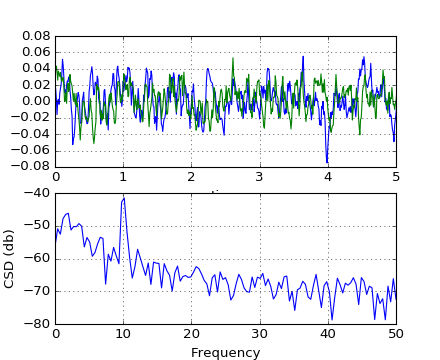
Notes
In addition to the above described arguments, this function can take a data keyword argument. If such a data argument is given, the following arguments are replaced by data[<arg>]:
- All arguments with the following names: ?y?, ?x?.
Additional kwargs: hold = [True|False] overrides default hold state
-
matplotlib.pyplot.delaxes(*args) -
Remove an axes from the current figure. If ax doesn?t exist, an error will be raised.
delaxes(): delete the current axes
-
matplotlib.pyplot.disconnect(cid) -
Disconnect callback id cid
Example usage:
cid = canvas.mpl_connect('button_press_event', on_press) #...later canvas.mpl_disconnect(cid)
-
matplotlib.pyplot.draw() -
Redraw the current figure.
This is used in interactive mode to update a figure that has been altered, but not automatically re-drawn. This should be only rarely needed, but there may be ways to modify the state of a figure with out marking it as
stale. Please report these cases as bugs.A more object-oriented alternative, given any
Figureinstance,fig, that was created using apyplotfunction, is:fig.canvas.draw_idle()
-
matplotlib.pyplot.errorbar(x, y, yerr=None, xerr=None, fmt='', ecolor=None, elinewidth=None, capsize=None, barsabove=False, lolims=False, uplims=False, xlolims=False, xuplims=False, errorevery=1, capthick=None, hold=None, data=None, **kwargs) -
Plot an errorbar graph.
Call signature:
errorbar(x, y, yerr=None, xerr=None, fmt='', ecolor=None, elinewidth=None, capsize=None, barsabove=False, lolims=False, uplims=False, xlolims=False, xuplims=False, errorevery=1, capthick=None)Plot x versus y with error deltas in yerr and xerr. Vertical errorbars are plotted if yerr is not None. Horizontal errorbars are plotted if xerr is not None.
x, y, xerr, and yerr can all be scalars, which plots a single error bar at x, y.
Optional keyword arguments:
- xerr/yerr: [ scalar | N, Nx1, or 2xN array-like ]
-
If a scalar number, len(N) array-like object, or an Nx1 array-like object, errorbars are drawn at +/-value relative to the data.
If a sequence of shape 2xN, errorbars are drawn at -row1 and +row2 relative to the data.
- fmt: [ ?? | ?none? | plot format string ]
- The plot format symbol. If fmt is ?none? (case-insensitive), only the errorbars are plotted. This is used for adding errorbars to a bar plot, for example. Default is ??, an empty plot format string; properties are then identical to the defaults for
plot(). - ecolor: [ None | mpl color ]
- A matplotlib color arg which gives the color the errorbar lines; if None, use the color of the line connecting the markers.
- elinewidth: scalar
- The linewidth of the errorbar lines. If None, use the linewidth.
- capsize: scalar
- The length of the error bar caps in points; if None, it will take the value from
errorbar.capsizercParam. - capthick: scalar
- An alias kwarg to markeredgewidth (a.k.a. - mew). This setting is a more sensible name for the property that controls the thickness of the error bar cap in points. For backwards compatibility, if mew or markeredgewidth are given, then they will over-ride capthick. This may change in future releases.
- barsabove: [ True | False ]
- if True, will plot the errorbars above the plot symbols. Default is below.
- lolims / uplims / xlolims / xuplims: [ False | True ]
- These arguments can be used to indicate that a value gives only upper/lower limits. In that case a caret symbol is used to indicate this. lims-arguments may be of the same type as xerr and yerr. To use limits with inverted axes,
set_xlim()orset_ylim()must be called beforeerrorbar(). - errorevery: positive integer
- subsamples the errorbars. e.g., if errorevery=5, errorbars for every 5-th datapoint will be plotted. The data plot itself still shows all data points.
All other keyword arguments are passed on to the plot command for the markers. For example, this code makes big red squares with thick green edges:
x,y,yerr = rand(3,10) errorbar(x, y, yerr, marker='s', mfc='red', mec='green', ms=20, mew=4)where mfc, mec, ms and mew are aliases for the longer property names, markerfacecolor, markeredgecolor, markersize and markeredgewith.
valid kwargs for the marker properties are
Property Description agg_filterunknown alphafloat (0.0 transparent through 1.0 opaque) animated[True | False] antialiasedor aa[True | False] axesan Axesinstanceclip_boxa matplotlib.transforms.Bboxinstanceclip_on[True | False] clip_path[ ( Path,Transform) |Patch| None ]coloror cany matplotlib color containsa callable function dash_capstyle[?butt? | ?round? | ?projecting?] dash_joinstyle[?miter? | ?round? | ?bevel?] dashessequence of on/off ink in points drawstyle[?default? | ?steps? | ?steps-pre? | ?steps-mid? | ?steps-post?] figurea matplotlib.figure.Figureinstancefillstyle[?full? | ?left? | ?right? | ?bottom? | ?top? | ?none?] gidan id string labelstring or anything printable with ?%s? conversion. linestyleor ls[?solid? | ?dashed?, ?dashdot?, ?dotted? | (offset, on-off-dash-seq) | '-'|'--'|'-.'|':'|'None'|' '|'']linewidthor lwfloat value in points markerA valid marker stylemarkeredgecoloror mecany matplotlib color markeredgewidthor mewfloat value in points markerfacecoloror mfcany matplotlib color markerfacecoloraltor mfcaltany matplotlib color markersizeor msfloat markevery[None | int | length-2 tuple of int | slice | list/array of int | float | length-2 tuple of float] path_effectsunknown pickerfloat distance in points or callable pick function fn(artist, event)pickradiusfloat distance in points rasterized[True | False | None] sketch_paramsunknown snapunknown solid_capstyle[?butt? | ?round? | ?projecting?] solid_joinstyle[?miter? | ?round? | ?bevel?] transforma matplotlib.transforms.Transforminstanceurla url string visible[True | False] xdata1D array ydata1D array zorderany number Returns (plotline, caplines, barlinecols):
-
plotline: Line2D instance - x, y plot markers and/or line
- caplines: list of error bar cap
-
Line2Dinstances - barlinecols: list of
-
LineCollectioninstances for the horizontal and vertical error ranges.
Example:
(Source code, png, hires.png, pdf)
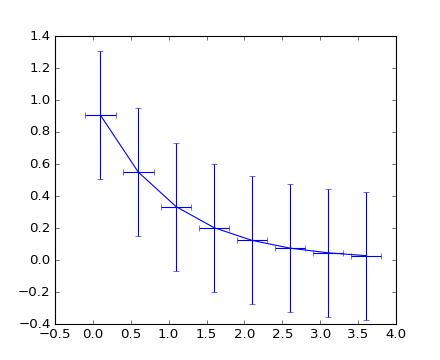
Notes
In addition to the above described arguments, this function can take a data keyword argument. If such a data argument is given, the following arguments are replaced by data[<arg>]:
- All arguments with the following names: ?xerr?, ?y?, ?yerr?, ?x?.
Additional kwargs: hold = [True|False] overrides default hold state
-
matplotlib.pyplot.eventplot(positions, orientation='horizontal', lineoffsets=1, linelengths=1, linewidths=None, colors=None, linestyles='solid', hold=None, data=None, **kwargs) -
Plot identical parallel lines at specific positions.
Call signature:
eventplot(positions, orientation='horizontal', lineoffsets=0, linelengths=1, linewidths=None, color =None, linestyles='solid'Plot parallel lines at the given positions. positions should be a 1D or 2D array-like object, with each row corresponding to a row or column of lines.
This type of plot is commonly used in neuroscience for representing neural events, where it is commonly called a spike raster, dot raster, or raster plot.
However, it is useful in any situation where you wish to show the timing or position of multiple sets of discrete events, such as the arrival times of people to a business on each day of the month or the date of hurricanes each year of the last century.
- orientation
- ?horizonal? : the lines will be vertical and arranged in rows ?vertical? : lines will be horizontal and arranged in columns
- lineoffsets :
- A float or array-like containing floats.
- linelengths :
- A float or array-like containing floats.
- linewidths :
- A float or array-like containing floats.
- colors
- must be a sequence of RGBA tuples (e.g., arbitrary color strings, etc, not allowed) or a list of such sequences
- linestyles :
- [ ?solid? | ?dashed? | ?dashdot? | ?dotted? ] or an array of these values
For linelengths, linewidths, colors, and linestyles, if only a single value is given, that value is applied to all lines. If an array-like is given, it must have the same length as positions, and each value will be applied to the corresponding row or column in positions.
Returns a list of matplotlib.collections.EventCollection objects that were added.
kwargs are LineCollection properties:
| Property | Description |
|---|---|
agg_filter | unknown |
alpha | float or None |
animated | [True | False] |
antialiased or antialiaseds | Boolean or sequence of booleans |
array | unknown |
axes | an Axes instance |
clim | a length 2 sequence of floats |
clip_box | a matplotlib.transforms.Bbox instance |
clip_on | [True | False] |
clip_path | [ (Path, Transform) | Patch | None ] |
cmap | a colormap or registered colormap name |
color | matplotlib color arg or sequence of rgba tuples |
contains | a callable function |
edgecolor or edgecolors | matplotlib color spec or sequence of specs |
facecolor or facecolors | matplotlib color spec or sequence of specs |
figure | a matplotlib.figure.Figure instance |
gid | an id string |
hatch | [ ?/? | ?\? | ?|? | ?-? | ?+? | ?x? | ?o? | ?O? | ?.? | ?*? ] |
label | string or anything printable with ?%s? conversion. |
linestyle or linestyles or dashes | [?solid? | ?dashed?, ?dashdot?, ?dotted? | (offset, on-off-dash-seq) | '-' | '--' | '-.' | ':' | 'None' | ' ' | ''] |
linewidth or linewidths or lw | float or sequence of floats |
norm | unknown |
offset_position | unknown |
offsets | float or sequence of floats |
path_effects | unknown |
paths | unknown |
picker | [None|float|boolean|callable] |
pickradius | unknown |
rasterized | [True | False | None] |
segments | unknown |
sketch_params | unknown |
snap | unknown |
transform |
Transform instance |
url | a url string |
urls | unknown |
verts | unknown |
visible | [True | False] |
zorder | any number |
Example:
(Source code, png, hires.png, pdf)
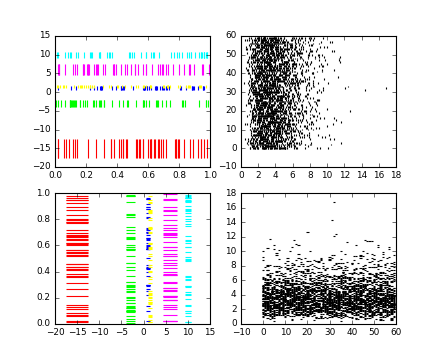
Notes
In addition to the above described arguments, this function can take a data keyword argument. If such a data argument is given, the following arguments are replaced by data[<arg>]:
- All arguments with the following names: ?linewidths?, ?linelengths?, ?lineoffsets?, ?colors?, ?positions?, ?linestyles?.
Additional kwargs: hold = [True|False] overrides default hold state
-
matplotlib.pyplot.figimage(*args, **kwargs) -
Adds a non-resampled image to the figure.
call signatures:
figimage(X, **kwargs)
adds a non-resampled array X to the figure.
figimage(X, xo, yo)
with pixel offsets xo, yo,
X must be a float array:
- If X is MxN, assume luminance (grayscale)
- If X is MxNx3, assume RGB
- If X is MxNx4, assume RGBA
Optional keyword arguments:
Keyword Description resize a boolean, True or False. If ?True?, then re-size the Figure to match the given image size. xo or yo An integer, the x and y image offset in pixels cmap a matplotlib.colors.Colormapinstance, e.g., cm.jet. If None, default to the rcimage.cmapvaluenorm a matplotlib.colors.Normalizeinstance. The default is normalization(). This scales luminance -> 0-1vmin|vmax are used to scale a luminance image to 0-1. If either is None, the min and max of the luminance values will be used. Note if you pass a norm instance, the settings for vmin and vmax will be ignored. alpha the alpha blending value, default is None origin [ ?upper? | ?lower? ] Indicates where the [0,0] index of the array is in the upper left or lower left corner of the axes. Defaults to the rc image.origin value figimage complements the axes image (
imshow()) which will be resampled to fit the current axes. If you want a resampled image to fill the entire figure, you can define anAxeswith size [0,1,0,1].An
matplotlib.image.FigureImageinstance is returned.(Source code, png, hires.png, pdf)
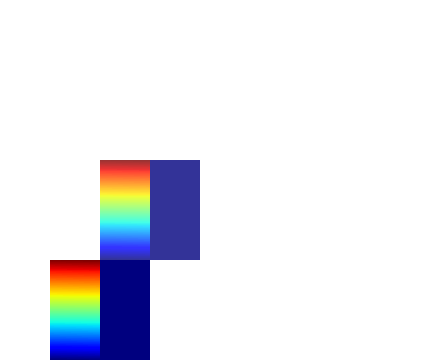
Additional kwargs are Artist kwargs passed on to
FigureImageAddition kwargs: hold = [True|False] overrides default hold state
-
matplotlib.pyplot.figlegend(handles, labels, loc, **kwargs) -
Place a legend in the figure.
- labels
- a sequence of strings
- handles
- a sequence of
Line2DorPatchinstances - loc
- can be a string or an integer specifying the legend location
A
matplotlib.legend.Legendinstance is returned.Example:
figlegend( (line1, line2, line3), ('label1', 'label2', 'label3'), 'upper right' )See also
-
matplotlib.pyplot.fignum_exists(num)
-
matplotlib.pyplot.figtext(*args, **kwargs) -
Add text to figure.
Call signature:
text(x, y, s, fontdict=None, **kwargs)
Add text to figure at location x, y (relative 0-1 coords). See
text()for the meaning of the other arguments.kwargs control the
Textproperties:Property Description agg_filterunknown alphafloat (0.0 transparent through 1.0 opaque) animated[True | False] axesan Axesinstancebackgroundcolorany matplotlib color bboxFancyBboxPatch prop dict clip_boxa matplotlib.transforms.Bboxinstanceclip_on[True | False] clip_path[ ( Path,Transform) |Patch| None ]colorany matplotlib color containsa callable function familyor fontname or fontfamily or name[FONTNAME | ?serif? | ?sans-serif? | ?cursive? | ?fantasy? | ?monospace? ] figurea matplotlib.figure.Figureinstancefontpropertiesor font_propertiesa matplotlib.font_manager.FontPropertiesinstancegidan id string horizontalalignmentor ha[ ?center? | ?right? | ?left? ] labelstring or anything printable with ?%s? conversion. linespacingfloat (multiple of font size) multialignment[?left? | ?right? | ?center? ] path_effectsunknown picker[None|float|boolean|callable] position(x,y) rasterized[True | False | None] rotation[ angle in degrees | ?vertical? | ?horizontal? ] rotation_modeunknown sizeor fontsize[size in points | ?xx-small? | ?x-small? | ?small? | ?medium? | ?large? | ?x-large? | ?xx-large? ] sketch_paramsunknown snapunknown stretchor fontstretch[a numeric value in range 0-1000 | ?ultra-condensed? | ?extra-condensed? | ?condensed? | ?semi-condensed? | ?normal? | ?semi-expanded? | ?expanded? | ?extra-expanded? | ?ultra-expanded? ] styleor fontstyle[ ?normal? | ?italic? | ?oblique?] textstring or anything printable with ?%s? conversion. transformTransforminstanceurla url string usetexunknown variantor fontvariant[ ?normal? | ?small-caps? ] verticalalignmentor ma or va[ ?center? | ?top? | ?bottom? | ?baseline? ] visible[True | False] weightor fontweight[a numeric value in range 0-1000 | ?ultralight? | ?light? | ?normal? | ?regular? | ?book? | ?medium? | ?roman? | ?semibold? | ?demibold? | ?demi? | ?bold? | ?heavy? | ?extra bold? | ?black? ] wrapunknown xfloat yfloat zorderany number
-
matplotlib.pyplot.figure(num=None, figsize=None, dpi=None, facecolor=None, edgecolor=None, frameon=True, FigureClass=, **kwargs) -
Creates a new figure.
Parameters: num : integer or string, optional, default: none
If not provided, a new figure will be created, and the figure number will be incremented. The figure objects holds this number in a
numberattribute. If num is provided, and a figure with this id already exists, make it active, and returns a reference to it. If this figure does not exists, create it and returns it. If num is a string, the window title will be set to this figure?snum.figsize : tuple of integers, optional, default: None
width, height in inches. If not provided, defaults to rc figure.figsize.
dpi : integer, optional, default: None
resolution of the figure. If not provided, defaults to rc figure.dpi.
facecolor :
the background color. If not provided, defaults to rc figure.facecolor
edgecolor :
the border color. If not provided, defaults to rc figure.edgecolor
Returns: figure : Figure
The Figure instance returned will also be passed to new_figure_manager in the backends, which allows to hook custom Figure classes into the pylab interface. Additional kwargs will be passed to the figure init function.
Notes
If you are creating many figures, make sure you explicitly call ?close? on the figures you are not using, because this will enable pylab to properly clean up the memory.
rcParams defines the default values, which can be modified in the matplotlibrc file
-
matplotlib.pyplot.fill(*args, **kwargs) -
Plot filled polygons.
Call signature:
fill(*args, **kwargs)
args is a variable length argument, allowing for multiple x, y pairs with an optional color format string; see
plot()for details on the argument parsing. For example, to plot a polygon with vertices at x, y in blue.:ax.fill(x,y, 'b' )
An arbitrary number of x, y, color groups can be specified:
ax.fill(x1, y1, 'g', x2, y2, 'r')
Return value is a list of
Patchinstances that were added.The same color strings that
plot()supports are supported by the fill format string.If you would like to fill below a curve, e.g., shade a region between 0 and y along x, use
fill_between()The closed kwarg will close the polygon when True (default).
kwargs control the
Polygonproperties:Property Description agg_filterunknown alphafloat or None animated[True | False] antialiasedor aa[True | False] or None for default axesan Axesinstancecapstyle[?butt? | ?round? | ?projecting?] clip_boxa matplotlib.transforms.Bboxinstanceclip_on[True | False] clip_path[ ( Path,Transform) |Patch| None ]colormatplotlib color spec containsa callable function edgecoloror ecmpl color spec, or None for default, or ?none? for no color facecoloror fcmpl color spec, or None for default, or ?none? for no color figurea matplotlib.figure.Figureinstancefill[True | False] gidan id string hatch[?/? | ?\? | ?|? | ?-? | ?+? | ?x? | ?o? | ?O? | ?.? | ?*?] joinstyle[?miter? | ?round? | ?bevel?] labelstring or anything printable with ?%s? conversion. linestyleor ls[?solid? | ?dashed?, ?dashdot?, ?dotted? | (offset, on-off-dash-seq) | '-'|'--'|'-.'|':'|'None'|' '|'']linewidthor lwfloat or None for default path_effectsunknown picker[None|float|boolean|callable] rasterized[True | False | None] sketch_paramsunknown snapunknown transformTransforminstanceurla url string visible[True | False] zorderany number Example:
(Source code, png, hires.png, pdf)
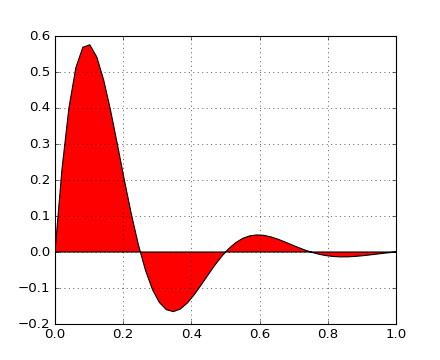
Notes
In addition to the above described arguments, this function can take a data keyword argument. If such a data argument is given, the following arguments are replaced by data[<arg>]:
- All arguments with the following names: ?y?, ?x?.
Additional kwargs: hold = [True|False] overrides default hold state
-
matplotlib.pyplot.fill_between(x, y1, y2=0, where=None, interpolate=False, step=None, hold=None, data=None, **kwargs) -
Make filled polygons between two curves.
Create a
PolyCollectionfilling the regions between y1 and y2 wherewhere==TrueParameters: x : array
An N-length array of the x data
y1 : array
An N-length array (or scalar) of the y data
y2 : array
An N-length array (or scalar) of the y data
where : array, optional
If
None, default to fill between everywhere. If notNone, it is an N-length numpy boolean array and the fill will only happen over the regions wherewhere==True.interpolate : bool, optional
If
True, interpolate between the two lines to find the precise point of intersection. Otherwise, the start and end points of the filled region will only occur on explicit values in the x array.step : {?pre?, ?post?, ?mid?}, optional
If not None, fill with step logic.
Notes
In addition to the above described arguments, this function can take a data keyword argument. If such a data argument is given, the following arguments are replaced by data[<arg>]:
- All arguments with the following names: ?y1?, ?x?, ?where?, ?y2?.
Additional kwargs: hold = [True|False] overrides default hold state
Examples
-
matplotlib.pyplot.fill_betweenx(y, x1, x2=0, where=None, step=None, hold=None, data=None, **kwargs) -
Make filled polygons between two horizontal curves.
Call signature:
fill_betweenx(y, x1, x2=0, where=None, **kwargs)
Create a
PolyCollectionfilling the regions between x1 and x2 wherewhere==TrueParameters: y : array
An N-length array of the y data
x1 : array
An N-length array (or scalar) of the x data
x2 : array, optional
An N-length array (or scalar) of the x data
where : array, optional
If None, default to fill between everywhere. If not None, it is a N length numpy boolean array and the fill will only happen over the regions where
where==Truestep : {?pre?, ?post?, ?mid?}, optional
If not None, fill with step logic.
Notes
In addition to the above described arguments, this function can take a data keyword argument. If such a data argument is given, the following arguments are replaced by data[<arg>]:
- All arguments with the following names: ?x2?, ?y?, ?where?, ?x1?.
Additional kwargs: hold = [True|False] overrides default hold state
Examples
-
matplotlib.pyplot.findobj(o=None, match=None, include_self=True) -
Find artist objects.
Recursively find all
Artistinstances contained in self.match can be
- None: return all objects contained in artist.
- function with signature
boolean = match(artist)used to filter matches - class instance: e.g., Line2D. Only return artists of class type.
If include_self is True (default), include self in the list to be checked for a match.
-
matplotlib.pyplot.flag() -
set the default colormap to flag and apply to current image if any. See help(colormaps) for more information
-
matplotlib.pyplot.gca(**kwargs) -
Get the current
Axesinstance on the current figure matching the given keyword args, or create one.See also
-
matplotlib.figure.Figure.gca - The figure?s gca method.
Examples
To get the current polar axes on the current figure:
plt.gca(projection='polar')
If the current axes doesn?t exist, or isn?t a polar one, the appropriate axes will be created and then returned.
-
-
matplotlib.pyplot.gcf() -
Get a reference to the current figure.
-
matplotlib.pyplot.gci() -
Get the current colorable artist. Specifically, returns the current
ScalarMappableinstance (image or patch collection), or None if no images or patch collections have been defined. The commandsimshow()andfigimage()createImageinstances, and the commandspcolor()andscatter()createCollectioninstances. The current image is an attribute of the current axes, or the nearest earlier axes in the current figure that contains an image.
-
matplotlib.pyplot.get_current_fig_manager()
-
matplotlib.pyplot.get_figlabels() -
Return a list of existing figure labels.
-
matplotlib.pyplot.get_fignums() -
Return a list of existing figure numbers.
-
matplotlib.pyplot.get_plot_commands() -
Get a sorted list of all of the plotting commands.
-
matplotlib.pyplot.ginput(*args, **kwargs) -
Call signature:
ginput(self, n=1, timeout=30, show_clicks=True, mouse_add=1, mouse_pop=3, mouse_stop=2)Blocking call to interact with the figure.
This will wait for n clicks from the user and return a list of the coordinates of each click.
If timeout is zero or negative, does not timeout.
If n is zero or negative, accumulate clicks until a middle click (or potentially both mouse buttons at once) terminates the input.
Right clicking cancels last input.
The buttons used for the various actions (adding points, removing points, terminating the inputs) can be overriden via the arguments mouse_add, mouse_pop and mouse_stop, that give the associated mouse button: 1 for left, 2 for middle, 3 for right.
The keyboard can also be used to select points in case your mouse does not have one or more of the buttons. The delete and backspace keys act like right clicking (i.e., remove last point), the enter key terminates input and any other key (not already used by the window manager) selects a point.
-
matplotlib.pyplot.gray() -
set the default colormap to gray and apply to current image if any. See help(colormaps) for more information
-
matplotlib.pyplot.grid(b=None, which='major', axis='both', **kwargs) -
Turn the axes grids on or off.
Call signature:
grid(self, b=None, which='major', axis='both', **kwargs)
Set the axes grids on or off; b is a boolean. (For MATLAB compatibility, b may also be a string, ?on? or ?off?.)
If b is None and
len(kwargs)==0, toggle the grid state. If kwargs are supplied, it is assumed that you want a grid and b is thus set to True.which can be ?major? (default), ?minor?, or ?both? to control whether major tick grids, minor tick grids, or both are affected.
axis can be ?both? (default), ?x?, or ?y? to control which set of gridlines are drawn.
kwargs are used to set the grid line properties, e.g.,:
ax.grid(color='r', linestyle='-', linewidth=2)
Valid
Line2Dkwargs areProperty Description agg_filterunknown alphafloat (0.0 transparent through 1.0 opaque) animated[True | False] antialiasedor aa[True | False] axesan Axesinstanceclip_boxa matplotlib.transforms.Bboxinstanceclip_on[True | False] clip_path[ ( Path,Transform) |Patch| None ]coloror cany matplotlib color containsa callable function dash_capstyle[?butt? | ?round? | ?projecting?] dash_joinstyle[?miter? | ?round? | ?bevel?] dashessequence of on/off ink in points drawstyle[?default? | ?steps? | ?steps-pre? | ?steps-mid? | ?steps-post?] figurea matplotlib.figure.Figureinstancefillstyle[?full? | ?left? | ?right? | ?bottom? | ?top? | ?none?] gidan id string labelstring or anything printable with ?%s? conversion. linestyleor ls[?solid? | ?dashed?, ?dashdot?, ?dotted? | (offset, on-off-dash-seq) | '-'|'--'|'-.'|':'|'None'|' '|'']linewidthor lwfloat value in points markerA valid marker stylemarkeredgecoloror mecany matplotlib color markeredgewidthor mewfloat value in points markerfacecoloror mfcany matplotlib color markerfacecoloraltor mfcaltany matplotlib color markersizeor msfloat markevery[None | int | length-2 tuple of int | slice | list/array of int | float | length-2 tuple of float] path_effectsunknown pickerfloat distance in points or callable pick function fn(artist, event)pickradiusfloat distance in points rasterized[True | False | None] sketch_paramsunknown snapunknown solid_capstyle[?butt? | ?round? | ?projecting?] solid_joinstyle[?miter? | ?round? | ?bevel?] transforma matplotlib.transforms.Transforminstanceurla url string visible[True | False] xdata1D array ydata1D array zorderany number
-
matplotlib.pyplot.hexbin(x, y, C=None, gridsize=100, bins=None, xscale='linear', yscale='linear', extent=None, cmap=None, norm=None, vmin=None, vmax=None, alpha=None, linewidths=None, edgecolors='none', reduce_C_function=, mincnt=None, marginals=False, hold=None, data=None, **kwargs) -
Make a hexagonal binning plot.
Call signature:
hexbin(x, y, C = None, gridsize = 100, bins = None, xscale = 'linear', yscale = 'linear', cmap=None, norm=None, vmin=None, vmax=None, alpha=None, linewidths=None, edgecolors='none' reduce_C_function = np.mean, mincnt=None, marginals=True **kwargs)Make a hexagonal binning plot of x versus y, where x, y are 1-D sequences of the same length, N. If C is None (the default), this is a histogram of the number of occurences of the observations at (x[i],y[i]).
If C is specified, it specifies values at the coordinate (x[i],y[i]). These values are accumulated for each hexagonal bin and then reduced according to reduce_C_function, which defaults to numpy?s mean function (np.mean). (If C is specified, it must also be a 1-D sequence of the same length as x and y.)
x, y and/or C may be masked arrays, in which case only unmasked points will be plotted.
Optional keyword arguments:
- gridsize: [ 100 | integer ]
- The number of hexagons in the x-direction, default is 100. The corresponding number of hexagons in the y-direction is chosen such that the hexagons are approximately regular. Alternatively, gridsize can be a tuple with two elements specifying the number of hexagons in the x-direction and the y-direction.
- bins: [ None | ?log? | integer | sequence ]
-
If None, no binning is applied; the color of each hexagon directly corresponds to its count value.
If ?log?, use a logarithmic scale for the color map. Internally,
 is used to determine the hexagon color.
is used to determine the hexagon color.If an integer, divide the counts in the specified number of bins, and color the hexagons accordingly.
If a sequence of values, the values of the lower bound of the bins to be used.
- xscale: [ ?linear? | ?log? ]
- Use a linear or log10 scale on the horizontal axis.
- scale: [ ?linear? | ?log? ]
- Use a linear or log10 scale on the vertical axis.
- mincnt: [ None | a positive integer ]
- If not None, only display cells with more than mincnt number of points in the cell
- marginals: [ True | False ]
- if marginals is True, plot the marginal density as colormapped rectagles along the bottom of the x-axis and left of the y-axis
- extent: [ None | scalars (left, right, bottom, top) ]
- The limits of the bins. The default assigns the limits based on gridsize, x, y, xscale and yscale.
Other keyword arguments controlling color mapping and normalization arguments:
- cmap: [ None | Colormap ]
- a
matplotlib.colors.Colormapinstance. If None, defaults to rcimage.cmap. - norm: [ None | Normalize ]
-
matplotlib.colors.Normalizeinstance is used to scale luminance data to 0,1. - vmin / vmax: scalar
- vmin and vmax are used in conjunction with norm to normalize luminance data. If either are None, the min and max of the color array C is used. Note if you pass a norm instance, your settings for vmin and vmax will be ignored.
- alpha: scalar between 0 and 1, or None
- the alpha value for the patches
- linewidths: [ None | scalar ]
- If None, defaults to rc lines.linewidth. Note that this is a tuple, and if you set the linewidths argument you must set it as a sequence of floats, as required by
RegularPolyCollection.
Other keyword arguments controlling the Collection properties:
-
edgecolors: [ None | 'none' | mpl color | color sequence ] -
If
'none', draws the edges in the same color as the fill color. This is the default, as it avoids unsightly unpainted pixels between the hexagons.If None, draws the outlines in the default color.
If a matplotlib color arg or sequence of rgba tuples, draws the outlines in the specified color.
Here are the standard descriptions of all the
Collectionkwargs:Property Description agg_filterunknown alphafloat or None animated[True | False] antialiasedor antialiasedsBoolean or sequence of booleans arrayunknown axesan Axesinstanceclima length 2 sequence of floats clip_boxa matplotlib.transforms.Bboxinstanceclip_on[True | False] clip_path[ ( Path,Transform) |Patch| None ]cmapa colormap or registered colormap name colormatplotlib color arg or sequence of rgba tuples containsa callable function edgecoloror edgecolorsmatplotlib color spec or sequence of specs facecoloror facecolorsmatplotlib color spec or sequence of specs figurea matplotlib.figure.Figureinstancegidan id string hatch[ ?/? | ?\? | ?|? | ?-? | ?+? | ?x? | ?o? | ?O? | ?.? | ?*? ] labelstring or anything printable with ?%s? conversion. linestyleor linestyles or dashes[?solid? | ?dashed?, ?dashdot?, ?dotted? | (offset, on-off-dash-seq) | '-'|'--'|'-.'|':'|'None'|' '|'']linewidthor linewidths or lwfloat or sequence of floats normunknown offset_positionunknown offsetsfloat or sequence of floats path_effectsunknown picker[None|float|boolean|callable] pickradiusunknown rasterized[True | False | None] sketch_paramsunknown snapunknown transformTransforminstanceurla url string urlsunknown visible[True | False] zorderany number The return value is a
PolyCollectioninstance; useget_array()on thisPolyCollectionto get the counts in each hexagon. If marginals is True, horizontal bar and vertical bar (both PolyCollections) will be attached to the return collection as attributes hbar and vbar.Example:
(Source code, png, hires.png, pdf)
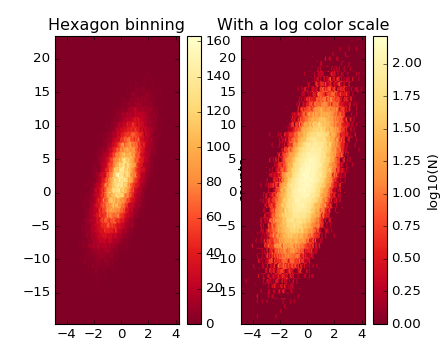
Notes
In addition to the above described arguments, this function can take a data keyword argument. If such a data argument is given, the following arguments are replaced by data[<arg>]:
- All arguments with the following names: ?y?, ?x?.
Additional kwargs: hold = [True|False] overrides default hold state
-
matplotlib.pyplot.hist(x, bins=10, range=None, normed=False, weights=None, cumulative=False, bottom=None, histtype='bar', align='mid', orientation='vertical', rwidth=None, log=False, color=None, label=None, stacked=False, hold=None, data=None, **kwargs) -
Plot a histogram.
Compute and draw the histogram of x. The return value is a tuple (n, bins, patches) or ([n0, n1, ...], bins, [patches0, patches1,...]) if the input contains multiple data.
Multiple data can be provided via x as a list of datasets of potentially different length ([x0, x1, ...]), or as a 2-D ndarray in which each column is a dataset. Note that the ndarray form is transposed relative to the list form.
Masked arrays are not supported at present.
Parameters: x : (n,) array or sequence of (n,) arrays
Input values, this takes either a single array or a sequency of arrays which are not required to be of the same length
bins : integer or array_like, optional
If an integer is given,
bins + 1bin edges are returned, consistently withnumpy.histogram()for numpy version >= 1.3.Unequally spaced bins are supported if
binsis a sequence.default is 10
range : tuple or None, optional
The lower and upper range of the bins. Lower and upper outliers are ignored. If not provided,
rangeis (x.min(), x.max()). Range has no effect ifbinsis a sequence.If
binsis a sequence orrangeis specified, autoscaling is based on the specified bin range instead of the range of x.Default is
Nonenormed : boolean, optional
If
True, the first element of the return tuple will be the counts normalized to form a probability density, i.e.,n/(len(x)`dbin), i.e., the integral of the histogram will sum to 1. If stacked is also True, the sum of the histograms is normalized to 1.Default is
Falseweights : (n, ) array_like or None, optional
An array of weights, of the same shape as
x. Each value inxonly contributes its associated weight towards the bin count (instead of 1). Ifnormedis True, the weights are normalized, so that the integral of the density over the range remains 1.Default is
Nonecumulative : boolean, optional
If
True, then a histogram is computed where each bin gives the counts in that bin plus all bins for smaller values. The last bin gives the total number of datapoints. Ifnormedis alsoTruethen the histogram is normalized such that the last bin equals 1. Ifcumulativeevaluates to less than 0 (e.g., -1), the direction of accumulation is reversed. In this case, ifnormedis alsoTrue, then the histogram is normalized such that the first bin equals 1.Default is
Falsebottom : array_like, scalar, or None
Location of the bottom baseline of each bin. If a scalar, the base line for each bin is shifted by the same amount. If an array, each bin is shifted independently and the length of bottom must match the number of bins. If None, defaults to 0.
Default is
Nonehisttype : {?bar?, ?barstacked?, ?step?, ?stepfilled?}, optional
The type of histogram to draw.
- ?bar? is a traditional bar-type histogram. If multiple data are given the bars are aranged side by side.
- ?barstacked? is a bar-type histogram where multiple data are stacked on top of each other.
- ?step? generates a lineplot that is by default unfilled.
- ?stepfilled? generates a lineplot that is by default filled.
Default is ?bar?
align : {?left?, ?mid?, ?right?}, optional
Controls how the histogram is plotted.
- ?left?: bars are centered on the left bin edges.
- ?mid?: bars are centered between the bin edges.
- ?right?: bars are centered on the right bin edges.
Default is ?mid?
orientation : {?horizontal?, ?vertical?}, optional
If ?horizontal?,
barhwill be used for bar-type histograms and the bottom kwarg will be the left edges.rwidth : scalar or None, optional
The relative width of the bars as a fraction of the bin width. If
None, automatically compute the width.Ignored if
histtypeis ?step? or ?stepfilled?.Default is
Nonelog : boolean, optional
If
True, the histogram axis will be set to a log scale. IflogisTrueandxis a 1D array, empty bins will be filtered out and only the non-empty (n,bins,patches) will be returned.Default is
Falsecolor : color or array_like of colors or None, optional
Color spec or sequence of color specs, one per dataset. Default (
None) uses the standard line color sequence.Default is
Nonelabel : string or None, optional
String, or sequence of strings to match multiple datasets. Bar charts yield multiple patches per dataset, but only the first gets the label, so that the legend command will work as expected.
default is
Nonestacked : boolean, optional
If
True, multiple data are stacked on top of each other IfFalsemultiple data are aranged side by side if histtype is ?bar? or on top of each other if histtype is ?step?Default is
FalseReturns: n : array or list of arrays
The values of the histogram bins. See normed and weights for a description of the possible semantics. If input x is an array, then this is an array of length nbins. If input is a sequence arrays
[data1, data2,..], then this is a list of arrays with the values of the histograms for each of the arrays in the same order.bins : array
The edges of the bins. Length nbins + 1 (nbins left edges and right edge of last bin). Always a single array even when multiple data sets are passed in.
patches : list or list of lists
Silent list of individual patches used to create the histogram or list of such list if multiple input datasets.
Other Parameters: kwargs :
PatchpropertiesSee also
-
hist2d - 2D histograms
Notes
In addition to the above described arguments, this function can take a data keyword argument. If such a data argument is given, the following arguments are replaced by data[<arg>]:
- All arguments with the following names: ?weights?, ?x?.
Additional kwargs: hold = [True|False] overrides default hold state
Examples
(Source code, png, hires.png, pdf)
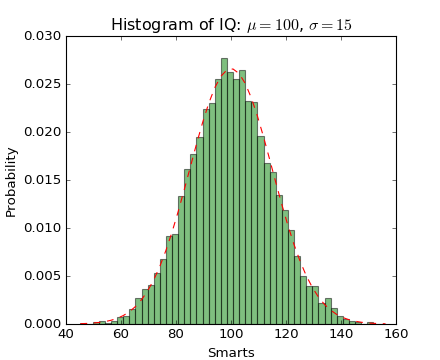
-
matplotlib.pyplot.hist2d(x, y, bins=10, range=None, normed=False, weights=None, cmin=None, cmax=None, hold=None, data=None, **kwargs) -
Make a 2D histogram plot.
Parameters: x, y: array_like, shape (n, )
Input values
bins: [None | int | [int, int] | array_like | [array, array]]
The bin specification:
- If int, the number of bins for the two dimensions (nx=ny=bins).
- If [int, int], the number of bins in each dimension (nx, ny = bins).
- If array_like, the bin edges for the two dimensions (x_edges=y_edges=bins).
- If [array, array], the bin edges in each dimension (x_edges, y_edges = bins).
The default value is 10.
range : array_like shape(2, 2), optional, default: None
The leftmost and rightmost edges of the bins along each dimension (if not specified explicitly in the bins parameters): [[xmin, xmax], [ymin, ymax]]. All values outside of this range will be considered outliers and not tallied in the histogram.
normed : boolean, optional, default: False
Normalize histogram.
weights : array_like, shape (n, ), optional, default: None
An array of values w_i weighing each sample (x_i, y_i).
cmin : scalar, optional, default: None
All bins that has count less than cmin will not be displayed and these count values in the return value count histogram will also be set to nan upon return
cmax : scalar, optional, default: None
All bins that has count more than cmax will not be displayed (set to none before passing to imshow) and these count values in the return value count histogram will also be set to nan upon return
Returns: The return value is
(counts, xedges, yedges, Image).Other Parameters: kwargs :
pcolorfast()properties.See also
-
hist - 1D histogram
Notes
In addition to the above described arguments, this function can take a data keyword argument. If such a data argument is given, the following arguments are replaced by data[<arg>]:
- All arguments with the following names: ?y?, ?weights?, ?x?.
Additional kwargs: hold = [True|False] overrides default hold state
Examples
(Source code, png, hires.png, pdf)
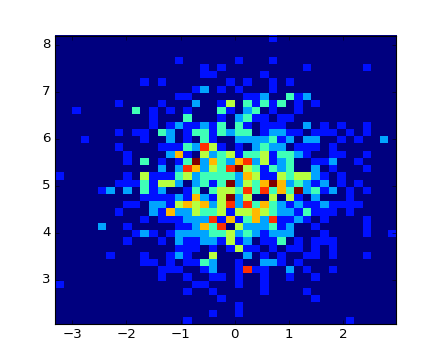
-
matplotlib.pyplot.hlines(y, xmin, xmax, colors='k', linestyles='solid', label='', hold=None, data=None, **kwargs) -
Plot horizontal lines at each
yfromxmintoxmax.Parameters: y : scalar or sequence of scalar
y-indexes where to plot the lines.
xmin, xmax : scalar or 1D array_like
Respective beginning and end of each line. If scalars are provided, all lines will have same length.
colors : array_like of colors, optional, default: ?k?
linestyles : [?solid? | ?dashed? | ?dashdot? | ?dotted?], optional
label : string, optional, default: ??
Returns: lines :
LineCollectionOther Parameters: kwargs :
LineCollectionproperties.See also
-
vlines - vertical lines
Notes
In addition to the above described arguments, this function can take a data keyword argument. If such a data argument is given, the following arguments are replaced by data[<arg>]:
- All arguments with the following names: ?xmax?, ?y?, ?xmin?.
Additional kwargs: hold = [True|False] overrides default hold state
Examples
(Source code, png, hires.png, pdf)
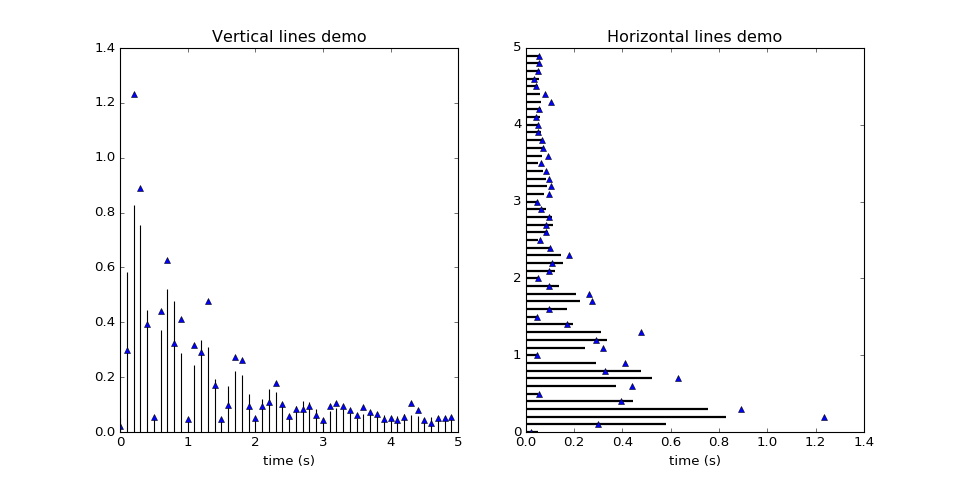
-
-
matplotlib.pyplot.hold(b=None) -
Set the hold state. If b is None (default), toggle the hold state, else set the hold state to boolean value b:
hold() # toggle hold hold(True) # hold is on hold(False) # hold is off
When hold is True, subsequent plot commands will be added to the current axes. When hold is False, the current axes and figure will be cleared on the next plot command.
-
matplotlib.pyplot.hot() -
set the default colormap to hot and apply to current image if any. See help(colormaps) for more information
-
matplotlib.pyplot.hsv() -
set the default colormap to hsv and apply to current image if any. See help(colormaps) for more information
-
matplotlib.pyplot.imread(*args, **kwargs) -
Read an image from a file into an array.
fname may be a string path, a valid URL, or a Python file-like object. If using a file object, it must be opened in binary mode.
If format is provided, will try to read file of that type, otherwise the format is deduced from the filename. If nothing can be deduced, PNG is tried.
Return value is a
numpy.array. For grayscale images, the return array is MxN. For RGB images, the return value is MxNx3. For RGBA images the return value is MxNx4.matplotlib can only read PNGs natively, but if PIL is installed, it will use it to load the image and return an array (if possible) which can be used with
imshow(). Note, URL strings may not be compatible with PIL. Check the PIL documentation for more information.
-
matplotlib.pyplot.imsave(*args, **kwargs) -
Save an array as in image file.
The output formats available depend on the backend being used.
- Arguments:
-
- fname:
- A string containing a path to a filename, or a Python file-like object. If format is None and fname is a string, the output format is deduced from the extension of the filename.
- arr:
- An MxN (luminance), MxNx3 (RGB) or MxNx4 (RGBA) array.
- Keyword arguments:
-
- vmin/vmax: [ None | scalar ]
- vmin and vmax set the color scaling for the image by fixing the values that map to the colormap color limits. If either vmin or vmax is None, that limit is determined from the arr min/max value.
- cmap:
- cmap is a colors.Colormap instance, e.g., cm.jet. If None, default to the rc image.cmap value.
- format:
- One of the file extensions supported by the active backend. Most backends support png, pdf, ps, eps and svg.
- origin
- [ ?upper? | ?lower? ] Indicates where the [0,0] index of the array is in the upper left or lower left corner of the axes. Defaults to the rc image.origin value.
- dpi
- The DPI to store in the metadata of the file. This does not affect the resolution of the output image.
-
matplotlib.pyplot.imshow(X, cmap=None, norm=None, aspect=None, interpolation=None, alpha=None, vmin=None, vmax=None, origin=None, extent=None, shape=None, filternorm=1, filterrad=4.0, imlim=None, resample=None, url=None, hold=None, data=None, **kwargs) -
Display an image on the axes.
Parameters: X : array_like, shape (n, m) or (n, m, 3) or (n, m, 4)
Display the image in
Xto current axes.Xmay be a float array, a uint8 array or a PIL image. IfXis an array, it can have the following shapes:- MxN ? luminance (grayscale, float array only)
- MxNx3 ? RGB (float or uint8 array)
- MxNx4 ? RGBA (float or uint8 array)
The value for each component of MxNx3 and MxNx4 float arrays should be in the range 0.0 to 1.0; MxN float arrays may be normalised.
cmap :
Colormap, optional, default: NoneIf None, default to rc
image.cmapvalue.cmapis ignored whenXhas RGB(A) informationaspect : [?auto? | ?equal? | scalar], optional, default: None
If ?auto?, changes the image aspect ratio to match that of the axes.
If ?equal?, and
extentis None, changes the axes aspect ratio to match that of the image. Ifextentis notNone, the axes aspect ratio is changed to match that of the extent.If None, default to rc
image.aspectvalue.interpolation : string, optional, default: None
Acceptable values are ?none?, ?nearest?, ?bilinear?, ?bicubic?, ?spline16?, ?spline36?, ?hanning?, ?hamming?, ?hermite?, ?kaiser?, ?quadric?, ?catrom?, ?gaussian?, ?bessel?, ?mitchell?, ?sinc?, ?lanczos?
If
interpolationis None, default to rcimage.interpolation. See also thefilternormandfilterradparameters. Ifinterpolationis ?none?, then no interpolation is performed on the Agg, ps and pdf backends. Other backends will fall back to ?nearest?.norm :
Normalize, optional, default: NoneA
Normalizeinstance is used to scale luminance data to 0, 1. IfNone, use the default func:normalize.normis only used ifXis an array of floats.vmin, vmax : scalar, optional, default: None
vminandvmaxare used in conjunction with norm to normalize luminance data. Note if you pass anorminstance, your settings forvminandvmaxwill be ignored.alpha : scalar, optional, default: None
The alpha blending value, between 0 (transparent) and 1 (opaque)
origin : [?upper? | ?lower?], optional, default: None
Place the [0,0] index of the array in the upper left or lower left corner of the axes. If None, default to rc
image.origin.extent : scalars (left, right, bottom, top), optional, default: None
The location, in data-coordinates, of the lower-left and upper-right corners. If
None, the image is positioned such that the pixel centers fall on zero-based (row, column) indices.shape : scalars (columns, rows), optional, default: None
For raw buffer images
filternorm : scalar, optional, default: 1
A parameter for the antigrain image resize filter. From the antigrain documentation, if
filternorm= 1, the filter normalizes integer values and corrects the rounding errors. It doesn?t do anything with the source floating point values, it corrects only integers according to the rule of 1.0 which means that any sum of pixel weights must be equal to 1.0. So, the filter function must produce a graph of the proper shape.filterrad : scalar, optional, default: 4.0
The filter radius for filters that have a radius parameter, i.e. when interpolation is one of: ?sinc?, ?lanczos? or ?blackman?
Returns: image :
AxesImageOther Parameters: kwargs :
Artistproperties.See also
-
matshow - Plot a matrix or an array as an image.
Notes
In addition to the above described arguments, this function can take a data keyword argument. If such a data argument is given, the following arguments are replaced by data[<arg>]:
- All positional and all keyword arguments.
Additional kwargs: hold = [True|False] overrides default hold state
Examples
(Source code, png, hires.png, pdf)
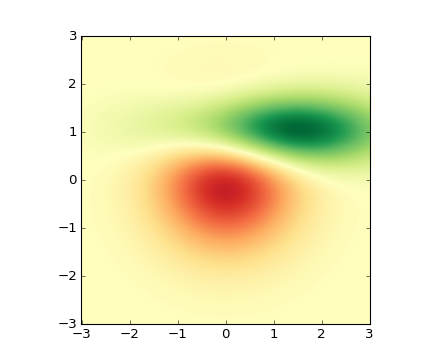
-
matplotlib.pyplot.inferno() -
set the default colormap to inferno and apply to current image if any. See help(colormaps) for more information
-
matplotlib.pyplot.install_repl_displayhook() -
Install a repl display hook so that any stale figure are automatically redrawn when control is returned to the repl.
This works with IPython terminals and kernels, as well as vanilla python shells.
-
matplotlib.pyplot.ioff() -
Turn interactive mode off.
-
matplotlib.pyplot.ion() -
Turn interactive mode on.
-
matplotlib.pyplot.ishold() -
Return the hold status of the current axes.
-
matplotlib.pyplot.isinteractive() -
Return status of interactive mode.
-
matplotlib.pyplot.jet() -
set the default colormap to jet and apply to current image if any. See help(colormaps) for more information
-
matplotlib.pyplot.legend(*args, **kwargs) -
Places a legend on the axes.
To make a legend for lines which already exist on the axes (via plot for instance), simply call this function with an iterable of strings, one for each legend item. For example:
ax.plot([1, 2, 3]) ax.legend(['A simple line'])
However, in order to keep the ?label? and the legend element instance together, it is preferable to specify the label either at artist creation, or by calling the
set_label()method on the artist:line, = ax.plot([1, 2, 3], label='Inline label') # Overwrite the label by calling the method. line.set_label('Label via method') ax.legend()Specific lines can be excluded from the automatic legend element selection by defining a label starting with an underscore. This is default for all artists, so calling
legend()without any arguments and without setting the labels manually will result in no legend being drawn.For full control of which artists have a legend entry, it is possible to pass an iterable of legend artists followed by an iterable of legend labels respectively:
legend((line1, line2, line3), ('label1', 'label2', 'label3'))Parameters: loc : int or string or pair of floats, default: ?upper right?
The location of the legend. Possible codes are:
Location String Location Code ?best? 0 ?upper right? 1 ?upper left? 2 ?lower left? 3 ?lower right? 4 ?right? 5 ?center left? 6 ?center right? 7 ?lower center? 8 ?upper center? 9 ?center? 10 Alternatively can be a 2-tuple giving
x, yof the lower-left corner of the legend in axes coordinates (in which casebbox_to_anchorwill be ignored).bbox_to_anchor :
matplotlib.transforms.BboxBaseinstance or tuple of floatsSpecify any arbitrary location for the legend in
bbox_transformcoordinates (default Axes coordinates).For example, to put the legend?s upper right hand corner in the center of the axes the following keywords can be used:
loc='upper right', bbox_to_anchor=(0.5, 0.5)
ncol : integer
The number of columns that the legend has. Default is 1.
prop : None or
matplotlib.font_manager.FontPropertiesor dictThe font properties of the legend. If None (default), the current
matplotlib.rcParamswill be used.fontsize : int or float or {?xx-small?, ?x-small?, ?small?, ?medium?, ?large?, ?x-large?, ?xx-large?}
Controls the font size of the legend. If the value is numeric the size will be the absolute font size in points. String values are relative to the current default font size. This argument is only used if
propis not specified.numpoints : None or int
The number of marker points in the legend when creating a legend entry for a line/
matplotlib.lines.Line2D. Default isNonewhich will take the value from thelegend.numpointsrcParam.scatterpoints : None or int
The number of marker points in the legend when creating a legend entry for a scatter plot/
matplotlib.collections.PathCollection. Default isNonewhich will take the value from thelegend.scatterpointsrcParam.scatteryoffsets : iterable of floats
The vertical offset (relative to the font size) for the markers created for a scatter plot legend entry. 0.0 is at the base the legend text, and 1.0 is at the top. To draw all markers at the same height, set to
[0.5]. Default[0.375, 0.5, 0.3125].markerscale : None or int or float
The relative size of legend markers compared with the originally drawn ones. Default is
Nonewhich will take the value from thelegend.markerscalercParam.*markerfirst*: [ *True* | *False* ]
if True, legend marker is placed to the left of the legend label if False, legend marker is placed to the right of the legend label
frameon : None or bool
Control whether a frame should be drawn around the legend. Default is
Nonewhich will take the value from thelegend.frameonrcParam.fancybox : None or bool
Control whether round edges should be enabled around the
FancyBboxPatchwhich makes up the legend?s background. Default isNonewhich will take the value from thelegend.fancyboxrcParam.shadow : None or bool
Control whether to draw a shadow behind the legend. Default is
Nonewhich will take the value from thelegend.shadowrcParam.framealpha : None or float
Control the alpha transparency of the legend?s frame. Default is
Nonewhich will take the value from thelegend.framealpharcParam.mode : {?expand?, None}
If
modeis set to"expand"the legend will be horizontally expanded to fill the axes area (orbbox_to_anchorif defines the legend?s size).bbox_transform : None or
matplotlib.transforms.TransformThe transform for the bounding box (
bbox_to_anchor). For a value ofNone(default) the Axes?transAxestransform will be used.title : str or None
The legend?s title. Default is no title (
None).borderpad : float or None
The fractional whitespace inside the legend border. Measured in font-size units. Default is
Nonewhich will take the value from thelegend.borderpadrcParam.labelspacing : float or None
The vertical space between the legend entries. Measured in font-size units. Default is
Nonewhich will take the value from thelegend.labelspacingrcParam.handlelength : float or None
The length of the legend handles. Measured in font-size units. Default is
Nonewhich will take the value from thelegend.handlelengthrcParam.handletextpad : float or None
The pad between the legend handle and text. Measured in font-size units. Default is
Nonewhich will take the value from thelegend.handletextpadrcParam.borderaxespad : float or None
The pad between the axes and legend border. Measured in font-size units. Default is
Nonewhich will take the value from thelegend.borderaxespadrcParam.columnspacing : float or None
The spacing between columns. Measured in font-size units. Default is
Nonewhich will take the value from thelegend.columnspacingrcParam.handler_map : dict or None
The custom dictionary mapping instances or types to a legend handler. This
handler_mapupdates the default handler map found atmatplotlib.legend.Legend.get_legend_handler_map().Notes
Not all kinds of artist are supported by the legend command. See Legend guide for details.
Examples
(Source code, png, hires.png, pdf)
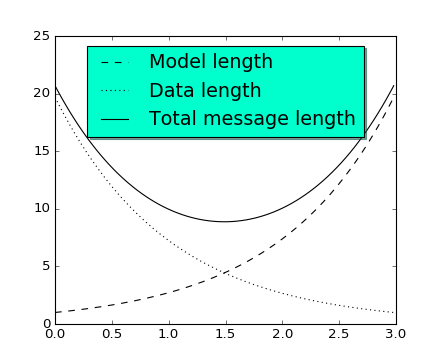
-
matplotlib.pyplot.locator_params(axis='both', tight=None, **kwargs) -
Control behavior of tick locators.
Keyword arguments:
- axis
- [?x? | ?y? | ?both?] Axis on which to operate; default is ?both?.
- tight
- [True | False | None] Parameter passed to
autoscale_view(). Default is None, for no change.
Remaining keyword arguments are passed to directly to the
set_params()method.Typically one might want to reduce the maximum number of ticks and use tight bounds when plotting small subplots, for example:
ax.locator_params(tight=True, nbins=4)
Because the locator is involved in autoscaling,
autoscale_view()is called automatically after the parameters are changed.This presently works only for the
MaxNLocatorused by default on linear axes, but it may be generalized.
-
matplotlib.pyplot.loglog(*args, **kwargs) -
Make a plot with log scaling on both the x and y axis.
Call signature:
loglog(*args, **kwargs)
loglog()supports all the keyword arguments ofplot()andmatplotlib.axes.Axes.set_xscale()/matplotlib.axes.Axes.set_yscale().Notable keyword arguments:
- basex/basey: scalar > 1
- Base of the x/y logarithm
- subsx/subsy: [ None | sequence ]
- The location of the minor x/y ticks; None defaults to autosubs, which depend on the number of decades in the plot; see
matplotlib.axes.Axes.set_xscale()/matplotlib.axes.Axes.set_yscale()for details - nonposx/nonposy: [?mask? | ?clip? ]
- Non-positive values in x or y can be masked as invalid, or clipped to a very small positive number
The remaining valid kwargs are
Line2Dproperties:Property Description agg_filterunknown alphafloat (0.0 transparent through 1.0 opaque) animated[True | False] antialiasedor aa[True | False] axesan Axesinstanceclip_boxa matplotlib.transforms.Bboxinstanceclip_on[True | False] clip_path[ ( Path,Transform) |Patch| None ]coloror cany matplotlib color containsa callable function dash_capstyle[?butt? | ?round? | ?projecting?] dash_joinstyle[?miter? | ?round? | ?bevel?] dashessequence of on/off ink in points drawstyle[?default? | ?steps? | ?steps-pre? | ?steps-mid? | ?steps-post?] figurea matplotlib.figure.Figureinstancefillstyle[?full? | ?left? | ?right? | ?bottom? | ?top? | ?none?] gidan id string labelstring or anything printable with ?%s? conversion. linestyleor ls[?solid? | ?dashed?, ?dashdot?, ?dotted? | (offset, on-off-dash-seq) | '-'|'--'|'-.'|':'|'None'|' '|'']linewidthor lwfloat value in points markerA valid marker stylemarkeredgecoloror mecany matplotlib color markeredgewidthor mewfloat value in points markerfacecoloror mfcany matplotlib color markerfacecoloraltor mfcaltany matplotlib color markersizeor msfloat markevery[None | int | length-2 tuple of int | slice | list/array of int | float | length-2 tuple of float] path_effectsunknown pickerfloat distance in points or callable pick function fn(artist, event)pickradiusfloat distance in points rasterized[True | False | None] sketch_paramsunknown snapunknown solid_capstyle[?butt? | ?round? | ?projecting?] solid_joinstyle[?miter? | ?round? | ?bevel?] transforma matplotlib.transforms.Transforminstanceurla url string visible[True | False] xdata1D array ydata1D array zorderany number Example:
(Source code, png, hires.png, pdf)
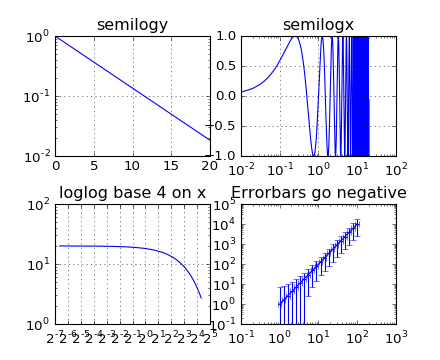
Additional kwargs: hold = [True|False] overrides default hold state
-
matplotlib.pyplot.magma() -
set the default colormap to magma and apply to current image if any. See help(colormaps) for more information
-
matplotlib.pyplot.magnitude_spectrum(x, Fs=None, Fc=None, window=None, pad_to=None, sides=None, scale=None, hold=None, data=None, **kwargs) -
Plot the magnitude spectrum.
Call signature:
magnitude_spectrum(x, Fs=2, Fc=0, window=mlab.window_hanning, pad_to=None, sides='default', **kwargs)Compute the magnitude spectrum of x. Data is padded to a length of pad_to and the windowing function window is applied to the signal.
- x: 1-D array or sequence
- Array or sequence containing the data
Keyword arguments:
- Fs: scalar
- The sampling frequency (samples per time unit). It is used to calculate the Fourier frequencies, freqs, in cycles per time unit. The default value is 2.
- window: callable or ndarray
- A function or a vector of length NFFT. To create window vectors see
window_hanning(),window_none(),numpy.blackman(),numpy.hamming(),numpy.bartlett(),scipy.signal(),scipy.signal.get_window(), etc. The default iswindow_hanning(). If a function is passed as the argument, it must take a data segment as an argument and return the windowed version of the segment. - sides: [ ?default? | ?onesided? | ?twosided? ]
- Specifies which sides of the spectrum to return. Default gives the default behavior, which returns one-sided for real data and both for complex data. ?onesided? forces the return of a one-sided spectrum, while ?twosided? forces two-sided.
- pad_to: integer
- The number of points to which the data segment is padded when performing the FFT. While not increasing the actual resolution of the spectrum (the minimum distance between resolvable peaks), this can give more points in the plot, allowing for more detail. This corresponds to the n parameter in the call to fft(). The default is None, which sets pad_to equal to the length of the input signal (i.e. no padding).
- scale: [ ?default? | ?linear? | ?dB? ]
- The scaling of the values in the spec. ?linear? is no scaling. ?dB? returns the values in dB scale. When mode is ?density?, this is dB power (10 * log10). Otherwise this is dB amplitude (20 * log10). ?default? is ?linear?.
- Fc: integer
- The center frequency of x (defaults to 0), which offsets the x extents of the plot to reflect the frequency range used when a signal is acquired and then filtered and downsampled to baseband.
Returns the tuple (spectrum, freqs, line):
- spectrum: 1-D array
- The values for the magnitude spectrum before scaling (real valued)
- freqs: 1-D array
- The frequencies corresponding to the elements in spectrum
-
line: a Line2D instance - The line created by this function
kwargs control the
Line2Dproperties:Property Description agg_filterunknown alphafloat (0.0 transparent through 1.0 opaque) animated[True | False] antialiasedor aa[True | False] axesan Axesinstanceclip_boxa matplotlib.transforms.Bboxinstanceclip_on[True | False] clip_path[ ( Path,Transform) |Patch| None ]coloror cany matplotlib color containsa callable function dash_capstyle[?butt? | ?round? | ?projecting?] dash_joinstyle[?miter? | ?round? | ?bevel?] dashessequence of on/off ink in points drawstyle[?default? | ?steps? | ?steps-pre? | ?steps-mid? | ?steps-post?] figurea matplotlib.figure.Figureinstancefillstyle[?full? | ?left? | ?right? | ?bottom? | ?top? | ?none?] gidan id string labelstring or anything printable with ?%s? conversion. linestyleor ls[?solid? | ?dashed?, ?dashdot?, ?dotted? | (offset, on-off-dash-seq) | '-'|'--'|'-.'|':'|'None'|' '|'']linewidthor lwfloat value in points markerA valid marker stylemarkeredgecoloror mecany matplotlib color markeredgewidthor mewfloat value in points markerfacecoloror mfcany matplotlib color markerfacecoloraltor mfcaltany matplotlib color markersizeor msfloat markevery[None | int | length-2 tuple of int | slice | list/array of int | float | length-2 tuple of float] path_effectsunknown pickerfloat distance in points or callable pick function fn(artist, event)pickradiusfloat distance in points rasterized[True | False | None] sketch_paramsunknown snapunknown solid_capstyle[?butt? | ?round? | ?projecting?] solid_joinstyle[?miter? | ?round? | ?bevel?] transforma matplotlib.transforms.Transforminstanceurla url string visible[True | False] xdata1D array ydata1D array zorderany number Example:
(Source code, png, hires.png, pdf)

See also
-
psd() -
psd()plots the power spectral density.`. -
angle_spectrum() -
angle_spectrum()plots the angles of the corresponding frequencies. -
phase_spectrum() -
phase_spectrum()plots the phase (unwrapped angle) of the corresponding frequencies. -
specgram() -
specgram()can plot the magnitude spectrum of segments within the signal in a colormap.
Notes
In addition to the above described arguments, this function can take a data keyword argument. If such a data argument is given, the following arguments are replaced by data[<arg>]:
- All arguments with the following names: ?x?.
Additional kwargs: hold = [True|False] overrides default hold state
-
matplotlib.pyplot.margins(*args, **kw) -
Set or retrieve autoscaling margins.
signatures:
margins()
returns xmargin, ymargin
margins(margin) margins(xmargin, ymargin) margins(x=xmargin, y=ymargin) margins(..., tight=False)
All three forms above set the xmargin and ymargin parameters. All keyword parameters are optional. A single argument specifies both xmargin and ymargin. The tight parameter is passed to
autoscale_view(), which is executed after a margin is changed; the default here is True, on the assumption that when margins are specified, no additional padding to match tick marks is usually desired. Setting tight to None will preserve the previous setting.Specifying any margin changes only the autoscaling; for example, if xmargin is not None, then xmargin times the X data interval will be added to each end of that interval before it is used in autoscaling.
-
matplotlib.pyplot.matshow(A, fignum=None, **kw) -
Display an array as a matrix in a new figure window.
The origin is set at the upper left hand corner and rows (first dimension of the array) are displayed horizontally. The aspect ratio of the figure window is that of the array, unless this would make an excessively short or narrow figure.
Tick labels for the xaxis are placed on top.
With the exception of fignum, keyword arguments are passed to
imshow(). You may set the origin kwarg to ?lower? if you want the first row in the array to be at the bottom instead of the top.- fignum: [ None | integer | False ]
-
By default,
matshow()creates a new figure window with automatic numbering. If fignum is given as an integer, the created figure will use this figure number. Because of howmatshow()tries to set the figure aspect ratio to be the one of the array, if you provide the number of an already existing figure, strange things may happen.If fignum is False or 0, a new figure window will NOT be created.
-
matplotlib.pyplot.minorticks_off() -
Remove minor ticks from the current plot.
-
matplotlib.pyplot.minorticks_on() -
Display minor ticks on the current plot.
Displaying minor ticks reduces performance; turn them off using minorticks_off() if drawing speed is a problem.
-
matplotlib.pyplot.over(func, *args, **kwargs) -
Call a function with hold(True).
Calls:
func(*args, **kwargs)
with
hold(True)and then restores the hold state.
-
matplotlib.pyplot.pause(interval) -
Pause for interval seconds.
If there is an active figure it will be updated and displayed, and the GUI event loop will run during the pause.
If there is no active figure, or if a non-interactive backend is in use, this executes time.sleep(interval).
This can be used for crude animation. For more complex animation, see
matplotlib.animation.This function is experimental; its behavior may be changed or extended in a future release.
-
matplotlib.pyplot.pcolor(*args, **kwargs) -
Create a pseudocolor plot of a 2-D array.
Note
pcolor can be very slow for large arrays; consider using the similar but much faster
pcolormesh()instead.Call signatures:
pcolor(C, **kwargs) pcolor(X, Y, C, **kwargs)
C is the array of color values.
X and Y, if given, specify the (x, y) coordinates of the colored quadrilaterals; the quadrilateral for C[i,j] has corners at:
(X[i, j], Y[i, j]), (X[i, j+1], Y[i, j+1]), (X[i+1, j], Y[i+1, j]), (X[i+1, j+1], Y[i+1, j+1]).
Ideally the dimensions of X and Y should be one greater than those of C; if the dimensions are the same, then the last row and column of C will be ignored.
Note that the column index corresponds to the x-coordinate, and the row index corresponds to y; for details, see the Grid Orientation section below.
If either or both of X and Y are 1-D arrays or column vectors, they will be expanded as needed into the appropriate 2-D arrays, making a rectangular grid.
X, Y and C may be masked arrays. If either C[i, j], or one of the vertices surrounding C[i,j] (X or Y at [i, j], [i+1, j], [i, j+1],[i+1, j+1]) is masked, nothing is plotted.
Keyword arguments:
- cmap: [ None | Colormap ]
- A
matplotlib.colors.Colormapinstance. If None, use rc settings. - norm: [ None | Normalize ]
- An
matplotlib.colors.Normalizeinstance is used to scale luminance data to 0,1. If None, defaults tonormalize(). - vmin/vmax: [ None | scalar ]
- vmin and vmax are used in conjunction with norm to normalize luminance data. If either is None, it is autoscaled to the respective min or max of the color array C. If not None, vmin or vmax passed in here override any pre-existing values supplied in the norm instance.
- shading: [ ?flat? | ?faceted? ]
-
If ?faceted?, a black grid is drawn around each rectangle; if ?flat?, edges are not drawn. Default is ?flat?, contrary to MATLAB.
- This kwarg is deprecated; please use ?edgecolors? instead:
-
- shading=?flat? ? edgecolors=?none?
- shading=?faceted ? edgecolors=?k?
-
edgecolors: [ None | 'none' | color | color sequence] -
If None, the rc setting is used by default.
If
'none', edges will not be visible.An mpl color or sequence of colors will set the edge color
-
alpha: 0 <= scalar <= 1 or None - the alpha blending value
- snap: bool
- Whether to snap the mesh to pixel boundaries.
Return value is a
matplotlib.collections.Collectioninstance.The grid orientation follows the MATLAB convention: an array C with shape (nrows, ncolumns) is plotted with the column number as X and the row number as Y, increasing up; hence it is plotted the way the array would be printed, except that the Y axis is reversed. That is, C is taken as C*(*y, x).
Similarly for
meshgrid():x = np.arange(5) y = np.arange(3) X, Y = np.meshgrid(x, y)
is equivalent to:
X = array([[0, 1, 2, 3, 4], [0, 1, 2, 3, 4], [0, 1, 2, 3, 4]]) Y = array([[0, 0, 0, 0, 0], [1, 1, 1, 1, 1], [2, 2, 2, 2, 2]])so if you have:
C = rand(len(x), len(y))
then you need to transpose C:
pcolor(X, Y, C.T)
or:
pcolor(C.T)
MATLAB
pcolor()always discards the last row and column of C, but matplotlib displays the last row and column if X and Y are not specified, or if X and Y have one more row and column than C.kwargs can be used to control the
PolyCollectionproperties:Property Description agg_filterunknown alphafloat or None animated[True | False] antialiasedor antialiasedsBoolean or sequence of booleans arrayunknown axesan Axesinstanceclima length 2 sequence of floats clip_boxa matplotlib.transforms.Bboxinstanceclip_on[True | False] clip_path[ ( Path,Transform) |Patch| None ]cmapa colormap or registered colormap name colormatplotlib color arg or sequence of rgba tuples containsa callable function edgecoloror edgecolorsmatplotlib color spec or sequence of specs facecoloror facecolorsmatplotlib color spec or sequence of specs figurea matplotlib.figure.Figureinstancegidan id string hatch[ ?/? | ?\? | ?|? | ?-? | ?+? | ?x? | ?o? | ?O? | ?.? | ?*? ] labelstring or anything printable with ?%s? conversion. linestyleor linestyles or dashes[?solid? | ?dashed?, ?dashdot?, ?dotted? | (offset, on-off-dash-seq) | '-'|'--'|'-.'|':'|'None'|' '|'']linewidthor linewidths or lwfloat or sequence of floats normunknown offset_positionunknown offsetsfloat or sequence of floats path_effectsunknown picker[None|float|boolean|callable] pickradiusunknown rasterized[True | False | None] sketch_paramsunknown snapunknown transformTransforminstanceurla url string urlsunknown visible[True | False] zorderany number Note
The default antialiaseds is False if the default edgecolors*=?none? is used. This eliminates artificial lines at patch boundaries, and works regardless of the value of alpha. If *edgecolors is not ?none?, then the default antialiaseds is taken from rcParams[?patch.antialiased?], which defaults to True. Stroking the edges may be preferred if alpha is 1, but will cause artifacts otherwise.
See also
-
pcolormesh() - For an explanation of the differences between pcolor and pcolormesh.
Notes
In addition to the above described arguments, this function can take a data keyword argument. If such a data argument is given, the following arguments are replaced by data[<arg>]:
- All positional and all keyword arguments.
Additional kwargs: hold = [True|False] overrides default hold state
-
matplotlib.pyplot.pcolormesh(*args, **kwargs) -
Plot a quadrilateral mesh.
Call signatures:
pcolormesh(C) pcolormesh(X, Y, C) pcolormesh(C, **kwargs)
Create a pseudocolor plot of a 2-D array.
pcolormesh is similar to
pcolor(), but uses a different mechanism and returns a different object; pcolor returns aPolyCollectionbut pcolormesh returns aQuadMesh. It is much faster, so it is almost always preferred for large arrays.C may be a masked array, but X and Y may not. Masked array support is implemented via cmap and norm; in contrast,
pcolor()simply does not draw quadrilaterals with masked colors or vertices.Keyword arguments:
- cmap: [ None | Colormap ]
- A
matplotlib.colors.Colormapinstance. If None, use rc settings. - norm: [ None | Normalize ]
- A
matplotlib.colors.Normalizeinstance is used to scale luminance data to 0,1. If None, defaults tonormalize(). - vmin/vmax: [ None | scalar ]
- vmin and vmax are used in conjunction with norm to normalize luminance data. If either is None, it is autoscaled to the respective min or max of the color array C. If not None, vmin or vmax passed in here override any pre-existing values supplied in the norm instance.
- shading: [ ?flat? | ?gouraud? ]
- ?flat? indicates a solid color for each quad. When ?gouraud?, each quad will be Gouraud shaded. When gouraud shading, edgecolors is ignored.
-
edgecolors: [None | 'None' | 'face' | color | - color sequence]
If None, the rc setting is used by default.
If
'None', edges will not be visible.If
'face', edges will have the same color as the faces.An mpl color or sequence of colors will set the edge color
-
alpha: 0 <= scalar <= 1 or None - the alpha blending value
Return value is a
matplotlib.collections.QuadMeshobject.kwargs can be used to control the
matplotlib.collections.QuadMeshproperties:Property Description agg_filterunknown alphafloat or None animated[True | False] antialiasedor antialiasedsBoolean or sequence of booleans arrayunknown axesan Axesinstanceclima length 2 sequence of floats clip_boxa matplotlib.transforms.Bboxinstanceclip_on[True | False] clip_path[ ( Path,Transform) |Patch| None ]cmapa colormap or registered colormap name colormatplotlib color arg or sequence of rgba tuples containsa callable function edgecoloror edgecolorsmatplotlib color spec or sequence of specs facecoloror facecolorsmatplotlib color spec or sequence of specs figurea matplotlib.figure.Figureinstancegidan id string hatch[ ?/? | ?\? | ?|? | ?-? | ?+? | ?x? | ?o? | ?O? | ?.? | ?*? ] labelstring or anything printable with ?%s? conversion. linestyleor linestyles or dashes[?solid? | ?dashed?, ?dashdot?, ?dotted? | (offset, on-off-dash-seq) | '-'|'--'|'-.'|':'|'None'|' '|'']linewidthor linewidths or lwfloat or sequence of floats normunknown offset_positionunknown offsetsfloat or sequence of floats path_effectsunknown picker[None|float|boolean|callable] pickradiusunknown rasterized[True | False | None] sketch_paramsunknown snapunknown transformTransforminstanceurla url string urlsunknown visible[True | False] zorderany number See also
-
pcolor() - For an explanation of the grid orientation and the expansion of 1-D X and/or Y to 2-D arrays.
Notes
In addition to the above described arguments, this function can take a data keyword argument. If such a data argument is given, the following arguments are replaced by data[<arg>]:
- All positional and all keyword arguments.
Additional kwargs: hold = [True|False] overrides default hold state
-
matplotlib.pyplot.phase_spectrum(x, Fs=None, Fc=None, window=None, pad_to=None, sides=None, hold=None, data=None, **kwargs) -
Plot the phase spectrum.
Call signature:
phase_spectrum(x, Fs=2, Fc=0, window=mlab.window_hanning, pad_to=None, sides='default', **kwargs)Compute the phase spectrum (unwrapped angle spectrum) of x. Data is padded to a length of pad_to and the windowing function window is applied to the signal.
- x: 1-D array or sequence
- Array or sequence containing the data
Keyword arguments:
- Fs: scalar
- The sampling frequency (samples per time unit). It is used to calculate the Fourier frequencies, freqs, in cycles per time unit. The default value is 2.
- window: callable or ndarray
- A function or a vector of length NFFT. To create window vectors see
window_hanning(),window_none(),numpy.blackman(),numpy.hamming(),numpy.bartlett(),scipy.signal(),scipy.signal.get_window(), etc. The default iswindow_hanning(). If a function is passed as the argument, it must take a data segment as an argument and return the windowed version of the segment. - sides: [ ?default? | ?onesided? | ?twosided? ]
- Specifies which sides of the spectrum to return. Default gives the default behavior, which returns one-sided for real data and both for complex data. ?onesided? forces the return of a one-sided spectrum, while ?twosided? forces two-sided.
- pad_to: integer
- The number of points to which the data segment is padded when performing the FFT. While not increasing the actual resolution of the spectrum (the minimum distance between resolvable peaks), this can give more points in the plot, allowing for more detail. This corresponds to the n parameter in the call to fft(). The default is None, which sets pad_to equal to the length of the input signal (i.e. no padding).
- Fc: integer
- The center frequency of x (defaults to 0), which offsets the x extents of the plot to reflect the frequency range used when a signal is acquired and then filtered and downsampled to baseband.
Returns the tuple (spectrum, freqs, line):
- spectrum: 1-D array
- The values for the phase spectrum in radians (real valued)
- freqs: 1-D array
- The frequencies corresponding to the elements in spectrum
-
line: a Line2D instance - The line created by this function
kwargs control the
Line2Dproperties:Property Description agg_filterunknown alphafloat (0.0 transparent through 1.0 opaque) animated[True | False] antialiasedor aa[True | False] axesan Axesinstanceclip_boxa matplotlib.transforms.Bboxinstanceclip_on[True | False] clip_path[ ( Path,Transform) |Patch| None ]coloror cany matplotlib color containsa callable function dash_capstyle[?butt? | ?round? | ?projecting?] dash_joinstyle[?miter? | ?round? | ?bevel?] dashessequence of on/off ink in points drawstyle[?default? | ?steps? | ?steps-pre? | ?steps-mid? | ?steps-post?] figurea matplotlib.figure.Figureinstancefillstyle[?full? | ?left? | ?right? | ?bottom? | ?top? | ?none?] gidan id string labelstring or anything printable with ?%s? conversion. linestyleor ls[?solid? | ?dashed?, ?dashdot?, ?dotted? | (offset, on-off-dash-seq) | '-'|'--'|'-.'|':'|'None'|' '|'']linewidthor lwfloat value in points markerA valid marker stylemarkeredgecoloror mecany matplotlib color markeredgewidthor mewfloat value in points markerfacecoloror mfcany matplotlib color markerfacecoloraltor mfcaltany matplotlib color markersizeor msfloat markevery[None | int | length-2 tuple of int | slice | list/array of int | float | length-2 tuple of float] path_effectsunknown pickerfloat distance in points or callable pick function fn(artist, event)pickradiusfloat distance in points rasterized[True | False | None] sketch_paramsunknown snapunknown solid_capstyle[?butt? | ?round? | ?projecting?] solid_joinstyle[?miter? | ?round? | ?bevel?] transforma matplotlib.transforms.Transforminstanceurla url string visible[True | False] xdata1D array ydata1D array zorderany number Example:
(Source code, png, hires.png, pdf)

See also
-
magnitude_spectrum() -
magnitude_spectrum()plots the magnitudes of the corresponding frequencies. -
angle_spectrum() -
angle_spectrum()plots the wrapped version of this function. -
specgram() -
specgram()can plot the phase spectrum of segments within the signal in a colormap.
Notes
In addition to the above described arguments, this function can take a data keyword argument. If such a data argument is given, the following arguments are replaced by data[<arg>]:
- All arguments with the following names: ?x?.
Additional kwargs: hold = [True|False] overrides default hold state
-
matplotlib.pyplot.pie(x, explode=None, labels=None, colors=None, autopct=None, pctdistance=0.6, shadow=False, labeldistance=1.1, startangle=None, radius=None, counterclock=True, wedgeprops=None, textprops=None, center=(0, 0), frame=False, hold=None, data=None) -
Plot a pie chart.
Call signature:
pie(x, explode=None, labels=None, colors=('b', 'g', 'r', 'c', 'm', 'y', 'k', 'w'), autopct=None, pctdistance=0.6, shadow=False, labeldistance=1.1, startangle=None, radius=None, counterclock=True, wedgeprops=None, textprops=None, center = (0, 0), frame = False )Make a pie chart of array x. The fractional area of each wedge is given by x/sum(x). If sum(x) <= 1, then the values of x give the fractional area directly and the array will not be normalized. The wedges are plotted counterclockwise, by default starting from the x-axis.
Keyword arguments:
- explode: [ None | len(x) sequence ]
- If not None, is a
len(x)array which specifies the fraction of the radius with which to offset each wedge. - colors: [ None | color sequence ]
- A sequence of matplotlib color args through which the pie chart will cycle.
- labels: [ None | len(x) sequence of strings ]
- A sequence of strings providing the labels for each wedge
- autopct: [ None | format string | format function ]
- If not None, is a string or function used to label the wedges with their numeric value. The label will be placed inside the wedge. If it is a format string, the label will be
fmt%pct. If it is a function, it will be called. - pctdistance: scalar
- The ratio between the center of each pie slice and the start of the text generated by autopct. Ignored if autopct is None; default is 0.6.
- labeldistance: scalar
- The radial distance at which the pie labels are drawn
- shadow: [ False | True ]
- Draw a shadow beneath the pie.
- startangle: [ None | Offset angle ]
- If not None, rotates the start of the pie chart by angle degrees counterclockwise from the x-axis.
radius: [ None | scalar ] The radius of the pie, if radius is None it will be set to 1.
- counterclock: [ False | True ]
- Specify fractions direction, clockwise or counterclockwise.
- wedgeprops: [ None | dict of key value pairs ]
- Dict of arguments passed to the wedge objects making the pie. For example, you can pass in wedgeprops = { ?linewidth? : 3 } to set the width of the wedge border lines equal to 3. For more details, look at the doc/arguments of the wedge object. By default
clip_on=False. - textprops: [ None | dict of key value pairs ]
- Dict of arguments to pass to the text objects.
center: [ (0,0) | sequence of 2 scalars ] Center position of the chart.
- frame: [ False | True ]
- Plot axes frame with the chart.
The pie chart will probably look best if the figure and axes are square, or the Axes aspect is equal. e.g.:
figure(figsize=(8,8)) ax = axes([0.1, 0.1, 0.8, 0.8])
or:
axes(aspect=1)
- Return value:
-
If autopct is None, return the tuple (patches, texts):
-
patches is a sequence of
matplotlib.patches.Wedgeinstances -
texts is a list of the label
matplotlib.text.Textinstances.
If autopct is not None, return the tuple (patches, texts, autotexts), where patches and texts are as above, and autotexts is a list of
Textinstances for the numeric labels. -
patches is a sequence of
Notes
In addition to the above described arguments, this function can take a data keyword argument. If such a data argument is given, the following arguments are replaced by data[<arg>]:
- All arguments with the following names: ?explode?, ?colors?, ?x?, ?labels?.
Additional kwargs: hold = [True|False] overrides default hold state
-
matplotlib.pyplot.pink() -
set the default colormap to pink and apply to current image if any. See help(colormaps) for more information
-
matplotlib.pyplot.plasma() -
set the default colormap to plasma and apply to current image if any. See help(colormaps) for more information
-
matplotlib.pyplot.plot(*args, **kwargs) -
Plot lines and/or markers to the
Axes. args is a variable length argument, allowing for multiple x, y pairs with an optional format string. For example, each of the following is legal:plot(x, y) # plot x and y using default line style and color plot(x, y, 'bo') # plot x and y using blue circle markers plot(y) # plot y using x as index array 0..N-1 plot(y, 'r+') # ditto, but with red plusses
If x and/or y is 2-dimensional, then the corresponding columns will be plotted.
If used with labeled data, make sure that the color spec is not included as an element in data, as otherwise the last case
plot("v","r", data={"v":..., "r":...)can be interpreted as the first case which would doplot(v, r)using the default line style and color.If not used with labeled data (i.e., without a data argument), an arbitrary number of x, y, fmt groups can be specified, as in:
a.plot(x1, y1, 'g^', x2, y2, 'g-')
Return value is a list of lines that were added.
By default, each line is assigned a different style specified by a ?style cycle?. To change this behavior, you can edit the axes.prop_cycle rcParam.
The following format string characters are accepted to control the line style or marker:
character description '-'solid line style '--'dashed line style '-.'dash-dot line style ':'dotted line style '.'point marker ','pixel marker 'o'circle marker 'v'triangle_down marker '^'triangle_up marker '<'triangle_left marker '>'triangle_right marker '1'tri_down marker '2'tri_up marker '3'tri_left marker '4'tri_right marker 's'square marker 'p'pentagon marker '*'star marker 'h'hexagon1 marker 'H'hexagon2 marker '+'plus marker 'x'x marker 'D'diamond marker 'd'thin_diamond marker '|'vline marker '_'hline marker The following color abbreviations are supported:
character color ?b? blue ?g? green ?r? red ?c? cyan ?m? magenta ?y? yellow ?k? black ?w? white In addition, you can specify colors in many weird and wonderful ways, including full names (
'green'), hex strings ('#008000'), RGB or RGBA tuples ((0,1,0,1)) or grayscale intensities as a string ('0.8'). Of these, the string specifications can be used in place of afmtgroup, but the tuple forms can be used only askwargs.Line styles and colors are combined in a single format string, as in
'bo'for blue circles.The kwargs can be used to set line properties (any property that has a
set_*method). You can use this to set a line label (for auto legends), linewidth, anitialising, marker face color, etc. Here is an example:plot([1,2,3], [1,2,3], 'go-', label='line 1', linewidth=2) plot([1,2,3], [1,4,9], 'rs', label='line 2') axis([0, 4, 0, 10]) legend()
If you make multiple lines with one plot command, the kwargs apply to all those lines, e.g.:
plot(x1, y1, x2, y2, antialiased=False)
Neither line will be antialiased.
You do not need to use format strings, which are just abbreviations. All of the line properties can be controlled by keyword arguments. For example, you can set the color, marker, linestyle, and markercolor with:
plot(x, y, color='green', linestyle='dashed', marker='o', markerfacecolor='blue', markersize=12).See
Line2Dfor details.The kwargs are
Line2Dproperties:Property Description agg_filterunknown alphafloat (0.0 transparent through 1.0 opaque) animated[True | False] antialiasedor aa[True | False] axesan Axesinstanceclip_boxa matplotlib.transforms.Bboxinstanceclip_on[True | False] clip_path[ ( Path,Transform) |Patch| None ]coloror cany matplotlib color containsa callable function dash_capstyle[?butt? | ?round? | ?projecting?] dash_joinstyle[?miter? | ?round? | ?bevel?] dashessequence of on/off ink in points drawstyle[?default? | ?steps? | ?steps-pre? | ?steps-mid? | ?steps-post?] figurea matplotlib.figure.Figureinstancefillstyle[?full? | ?left? | ?right? | ?bottom? | ?top? | ?none?] gidan id string labelstring or anything printable with ?%s? conversion. linestyleor ls[?solid? | ?dashed?, ?dashdot?, ?dotted? | (offset, on-off-dash-seq) | '-'|'--'|'-.'|':'|'None'|' '|'']linewidthor lwfloat value in points markerA valid marker stylemarkeredgecoloror mecany matplotlib color markeredgewidthor mewfloat value in points markerfacecoloror mfcany matplotlib color markerfacecoloraltor mfcaltany matplotlib color markersizeor msfloat markevery[None | int | length-2 tuple of int | slice | list/array of int | float | length-2 tuple of float] path_effectsunknown pickerfloat distance in points or callable pick function fn(artist, event)pickradiusfloat distance in points rasterized[True | False | None] sketch_paramsunknown snapunknown solid_capstyle[?butt? | ?round? | ?projecting?] solid_joinstyle[?miter? | ?round? | ?bevel?] transforma matplotlib.transforms.Transforminstanceurla url string visible[True | False] xdata1D array ydata1D array zorderany number kwargs scalex and scaley, if defined, are passed on to
autoscale_view()to determine whether the x and y axes are autoscaled; the default is True.Notes
In addition to the above described arguments, this function can take a data keyword argument. If such a data argument is given, the following arguments are replaced by data[<arg>]:
- All arguments with the following names: ?y?, ?x?.
Additional kwargs: hold = [True|False] overrides default hold state
-
matplotlib.pyplot.plot_date(x, y, fmt='o', tz=None, xdate=True, ydate=False, hold=None, data=None, **kwargs) -
Plot with data with dates.
Call signature:
plot_date(x, y, fmt='bo', tz=None, xdate=True, ydate=False, **kwargs)Similar to the
plot()command, except the x or y (or both) data is considered to be dates, and the axis is labeled accordingly.x and/or y can be a sequence of dates represented as float days since 0001-01-01 UTC.
Keyword arguments:
- fmt: string
- The plot format string.
-
tz: [ None | timezone string | tzinfo instance] - The time zone to use in labeling dates. If None, defaults to rc value.
- xdate: [ True | False ]
- If True, the x-axis will be labeled with dates.
- ydate: [ False | True ]
- If True, the y-axis will be labeled with dates.
Note if you are using custom date tickers and formatters, it may be necessary to set the formatters/locators after the call to
plot_date()sinceplot_date()will set the default tick locator tomatplotlib.dates.AutoDateLocator(if the tick locator is not already set to amatplotlib.dates.DateLocatorinstance) and the default tick formatter tomatplotlib.dates.AutoDateFormatter(if the tick formatter is not already set to amatplotlib.dates.DateFormatterinstance).Valid kwargs are
Line2Dproperties:Property Description agg_filterunknown alphafloat (0.0 transparent through 1.0 opaque) animated[True | False] antialiasedor aa[True | False] axesan Axesinstanceclip_boxa matplotlib.transforms.Bboxinstanceclip_on[True | False] clip_path[ ( Path,Transform) |Patch| None ]coloror cany matplotlib color containsa callable function dash_capstyle[?butt? | ?round? | ?projecting?] dash_joinstyle[?miter? | ?round? | ?bevel?] dashessequence of on/off ink in points drawstyle[?default? | ?steps? | ?steps-pre? | ?steps-mid? | ?steps-post?] figurea matplotlib.figure.Figureinstancefillstyle[?full? | ?left? | ?right? | ?bottom? | ?top? | ?none?] gidan id string labelstring or anything printable with ?%s? conversion. linestyleor ls[?solid? | ?dashed?, ?dashdot?, ?dotted? | (offset, on-off-dash-seq) | '-'|'--'|'-.'|':'|'None'|' '|'']linewidthor lwfloat value in points markerA valid marker stylemarkeredgecoloror mecany matplotlib color markeredgewidthor mewfloat value in points markerfacecoloror mfcany matplotlib color markerfacecoloraltor mfcaltany matplotlib color markersizeor msfloat markevery[None | int | length-2 tuple of int | slice | list/array of int | float | length-2 tuple of float] path_effectsunknown pickerfloat distance in points or callable pick function fn(artist, event)pickradiusfloat distance in points rasterized[True | False | None] sketch_paramsunknown snapunknown solid_capstyle[?butt? | ?round? | ?projecting?] solid_joinstyle[?miter? | ?round? | ?bevel?] transforma matplotlib.transforms.Transforminstanceurla url string visible[True | False] xdata1D array ydata1D array zorderany number See also
datesfor helper functionsdate2num(),num2date()anddrange()for help on creating the required floating point dates.Notes
In addition to the above described arguments, this function can take a data keyword argument. If such a data argument is given, the following arguments are replaced by data[<arg>]:
- All arguments with the following names: ?y?, ?x?.
Additional kwargs: hold = [True|False] overrides default hold state
-
matplotlib.pyplot.plotfile(fname, cols=(0, ), plotfuncs=None, comments='#', skiprows=0, checkrows=5, delimiter=', ', names=None, subplots=True, newfig=True, **kwargs) -
Plot the data in in a file.
cols is a sequence of column identifiers to plot. An identifier is either an int or a string. If it is an int, it indicates the column number. If it is a string, it indicates the column header. matplotlib will make column headers lower case, replace spaces with underscores, and remove all illegal characters; so
'Adj Close*'will have name'adj_close'.- If len(cols) == 1, only that column will be plotted on the y axis.
- If len(cols) > 1, the first element will be an identifier for data for the x axis and the remaining elements will be the column indexes for multiple subplots if subplots is True (the default), or for lines in a single subplot if subplots is False.
plotfuncs, if not None, is a dictionary mapping identifier to an
Axesplotting function as a string. Default is ?plot?, other choices are ?semilogy?, ?fill?, ?bar?, etc. You must use the same type of identifier in the cols vector as you use in the plotfuncs dictionary, e.g., integer column numbers in both or column names in both. If subplots is False, then including any function such as ?semilogy? that changes the axis scaling will set the scaling for all columns.comments, skiprows, checkrows, delimiter, and names are all passed on to
matplotlib.pylab.csv2rec()to load the data into a record array.If newfig is True, the plot always will be made in a new figure; if False, it will be made in the current figure if one exists, else in a new figure.
kwargs are passed on to plotting functions.
Example usage:
# plot the 2nd and 4th column against the 1st in two subplots plotfile(fname, (0,1,3)) # plot using column names; specify an alternate plot type for volume plotfile(fname, ('date', 'volume', 'adj_close'), plotfuncs={'volume': 'semilogy'})Note: plotfile is intended as a convenience for quickly plotting data from flat files; it is not intended as an alternative interface to general plotting with pyplot or matplotlib.
-
matplotlib.pyplot.polar(*args, **kwargs) -
Make a polar plot.
call signature:
polar(theta, r, **kwargs)
Multiple theta, r arguments are supported, with format strings, as in
plot().
-
matplotlib.pyplot.prism() -
set the default colormap to prism and apply to current image if any. See help(colormaps) for more information
-
matplotlib.pyplot.psd(x, NFFT=None, Fs=None, Fc=None, detrend=None, window=None, noverlap=None, pad_to=None, sides=None, scale_by_freq=None, return_line=None, hold=None, data=None, **kwargs) -
Plot the power spectral density.
Call signature:
psd(x, NFFT=256, Fs=2, Fc=0, detrend=mlab.detrend_none, window=mlab.window_hanning, noverlap=0, pad_to=None, sides='default', scale_by_freq=None, return_line=None, **kwargs)The power spectral density
 by Welch?s average periodogram method. The vector x is divided into NFFT length segments. Each segment is detrended by function detrend and windowed by function window. noverlap gives the length of the overlap between segments. The
by Welch?s average periodogram method. The vector x is divided into NFFT length segments. Each segment is detrended by function detrend and windowed by function window. noverlap gives the length of the overlap between segments. The  of each segment
of each segment  are averaged to compute
are averaged to compute  , with a scaling to correct for power loss due to windowing.
, with a scaling to correct for power loss due to windowing.If len(x) < NFFT, it will be zero padded to NFFT.
- x: 1-D array or sequence
- Array or sequence containing the data
Keyword arguments:
- Fs: scalar
- The sampling frequency (samples per time unit). It is used to calculate the Fourier frequencies, freqs, in cycles per time unit. The default value is 2.
- window: callable or ndarray
- A function or a vector of length NFFT. To create window vectors see
window_hanning(),window_none(),numpy.blackman(),numpy.hamming(),numpy.bartlett(),scipy.signal(),scipy.signal.get_window(), etc. The default iswindow_hanning(). If a function is passed as the argument, it must take a data segment as an argument and return the windowed version of the segment. - sides: [ ?default? | ?onesided? | ?twosided? ]
- Specifies which sides of the spectrum to return. Default gives the default behavior, which returns one-sided for real data and both for complex data. ?onesided? forces the return of a one-sided spectrum, while ?twosided? forces two-sided.
- pad_to: integer
- The number of points to which the data segment is padded when performing the FFT. This can be different from NFFT, which specifies the number of data points used. While not increasing the actual resolution of the spectrum (the minimum distance between resolvable peaks), this can give more points in the plot, allowing for more detail. This corresponds to the n parameter in the call to fft(). The default is None, which sets pad_to equal to NFFT
- NFFT: integer
- The number of data points used in each block for the FFT. A power 2 is most efficient. The default value is 256. This should NOT be used to get zero padding, or the scaling of the result will be incorrect. Use pad_to for this instead.
- detrend: [ ?default? | ?constant? | ?mean? | ?linear? | ?none?] or
- callable
The function applied to each segment before fft-ing, designed to remove the mean or linear trend. Unlike in MATLAB, where the detrend parameter is a vector, in matplotlib is it a function. The
pylabmodule definesdetrend_none(),detrend_mean(), anddetrend_linear(), but you can use a custom function as well. You can also use a string to choose one of the functions. ?default?, ?constant?, and ?mean? calldetrend_mean(). ?linear? callsdetrend_linear(). ?none? callsdetrend_none(). - scale_by_freq: boolean
- Specifies whether the resulting density values should be scaled by the scaling frequency, which gives density in units of Hz^-1. This allows for integration over the returned frequency values. The default is True for MATLAB compatibility.
- noverlap: integer
- The number of points of overlap between segments. The default value is 0 (no overlap).
- Fc: integer
- The center frequency of x (defaults to 0), which offsets the x extents of the plot to reflect the frequency range used when a signal is acquired and then filtered and downsampled to baseband.
- return_line: bool
- Whether to include the line object plotted in the returned values. Default is False.
If return_line is False, returns the tuple (Pxx, freqs). If return_line is True, returns the tuple (Pxx, freqs. line):
- Pxx: 1-D array
- The values for the power spectrum
P_{xx}before scaling (real valued) - freqs: 1-D array
- The frequencies corresponding to the elements in Pxx
-
line: a Line2D instance - The line created by this function. Only returend if return_line is True.
For plotting, the power is plotted as
 for decibels, though Pxx itself is returned.
for decibels, though Pxx itself is returned.- References:
- Bendat & Piersol ? Random Data: Analysis and Measurement Procedures, John Wiley & Sons (1986)
kwargs control the
Line2Dproperties:Property Description agg_filterunknown alphafloat (0.0 transparent through 1.0 opaque) animated[True | False] antialiasedor aa[True | False] axesan Axesinstanceclip_boxa matplotlib.transforms.Bboxinstanceclip_on[True | False] clip_path[ ( Path,Transform) |Patch| None ]coloror cany matplotlib color containsa callable function dash_capstyle[?butt? | ?round? | ?projecting?] dash_joinstyle[?miter? | ?round? | ?bevel?] dashessequence of on/off ink in points drawstyle[?default? | ?steps? | ?steps-pre? | ?steps-mid? | ?steps-post?] figurea matplotlib.figure.Figureinstancefillstyle[?full? | ?left? | ?right? | ?bottom? | ?top? | ?none?] gidan id string labelstring or anything printable with ?%s? conversion. linestyleor ls[?solid? | ?dashed?, ?dashdot?, ?dotted? | (offset, on-off-dash-seq) | '-'|'--'|'-.'|':'|'None'|' '|'']linewidthor lwfloat value in points markerA valid marker stylemarkeredgecoloror mecany matplotlib color markeredgewidthor mewfloat value in points markerfacecoloror mfcany matplotlib color markerfacecoloraltor mfcaltany matplotlib color markersizeor msfloat markevery[None | int | length-2 tuple of int | slice | list/array of int | float | length-2 tuple of float] path_effectsunknown pickerfloat distance in points or callable pick function fn(artist, event)pickradiusfloat distance in points rasterized[True | False | None] sketch_paramsunknown snapunknown solid_capstyle[?butt? | ?round? | ?projecting?] solid_joinstyle[?miter? | ?round? | ?bevel?] transforma matplotlib.transforms.Transforminstanceurla url string visible[True | False] xdata1D array ydata1D array zorderany number Example:
(Source code, png, hires.png, pdf)
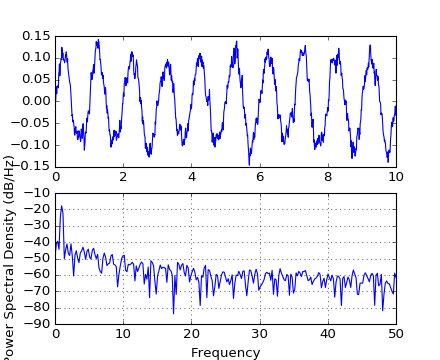
See also
-
specgram() -
specgram()differs in the default overlap; in not returning the mean of the segment periodograms; in returning the times of the segments; and in plotting a colormap instead of a line. -
magnitude_spectrum() -
magnitude_spectrum()plots the magnitude spectrum. -
csd() -
csd()plots the spectral density between two signals.
Notes
In addition to the above described arguments, this function can take a data keyword argument. If such a data argument is given, the following arguments are replaced by data[<arg>]:
- All arguments with the following names: ?x?.
Additional kwargs: hold = [True|False] overrides default hold state
-
matplotlib.pyplot.quiver(*args, **kw) -
Plot a 2-D field of arrows.
call signatures:
quiver(U, V, **kw) quiver(U, V, C, **kw) quiver(X, Y, U, V, **kw) quiver(X, Y, U, V, C, **kw)
Arguments:
- X, Y:
- The x and y coordinates of the arrow locations (default is tail of arrow; see pivot kwarg)
- U, V:
- Give the x and y components of the arrow vectors
- C:
- An optional array used to map colors to the arrows
All arguments may be 1-D or 2-D arrays or sequences. If X and Y are absent, they will be generated as a uniform grid. If U and V are 2-D arrays but X and Y are 1-D, and if
len(X)andlen(Y)match the column and row dimensions of U, then X and Y will be expanded withnumpy.meshgrid().U, V, C may be masked arrays, but masked X, Y are not supported at present.
Keyword arguments:
- units: [ ?width? | ?height? | ?dots? | ?inches? | ?x? | ?y? | ?xy? ]
-
Arrow units; the arrow dimensions except for length are in multiples of this unit.
- ?width? or ?height?: the width or height of the axes
- ?dots? or ?inches?: pixels or inches, based on the figure dpi
- ?x?, ?y?, or ?xy?: X, Y, or sqrt(X^2+Y^2) data units
The arrows scale differently depending on the units. For ?x? or ?y?, the arrows get larger as one zooms in; for other units, the arrow size is independent of the zoom state. For ?width or ?height?, the arrow size increases with the width and height of the axes, respectively, when the window is resized; for ?dots? or ?inches?, resizing does not change the arrows.
- angles: [ ?uv? | ?xy? | array ]
- With the default ?uv?, the arrow axis aspect ratio is 1, so that if U*==*V the orientation of the arrow on the plot is 45 degrees CCW from the horizontal axis (positive to the right). With ?xy?, the arrow points from (x,y) to (x+u, y+v). Use this for plotting a gradient field, for example. Alternatively, arbitrary angles may be specified as an array of values in degrees, CCW from the horizontal axis. Note: inverting a data axis will correspondingly invert the arrows only with
angles='xy'. - scale: [ None | float ]
- Data units per arrow length unit, e.g., m/s per plot width; a smaller scale parameter makes the arrow longer. If None, a simple autoscaling algorithm is used, based on the average vector length and the number of vectors. The arrow length unit is given by the scale_units parameter
- scale_units: None, or any of the units options.
-
For example, if scale_units is ?inches?, scale is 2.0, and
(u,v) = (1,0), then the vector will be 0.5 inches long. If scale_units is ?width?, then the vector will be half the width of the axes.If scale_units is ?x? then the vector will be 0.5 x-axis units. To plot vectors in the x-y plane, with u and v having the same units as x and y, use ?angles=?xy?, scale_units=?xy?, scale=1?.
- width:
- Shaft width in arrow units; default depends on choice of units, above, and number of vectors; a typical starting value is about 0.005 times the width of the plot.
- headwidth: scalar
- Head width as multiple of shaft width, default is 3
- headlength: scalar
- Head length as multiple of shaft width, default is 5
- headaxislength: scalar
- Head length at shaft intersection, default is 4.5
- minshaft: scalar
- Length below which arrow scales, in units of head length. Do not set this to less than 1, or small arrows will look terrible! Default is 1
- minlength: scalar
- Minimum length as a multiple of shaft width; if an arrow length is less than this, plot a dot (hexagon) of this diameter instead. Default is 1.
- pivot: [ ?tail? | ?mid? | ?middle? | ?tip? ]
- The part of the arrow that is at the grid point; the arrow rotates about this point, hence the name pivot.
- color: [ color | color sequence ]
- This is a synonym for the
PolyCollectionfacecolor kwarg. If C has been set, color has no effect.
The defaults give a slightly swept-back arrow; to make the head a triangle, make headaxislength the same as headlength. To make the arrow more pointed, reduce headwidth or increase headlength and headaxislength. To make the head smaller relative to the shaft, scale down all the head parameters. You will probably do best to leave minshaft alone.
linewidths and edgecolors can be used to customize the arrow outlines. Additional
PolyCollectionkeyword arguments:Property Description agg_filterunknown alphafloat or None animated[True | False] antialiasedor antialiasedsBoolean or sequence of booleans arrayunknown axesan Axesinstanceclima length 2 sequence of floats clip_boxa matplotlib.transforms.Bboxinstanceclip_on[True | False] clip_path[ ( Path,Transform) |Patch| None ]cmapa colormap or registered colormap name colormatplotlib color arg or sequence of rgba tuples containsa callable function edgecoloror edgecolorsmatplotlib color spec or sequence of specs facecoloror facecolorsmatplotlib color spec or sequence of specs figurea matplotlib.figure.Figureinstancegidan id string hatch[ ?/? | ?\? | ?|? | ?-? | ?+? | ?x? | ?o? | ?O? | ?.? | ?*? ] labelstring or anything printable with ?%s? conversion. linestyleor linestyles or dashes[?solid? | ?dashed?, ?dashdot?, ?dotted? | (offset, on-off-dash-seq) | '-'|'--'|'-.'|':'|'None'|' '|'']linewidthor linewidths or lwfloat or sequence of floats normunknown offset_positionunknown offsetsfloat or sequence of floats path_effectsunknown picker[None|float|boolean|callable] pickradiusunknown rasterized[True | False | None] sketch_paramsunknown snapunknown transformTransforminstanceurla url string urlsunknown visible[True | False] zorderany number Additional kwargs: hold = [True|False] overrides default hold state
-
matplotlib.pyplot.quiverkey(*args, **kw) -
Add a key to a quiver plot.
Call signature:
quiverkey(Q, X, Y, U, label, **kw)
Arguments:
- Q:
- The Quiver instance returned by a call to quiver.
- X, Y:
- The location of the key; additional explanation follows.
- U:
- The length of the key
- label:
- A string with the length and units of the key
Keyword arguments:
- coordinates = [ ?axes? | ?figure? | ?data? | ?inches? ]
- Coordinate system and units for X, Y: ?axes? and ?figure? are normalized coordinate systems with 0,0 in the lower left and 1,1 in the upper right; ?data? are the axes data coordinates (used for the locations of the vectors in the quiver plot itself); ?inches? is position in the figure in inches, with 0,0 at the lower left corner.
- color:
- overrides face and edge colors from Q.
- labelpos = [ ?N? | ?S? | ?E? | ?W? ]
- Position the label above, below, to the right, to the left of the arrow, respectively.
- labelsep:
- Distance in inches between the arrow and the label. Default is 0.1
- labelcolor:
- defaults to default
Textcolor. - fontproperties:
- A dictionary with keyword arguments accepted by the
FontPropertiesinitializer: family, style, variant, size, weight
Any additional keyword arguments are used to override vector properties taken from Q.
The positioning of the key depends on X, Y, coordinates, and labelpos. If labelpos is ?N? or ?S?, X, Y give the position of the middle of the key arrow. If labelpos is ?E?, X, Y positions the head, and if labelpos is ?W?, X, Y positions the tail; in either of these two cases, X, Y is somewhere in the middle of the arrow+label key object.
Additional kwargs: hold = [True|False] overrides default hold state
-
matplotlib.pyplot.rc(*args, **kwargs) -
Set the current rc params. Group is the grouping for the rc, e.g., for
lines.linewidththe group islines, foraxes.facecolor, the group isaxes, and so on. Group may also be a list or tuple of group names, e.g., (xtick, ytick). kwargs is a dictionary attribute name/value pairs, e.g.,:rc('lines', linewidth=2, color='r')sets the current rc params and is equivalent to:
rcParams['lines.linewidth'] = 2 rcParams['lines.color'] = 'r'
The following aliases are available to save typing for interactive users:
Alias Property ?lw? ?linewidth? ?ls? ?linestyle? ?c? ?color? ?fc? ?facecolor? ?ec? ?edgecolor? ?mew? ?markeredgewidth? ?aa? ?antialiased? Thus you could abbreviate the above rc command as:
rc('lines', lw=2, c='r')Note you can use python?s kwargs dictionary facility to store dictionaries of default parameters. e.g., you can customize the font rc as follows:
font = {'family' : 'monospace', 'weight' : 'bold', 'size' : 'larger'} rc('font', **font) # pass in the font dict as kwargsThis enables you to easily switch between several configurations. Use
rcdefaults()to restore the default rc params after changes.
-
matplotlib.pyplot.rc_context(rc=None, fname=None) -
Return a context manager for managing rc settings.
This allows one to do:
with mpl.rc_context(fname='screen.rc'): plt.plot(x, a) with mpl.rc_context(fname='print.rc'): plt.plot(x, b) plt.plot(x, c)The ?a? vs ?x? and ?c? vs ?x? plots would have settings from ?screen.rc?, while the ?b? vs ?x? plot would have settings from ?print.rc?.
A dictionary can also be passed to the context manager:
with mpl.rc_context(rc={'text.usetex': True}, fname='screen.rc'): plt.plot(x, a)The ?rc? dictionary takes precedence over the settings loaded from ?fname?. Passing a dictionary only is also valid.
-
matplotlib.pyplot.rcdefaults() -
Restore the default rc params. These are not the params loaded by the rc file, but mpl?s internal params. See rc_file_defaults for reloading the default params from the rc file
-
matplotlib.pyplot.rgrids(*args, **kwargs) -
Get or set the radial gridlines on a polar plot.
call signatures:
lines, labels = rgrids() lines, labels = rgrids(radii, labels=None, angle=22.5, **kwargs)
When called with no arguments,
rgrid()simply returns the tuple (lines, labels), where lines is an array of radial gridlines (Line2Dinstances) and labels is an array of tick labels (Textinstances). When called with arguments, the labels will appear at the specified radial distances and angles.labels, if not None, is a len(radii) list of strings of the labels to use at each angle.
If labels is None, the rformatter will be used
Examples:
# set the locations of the radial gridlines and labels lines, labels = rgrids( (0.25, 0.5, 1.0) ) # set the locations and labels of the radial gridlines and labels lines, labels = rgrids( (0.25, 0.5, 1.0), ('Tom', 'Dick', 'Harry' )
-
matplotlib.pyplot.savefig(*args, **kwargs) -
Save the current figure.
Call signature:
savefig(fname, dpi=None, facecolor='w', edgecolor='w', orientation='portrait', papertype=None, format=None, transparent=False, bbox_inches=None, pad_inches=0.1, frameon=None)The output formats available depend on the backend being used.
Arguments:
- fname:
-
A string containing a path to a filename, or a Python file-like object, or possibly some backend-dependent object such as
PdfPages.If format is None and fname is a string, the output format is deduced from the extension of the filename. If the filename has no extension, the value of the rc parameter
savefig.formatis used.If fname is not a string, remember to specify format to ensure that the correct backend is used.
Keyword arguments:
-
dpi: [ None | scalar > 0 | ?figure?] - The resolution in dots per inch. If None it will default to the value
savefig.dpiin the matplotlibrc file. If ?figure? it will set the dpi to be the value of the figure. - facecolor, edgecolor:
- the colors of the figure rectangle
- orientation: [ ?landscape? | ?portrait? ]
- not supported on all backends; currently only on postscript output
- papertype:
- One of ?letter?, ?legal?, ?executive?, ?ledger?, ?a0? through ?a10?, ?b0? through ?b10?. Only supported for postscript output.
- format:
- One of the file extensions supported by the active backend. Most backends support png, pdf, ps, eps and svg.
- transparent:
- If True, the axes patches will all be transparent; the figure patch will also be transparent unless facecolor and/or edgecolor are specified via kwargs. This is useful, for example, for displaying a plot on top of a colored background on a web page. The transparency of these patches will be restored to their original values upon exit of this function.
- frameon:
- If True, the figure patch will be colored, if False, the figure background will be transparent. If not provided, the rcParam ?savefig.frameon? will be used.
- bbox_inches:
- Bbox in inches. Only the given portion of the figure is saved. If ?tight?, try to figure out the tight bbox of the figure.
- pad_inches:
- Amount of padding around the figure when bbox_inches is ?tight?.
- bbox_extra_artists:
- A list of extra artists that will be considered when the tight bbox is calculated.
-
matplotlib.pyplot.sca(ax) -
Set the current Axes instance to ax.
The current Figure is updated to the parent of ax.
-
matplotlib.pyplot.scatter(x, y, s=20, c=None, marker='o', cmap=None, norm=None, vmin=None, vmax=None, alpha=None, linewidths=None, verts=None, edgecolors=None, hold=None, data=None, **kwargs) -
Make a scatter plot of x vs y, where x and y are sequence like objects of the same length.
Parameters: x, y : array_like, shape (n, )
Input data
s : scalar or array_like, shape (n, ), optional, default: 20
size in points^2.
c : color, sequence, or sequence of color, optional, default: ?b?
ccan be a single color format string, or a sequence of color specifications of lengthN, or a sequence ofNnumbers to be mapped to colors using thecmapandnormspecified via kwargs (see below). Note thatcshould not be a single numeric RGB or RGBA sequence because that is indistinguishable from an array of values to be colormapped.ccan be a 2-D array in which the rows are RGB or RGBA, however, including the case of a single row to specify the same color for all points.marker :
MarkerStyle, optional, default: ?o?See
markersfor more information on the different styles of markers scatter supports.markercan be either an instance of the class or the text shorthand for a particular marker.cmap :
Colormap, optional, default: NoneA
Colormapinstance or registered name.cmapis only used ifcis an array of floats. If None, defaults to rcimage.cmap.norm :
Normalize, optional, default: NoneA
Normalizeinstance is used to scale luminance data to 0, 1.normis only used ifcis an array of floats. IfNone, use the defaultnormalize().vmin, vmax : scalar, optional, default: None
vminandvmaxare used in conjunction withnormto normalize luminance data. If either areNone, the min and max of the color array is used. Note if you pass anorminstance, your settings forvminandvmaxwill be ignored.alpha : scalar, optional, default: None
The alpha blending value, between 0 (transparent) and 1 (opaque)
linewidths : scalar or array_like, optional, default: None
If None, defaults to (lines.linewidth,).
edgecolors : color or sequence of color, optional, default: None
If None, defaults to (patch.edgecolor). If ?face?, the edge color will always be the same as the face color. If it is ?none?, the patch boundary will not be drawn. For non-filled markers, the
edgecolorskwarg is ignored; color is determined byc.Returns: paths :
PathCollectionOther Parameters: kwargs :
CollectionpropertiesNotes
In addition to the above described arguments, this function can take a data keyword argument. If such a data argument is given, the following arguments are replaced by data[<arg>]:
- All arguments with the following names: ?y?, ?linewidths?, ?color?, ?facecolor?, ?facecolors?, ?edgecolors?, ?c?, ?s?, ?x?.
Additional kwargs: hold = [True|False] overrides default hold state
Examples
(Source code, png, hires.png, pdf)
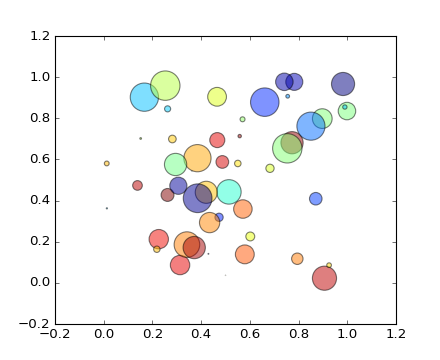
-
matplotlib.pyplot.sci(im) -
Set the current image. This image will be the target of colormap commands like
jet(),hot()orclim()). The current image is an attribute of the current axes.
-
matplotlib.pyplot.semilogx(*args, **kwargs) -
Make a plot with log scaling on the x axis.
Call signature:
semilogx(*args, **kwargs)
semilogx()supports all the keyword arguments ofplot()andmatplotlib.axes.Axes.set_xscale().Notable keyword arguments:
- basex: scalar > 1
- Base of the x logarithm
- subsx: [ None | sequence ]
- The location of the minor xticks; None defaults to autosubs, which depend on the number of decades in the plot; see
set_xscale()for details. - nonposx: [ ?mask? | ?clip? ]
- Non-positive values in x can be masked as invalid, or clipped to a very small positive number
The remaining valid kwargs are
Line2Dproperties:Property Description agg_filterunknown alphafloat (0.0 transparent through 1.0 opaque) animated[True | False] antialiasedor aa[True | False] axesan Axesinstanceclip_boxa matplotlib.transforms.Bboxinstanceclip_on[True | False] clip_path[ ( Path,Transform) |Patch| None ]coloror cany matplotlib color containsa callable function dash_capstyle[?butt? | ?round? | ?projecting?] dash_joinstyle[?miter? | ?round? | ?bevel?] dashessequence of on/off ink in points drawstyle[?default? | ?steps? | ?steps-pre? | ?steps-mid? | ?steps-post?] figurea matplotlib.figure.Figureinstancefillstyle[?full? | ?left? | ?right? | ?bottom? | ?top? | ?none?] gidan id string labelstring or anything printable with ?%s? conversion. linestyleor ls[?solid? | ?dashed?, ?dashdot?, ?dotted? | (offset, on-off-dash-seq) | '-'|'--'|'-.'|':'|'None'|' '|'']linewidthor lwfloat value in points markerA valid marker stylemarkeredgecoloror mecany matplotlib color markeredgewidthor mewfloat value in points markerfacecoloror mfcany matplotlib color markerfacecoloraltor mfcaltany matplotlib color markersizeor msfloat markevery[None | int | length-2 tuple of int | slice | list/array of int | float | length-2 tuple of float] path_effectsunknown pickerfloat distance in points or callable pick function fn(artist, event)pickradiusfloat distance in points rasterized[True | False | None] sketch_paramsunknown snapunknown solid_capstyle[?butt? | ?round? | ?projecting?] solid_joinstyle[?miter? | ?round? | ?bevel?] transforma matplotlib.transforms.Transforminstanceurla url string visible[True | False] xdata1D array ydata1D array zorderany number See also
-
loglog() - For example code and figure
Additional kwargs: hold = [True|False] overrides default hold state
-
matplotlib.pyplot.semilogy(*args, **kwargs) -
Make a plot with log scaling on the y axis.
call signature:
semilogy(*args, **kwargs)
semilogy()supports all the keyword arguments ofplot()andmatplotlib.axes.Axes.set_yscale().Notable keyword arguments:
- basey: scalar > 1
- Base of the y logarithm
- subsy: [ None | sequence ]
- The location of the minor yticks; None defaults to autosubs, which depend on the number of decades in the plot; see
set_yscale()for details. - nonposy: [ ?mask? | ?clip? ]
- Non-positive values in y can be masked as invalid, or clipped to a very small positive number
The remaining valid kwargs are
Line2Dproperties:Property Description agg_filterunknown alphafloat (0.0 transparent through 1.0 opaque) animated[True | False] antialiasedor aa[True | False] axesan Axesinstanceclip_boxa matplotlib.transforms.Bboxinstanceclip_on[True | False] clip_path[ ( Path,Transform) |Patch| None ]coloror cany matplotlib color containsa callable function dash_capstyle[?butt? | ?round? | ?projecting?] dash_joinstyle[?miter? | ?round? | ?bevel?] dashessequence of on/off ink in points drawstyle[?default? | ?steps? | ?steps-pre? | ?steps-mid? | ?steps-post?] figurea matplotlib.figure.Figureinstancefillstyle[?full? | ?left? | ?right? | ?bottom? | ?top? | ?none?] gidan id string labelstring or anything printable with ?%s? conversion. linestyleor ls[?solid? | ?dashed?, ?dashdot?, ?dotted? | (offset, on-off-dash-seq) | '-'|'--'|'-.'|':'|'None'|' '|'']linewidthor lwfloat value in points markerA valid marker stylemarkeredgecoloror mecany matplotlib color markeredgewidthor mewfloat value in points markerfacecoloror mfcany matplotlib color markerfacecoloraltor mfcaltany matplotlib color markersizeor msfloat markevery[None | int | length-2 tuple of int | slice | list/array of int | float | length-2 tuple of float] path_effectsunknown pickerfloat distance in points or callable pick function fn(artist, event)pickradiusfloat distance in points rasterized[True | False | None] sketch_paramsunknown snapunknown solid_capstyle[?butt? | ?round? | ?projecting?] solid_joinstyle[?miter? | ?round? | ?bevel?] transforma matplotlib.transforms.Transforminstanceurla url string visible[True | False] xdata1D array ydata1D array zorderany number See also
-
loglog() - For example code and figure
Additional kwargs: hold = [True|False] overrides default hold state
-
matplotlib.pyplot.set_cmap(cmap) -
Set the default colormap. Applies to the current image if any. See help(colormaps) for more information.
cmap must be a
Colormapinstance, or the name of a registered colormap.See
matplotlib.cm.register_cmap()andmatplotlib.cm.get_cmap().
-
matplotlib.pyplot.setp(*args, **kwargs) -
Set a property on an artist object.
matplotlib supports the use of
setp()(?set property?) andgetp()to set and get object properties, as well as to do introspection on the object. For example, to set the linestyle of a line to be dashed, you can do:>>> line, = plot([1,2,3]) >>> setp(line, linestyle='--')
If you want to know the valid types of arguments, you can provide the name of the property you want to set without a value:
>>> setp(line, 'linestyle') linestyle: [ '-' | '--' | '-.' | ':' | 'steps' | 'None' ]If you want to see all the properties that can be set, and their possible values, you can do:
>>> setp(line) ... long output listing omittedsetp()operates on a single instance or a list of instances. If you are in query mode introspecting the possible values, only the first instance in the sequence is used. When actually setting values, all the instances will be set. e.g., suppose you have a list of two lines, the following will make both lines thicker and red:>>> x = arange(0,1.0,0.01) >>> y1 = sin(2*pi*x) >>> y2 = sin(4*pi*x) >>> lines = plot(x, y1, x, y2) >>> setp(lines, linewidth=2, color='r')
setp()works with the MATLAB style string/value pairs or with python kwargs. For example, the following are equivalent:>>> setp(lines, 'linewidth', 2, 'color', 'r') # MATLAB style >>> setp(lines, linewidth=2, color='r') # python style
-
matplotlib.pyplot.show(*args, **kw) -
Display a figure. When running in ipython with its pylab mode, display all figures and return to the ipython prompt.
In non-interactive mode, display all figures and block until the figures have been closed; in interactive mode it has no effect unless figures were created prior to a change from non-interactive to interactive mode (not recommended). In that case it displays the figures but does not block.
A single experimental keyword argument, block, may be set to True or False to override the blocking behavior described above.
-
matplotlib.pyplot.specgram(x, NFFT=None, Fs=None, Fc=None, detrend=None, window=None, noverlap=None, cmap=None, xextent=None, pad_to=None, sides=None, scale_by_freq=None, mode=None, scale=None, vmin=None, vmax=None, hold=None, data=None, **kwargs) -
Plot a spectrogram.
Call signature:
specgram(x, NFFT=256, Fs=2, Fc=0, detrend=mlab.detrend_none, window=mlab.window_hanning, noverlap=128, cmap=None, xextent=None, pad_to=None, sides='default', scale_by_freq=None, mode='default', scale='default', **kwargs)Compute and plot a spectrogram of data in x. Data are split into NFFT length segments and the spectrum of each section is computed. The windowing function window is applied to each segment, and the amount of overlap of each segment is specified with noverlap. The spectrogram is plotted as a colormap (using imshow).
- x: 1-D array or sequence
- Array or sequence containing the data
Keyword arguments:
- Fs: scalar
- The sampling frequency (samples per time unit). It is used to calculate the Fourier frequencies, freqs, in cycles per time unit. The default value is 2.
- window: callable or ndarray
- A function or a vector of length NFFT. To create window vectors see
window_hanning(),window_none(),numpy.blackman(),numpy.hamming(),numpy.bartlett(),scipy.signal(),scipy.signal.get_window(), etc. The default iswindow_hanning(). If a function is passed as the argument, it must take a data segment as an argument and return the windowed version of the segment. - sides: [ ?default? | ?onesided? | ?twosided? ]
- Specifies which sides of the spectrum to return. Default gives the default behavior, which returns one-sided for real data and both for complex data. ?onesided? forces the return of a one-sided spectrum, while ?twosided? forces two-sided.
- pad_to: integer
- The number of points to which the data segment is padded when performing the FFT. This can be different from NFFT, which specifies the number of data points used. While not increasing the actual resolution of the spectrum (the minimum distance between resolvable peaks), this can give more points in the plot, allowing for more detail. This corresponds to the n parameter in the call to fft(). The default is None, which sets pad_to equal to NFFT
- NFFT: integer
- The number of data points used in each block for the FFT. A power 2 is most efficient. The default value is 256. This should NOT be used to get zero padding, or the scaling of the result will be incorrect. Use pad_to for this instead.
- detrend: [ ?default? | ?constant? | ?mean? | ?linear? | ?none?] or
- callable
The function applied to each segment before fft-ing, designed to remove the mean or linear trend. Unlike in MATLAB, where the detrend parameter is a vector, in matplotlib is it a function. The
pylabmodule definesdetrend_none(),detrend_mean(), anddetrend_linear(), but you can use a custom function as well. You can also use a string to choose one of the functions. ?default?, ?constant?, and ?mean? calldetrend_mean(). ?linear? callsdetrend_linear(). ?none? callsdetrend_none(). - scale_by_freq: boolean
- Specifies whether the resulting density values should be scaled by the scaling frequency, which gives density in units of Hz^-1. This allows for integration over the returned frequency values. The default is True for MATLAB compatibility.
- mode: [ ?default? | ?psd? | ?magnitude? | ?angle? | ?phase? ]
- What sort of spectrum to use. Default is ?psd?. which takes the power spectral density. ?complex? returns the complex-valued frequency spectrum. ?magnitude? returns the magnitude spectrum. ?angle? returns the phase spectrum without unwrapping. ?phase? returns the phase spectrum with unwrapping.
- noverlap: integer
- The number of points of overlap between blocks. The default value is 128.
- scale: [ ?default? | ?linear? | ?dB? ]
- The scaling of the values in the spec. ?linear? is no scaling. ?dB? returns the values in dB scale. When mode is ?psd?, this is dB power (10 * log10). Otherwise this is dB amplitude (20 * log10). ?default? is ?dB? if mode is ?psd? or ?magnitude? and ?linear? otherwise. This must be ?linear? if mode is ?angle? or ?phase?.
- Fc: integer
- The center frequency of x (defaults to 0), which offsets the x extents of the plot to reflect the frequency range used when a signal is acquired and then filtered and downsampled to baseband.
- cmap:
- A
matplotlib.colors.Colormapinstance; if None, use default determined by rc - xextent:
- The image extent along the x-axis. xextent = (xmin,xmax) The default is (0,max(bins)), where bins is the return value from
specgram() - kwargs:
- Additional kwargs are passed on to imshow which makes the specgram image
Note
detrend and scale_by_freq only apply when mode is set to ?psd?
Returns the tuple (spectrum, freqs, t, im):
- spectrum: 2-D array
- columns are the periodograms of successive segments
- freqs: 1-D array
- The frequencies corresponding to the rows in spectrum
- t: 1-D array
- The times corresponding to midpoints of segments (i.e the columns in spectrum)
-
im: instance of classAxesImage - The image created by imshow containing the spectrogram
Example:
(Source code, png, hires.png, pdf)
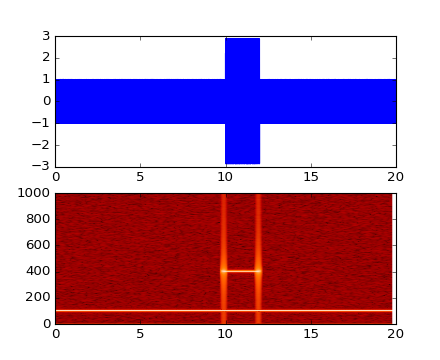
See also
-
psd() -
psd()differs in the default overlap; in returning the mean of the segment periodograms; in not returning times; and in generating a line plot instead of colormap. -
magnitude_spectrum() - A single spectrum, similar to having a single segment when mode is ?magnitude?. Plots a line instead of a colormap.
-
angle_spectrum() - A single spectrum, similar to having a single segment when mode is ?angle?. Plots a line instead of a colormap.
-
phase_spectrum() - A single spectrum, similar to having a single segment when mode is ?phase?. Plots a line instead of a colormap.
Notes
In addition to the above described arguments, this function can take a data keyword argument. If such a data argument is given, the following arguments are replaced by data[<arg>]:
- All arguments with the following names: ?x?.
Additional kwargs: hold = [True|False] overrides default hold state
-
matplotlib.pyplot.spectral() -
set the default colormap to spectral and apply to current image if any. See help(colormaps) for more information
-
matplotlib.pyplot.spring() -
set the default colormap to spring and apply to current image if any. See help(colormaps) for more information
-
matplotlib.pyplot.spy(Z, precision=0, marker=None, markersize=None, aspect='equal', hold=None, **kwargs) -
Plot the sparsity pattern on a 2-D array.
spy(Z)plots the sparsity pattern of the 2-D array Z.Parameters: Z : sparse array (n, m)
The array to be plotted.
precision : float, optional, default: 0
If precision is 0, any non-zero value will be plotted; else, values of
 will be plotted.
will be plotted.For
scipy.sparse.spmatrixinstances, there is a special case: if precision is ?present?, any value present in the array will be plotted, even if it is identically zero.origin : [?upper?, ?lower?], optional, default: ?upper?
Place the [0,0] index of the array in the upper left or lower left corner of the axes.
aspect : [?auto? | ?equal? | scalar], optional, default: ?equal?
If ?equal?, and
extentis None, changes the axes aspect ratio to match that of the image. Ifextentis notNone, the axes aspect ratio is changed to match that of the extent.If ?auto?, changes the image aspect ratio to match that of the axes.
If None, default to rc
image.aspectvalue.Two plotting styles are available: image or marker. Both
are available for full arrays, but only the marker style
works for :class:`scipy.sparse.spmatrix` instances.
If *marker* and *markersize* are *None*, an image will be
returned and any remaining kwargs are passed to
:func:`~matplotlib.pyplot.imshow`; else, a
:class:`~matplotlib.lines.Line2D` object will be returned with
the value of marker determining the marker type, and any
remaining kwargs passed to the
:meth:`~matplotlib.axes.Axes.plot` method.
If *marker* and *markersize* are *None*, useful kwargs include:
* *cmap*
* *alpha*
-
matplotlib.pyplot.stackplot(x, *args, **kwargs) -
Draws a stacked area plot.
x : 1d array of dimension N
- y
-
1xN. The data is assumed to be unstacked. Each of the following calls is legal:
stackplot(x, y) # where y is MxN stackplot(x, y1, y2, y3, y4) # where y1, y2, y3, y4, are all 1xNm
Keyword arguments:
- baseline
: [?zero?, ?sym?, ?wiggle?, ?weighted_wiggle?]Method used to calculate the baseline. ?zero? is just a simple stacked plot. ?sym? is symmetric around zero and is sometimes called ThemeRiver. ?wiggle? minimizes the sum of the squared slopes. ?weighted_wiggle? does the same but weights to account for size of each layer. It is also called Streamgraph-layout. More details can be found at http://www.leebyron.com/else/streamgraph/.
labels : A list or tuple of labels to assign to each data series.
- colors
: A list or tuple of colors. These will be cycled through andused to colour the stacked areas. All other keyword arguments are passed to fill_between()
Returns r : A list of PolyCollection, one for each element in the stacked area plot.
Additional kwargs: hold = [True|False] overrides default hold state
-
matplotlib.pyplot.stem(*args, **kwargs) -
Create a stem plot.
Call signatures:
stem(y, linefmt='b-', markerfmt='bo', basefmt='r-') stem(x, y, linefmt='b-', markerfmt='bo', basefmt='r-')
A stem plot plots vertical lines (using linefmt) at each x location from the baseline to y, and places a marker there using markerfmt. A horizontal line at 0 is is plotted using basefmt.
If no x values are provided, the default is (0, 1, ..., len(y) - 1)
Return value is a tuple (markerline, stemlines, baseline).
See also
This document for details.
Example:
(Source code, png, hires.png, pdf)

Notes
In addition to the above described arguments, this function can take a data keyword argument. If such a data argument is given, the following arguments are replaced by data[<arg>]:
- All positional and all keyword arguments.
Additional kwargs: hold = [True|False] overrides default hold state
-
matplotlib.pyplot.step(x, y, *args, **kwargs) -
Make a step plot.
Call signature:
step(x, y, *args, **kwargs)
Additional keyword args to
step()are the same as those forplot().x and y must be 1-D sequences, and it is assumed, but not checked, that x is uniformly increasing.
Keyword arguments:
- where: [ ?pre? | ?post? | ?mid? ]
-
If ?pre? (the default), the interval from x[i] to x[i+1] has level y[i+1].
If ?post?, that interval has level y[i].
If ?mid?, the jumps in y occur half-way between the x-values.
Return value is a list of lines that were added.
Notes
In addition to the above described arguments, this function can take a data keyword argument. If such a data argument is given, the following arguments are replaced by data[<arg>]:
- All arguments with the following names: ?y?, ?x?.
Additional kwargs: hold = [True|False] overrides default hold state
-
matplotlib.pyplot.streamplot(x, y, u, v, density=1, linewidth=None, color=None, cmap=None, norm=None, arrowsize=1, arrowstyle='-|>', minlength=0.1, transform=None, zorder=1, start_points=None, hold=None, data=None) -
Draws streamlines of a vector flow.
- x, y
- an evenly spaced grid.
- u, v
: 2d arraysx and y-velocities. Number of rows should match length of y, and the number of columns should match x. density : float or 2-tupleControls the closeness of streamlines. When density = 1, the domain is divided into a 30x30 grid?density linearly scales this grid. Each cell in the grid can have, at most, one traversing streamline. For different densities in each direction, use [density_x, density_y]. linewidth : numeric or 2d arrayvary linewidth when given a 2d array with the same shape as velocities. color : matplotlib color code, or 2d arrayStreamline color. When given an array with the same shape as velocities, color values are converted to colors using cmap. cmap : ColormapColormap used to plot streamlines and arrows. Only necessary when using an array input for color. norm : NormalizeNormalize object used to scale luminance data to 0, 1. If None, stretch (min, max) to (0, 1). Only necessary when color is an array. arrowsize : floatFactor scale arrow size. arrowstyle : strArrow style specification. See FancyArrowPatch. minlength : floatMinimum length of streamline in axes coordinates.
start_points: Nx2 array Coordinates of starting points for the streamlines. In data coordinates, the same as the x and y arrays. zorder : intany number
Returns:
- stream_container
: StreamplotSet
Container object with attributes
- lines:
matplotlib.collections.LineCollectionof streamlines - arrows: collection of
matplotlib.patches.FancyArrowPatchobjects representing arrows half-way along stream lines.
This container will probably change in the future to allow changes to the colormap, alpha, etc. for both lines and arrows, but these changes should be backward compatible.
Additional kwargs: hold = [True|False] overrides default hold state
-
matplotlib.pyplot.subplot(*args, **kwargs) -
Return a subplot axes positioned by the given grid definition.
Typical call signature:
subplot(nrows, ncols, plot_number)
Where nrows and ncols are used to notionally split the figure into
nrows * ncolssub-axes, and plot_number is used to identify the particular subplot that this function is to create within the notional grid. plot_number starts at 1, increments across rows first and has a maximum ofnrows * ncols.In the case when nrows, ncols and plot_number are all less than 10, a convenience exists, such that the a 3 digit number can be given instead, where the hundreds represent nrows, the tens represent ncols and the units represent plot_number. For instance:
subplot(211)
produces a subaxes in a figure which represents the top plot (i.e. the first) in a 2 row by 1 column notional grid (no grid actually exists, but conceptually this is how the returned subplot has been positioned).
Note
Creating a new subplot with a position which is entirely inside a pre-existing axes will trigger the larger axes to be deleted:
import matplotlib.pyplot as plt # plot a line, implicitly creating a subplot(111) plt.plot([1,2,3]) # now create a subplot which represents the top plot of a grid # with 2 rows and 1 column. Since this subplot will overlap the # first, the plot (and its axes) previously created, will be removed plt.subplot(211) plt.plot(range(12)) plt.subplot(212, axisbg='y') # creates 2nd subplot with yellow background
If you do not want this behavior, use the
add_subplot()method or theaxes()function instead.Keyword arguments:
- axisbg:
- The background color of the subplot, which can be any valid color specifier. See
matplotlib.colorsfor more information. - polar:
- A boolean flag indicating whether the subplot plot should be a polar projection. Defaults to False.
- projection:
- A string giving the name of a custom projection to be used for the subplot. This projection must have been previously registered. See
matplotlib.projections.
See also
Example:
(Source code, png, hires.png, pdf)
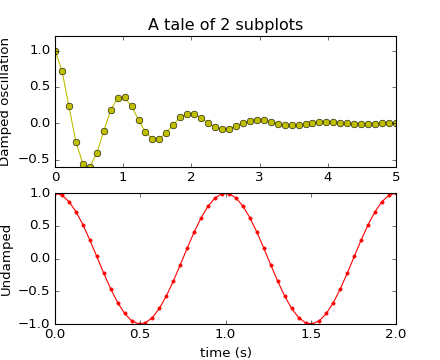
-
matplotlib.pyplot.subplot2grid(shape, loc, rowspan=1, colspan=1, **kwargs) -
Create a subplot in a grid. The grid is specified by shape, at location of loc, spanning rowspan, colspan cells in each direction. The index for loc is 0-based.
subplot2grid(shape, loc, rowspan=1, colspan=1)
is identical to
gridspec=GridSpec(shape[0], shape[1]) subplotspec=gridspec.new_subplotspec(loc, rowspan, colspan) subplot(subplotspec)
-
matplotlib.pyplot.subplot_tool(targetfig=None) -
Launch a subplot tool window for a figure.
A
matplotlib.widgets.SubplotToolinstance is returned.
-
matplotlib.pyplot.subplots(nrows=1, ncols=1, sharex=False, sharey=False, squeeze=True, subplot_kw=None, gridspec_kw=None, **fig_kw) -
Create a figure with a set of subplots already made.
This utility wrapper makes it convenient to create common layouts of subplots, including the enclosing figure object, in a single call.
Keyword arguments:
- nrows
- Number of rows of the subplot grid. Defaults to 1.
- ncols
: intNumber of columns of the subplot grid. Defaults to 1. sharex : string or boolIf True, the X axis will be shared amongst all subplots. If True and you have multiple rows, the x tick labels on all but the last row of plots will have visible set to False If a string must be one of ?row?, ?col?, ?all?, or ?none?. ?all? has the same effect as True, ?none? has the same effect as False. If ?row?, each subplot row will share a X axis. If ?col?, each subplot column will share a X axis and the x tick labels on all but the last row will have visible set to False. sharey : string or boolIf True, the Y axis will be shared amongst all subplots. If True and you have multiple columns, the y tick labels on all but the first column of plots will have visible set to False If a string must be one of ?row?, ?col?, ?all?, or ?none?. ?all? has the same effect as True, ?none? has the same effect as False. If ?row?, each subplot row will share a Y axis and the y tick labels on all but the first column will have visible set to False. If ?col?, each subplot column will share a Y axis. squeeze : bool
If True, extra dimensions are squeezed out from the returned axis object:
- if only one subplot is constructed (nrows=ncols=1), the resulting single Axis object is returned as a scalar.
- for Nx1 or 1xN subplots, the returned object is a 1-d numpy object array of Axis objects are returned as numpy 1-d arrays.
- for NxM subplots with N>1 and M>1 are returned as a 2d array.
If False, no squeezing at all is done: the returned axis object is always a 2-d array containing Axis instances, even if it ends up being 1x1.
subplot_kw
: dictDict with keywords passed to the add_subplot() call used to create each subplots. gridspec_kw : dictDict with keywords passed to the GridSpec constructor used to create the grid the subplots are placed on. fig_kw : dictDict with keywords passed to the figure() call. Note that all keywords not recognized above will be automatically included here.
Returns:
fig, ax : tuple
-
fig is the
matplotlib.figure.Figureobject - ax can be either a single axis object or an array of axis objects if more than one subplot was created. The dimensions of the resulting array can be controlled with the squeeze keyword, see above.
Examples:
x = np.linspace(0, 2*np.pi, 400)
y = np.sin(x**2)
# Just a figure and one subplot
f, ax = plt.subplots()
ax.plot(x, y)
ax.set_title('Simple plot')
# Two subplots, unpack the output array immediately
f, (ax1, ax2) = plt.subplots(1, 2, sharey=True)
ax1.plot(x, y)
ax1.set_title('Sharing Y axis')
ax2.scatter(x, y)
# Four polar axes
plt.subplots(2, 2, subplot_kw=dict(polar=True))
# Share a X axis with each column of subplots
plt.subplots(2, 2, sharex='col')
# Share a Y axis with each row of subplots
plt.subplots(2, 2, sharey='row')
# Share a X and Y axis with all subplots
plt.subplots(2, 2, sharex='all', sharey='all')
# same as
plt.subplots(2, 2, sharex=True, sharey=True)
-
matplotlib.pyplot.subplots_adjust(*args, **kwargs) -
Tune the subplot layout.
call signature:
subplots_adjust(left=None, bottom=None, right=None, top=None, wspace=None, hspace=None)The parameter meanings (and suggested defaults) are:
left = 0.125 # the left side of the subplots of the figure right = 0.9 # the right side of the subplots of the figure bottom = 0.1 # the bottom of the subplots of the figure top = 0.9 # the top of the subplots of the figure wspace = 0.2 # the amount of width reserved for blank space between subplots hspace = 0.2 # the amount of height reserved for white space between subplots
The actual defaults are controlled by the rc file
-
matplotlib.pyplot.summer() -
set the default colormap to summer and apply to current image if any. See help(colormaps) for more information
-
matplotlib.pyplot.suptitle(*args, **kwargs) -
Add a centered title to the figure.
kwargs are
matplotlib.text.Textproperties. Using figure coordinates, the defaults are:- x
- The x location of the text in figure coords
- y
: 0.98The y location of the text in figure coords horizontalalignment : ?center?The horizontal alignment of the text verticalalignment : ?top?The vertical alignment of the text
A matplotlib.text.Text instance is returned.
Example:
fig.suptitle('this is the figure title', fontsize=12)
-
matplotlib.pyplot.switch_backend(newbackend) -
Switch the default backend. This feature is experimental, and is only expected to work switching to an image backend. e.g., if you have a bunch of PostScript scripts that you want to run from an interactive ipython session, you may want to switch to the PS backend before running them to avoid having a bunch of GUI windows popup. If you try to interactively switch from one GUI backend to another, you will explode.
Calling this command will close all open windows.
-
matplotlib.pyplot.table(**kwargs) -
Add a table to the current axes.
Call signature:
table(cellText=None, cellColours=None, cellLoc='right', colWidths=None, rowLabels=None, rowColours=None, rowLoc='left', colLabels=None, colColours=None, colLoc='center', loc='bottom', bbox=None):Returns a
matplotlib.table.Tableinstance. For finer grained control over tables, use theTableclass and add it to the axes withadd_table().Thanks to John Gill for providing the class and table.
kwargs control the
Tableproperties:Property Description agg_filterunknown alphafloat (0.0 transparent through 1.0 opaque) animated[True | False] axesan Axesinstanceclip_boxa matplotlib.transforms.Bboxinstanceclip_on[True | False] clip_path[ ( Path,Transform) |Patch| None ]containsa callable function figurea matplotlib.figure.Figureinstancefontsizea float in points gidan id string labelstring or anything printable with ?%s? conversion. path_effectsunknown picker[None|float|boolean|callable] rasterized[True | False | None] sketch_paramsunknown snapunknown transformTransforminstanceurla url string visible[True | False] zorderany number
-
matplotlib.pyplot.text(x, y, s, fontdict=None, withdash=False, **kwargs) -
Add text to the axes.
Add text in string
sto axis at locationx,y, data coordinates.Parameters: x, y : scalars
data coordinates
s : string
text
fontdict : dictionary, optional, default: None
A dictionary to override the default text properties. If fontdict is None, the defaults are determined by your rc parameters.
withdash : boolean, optional, default: False
Creates a
TextWithDashinstance instead of aTextinstance.Other Parameters: kwargs :
Textproperties.Other miscellaneous text parameters.
Examples
Individual keyword arguments can be used to override any given parameter:
>>> text(x, y, s, fontsize=12)
The default transform specifies that text is in data coords, alternatively, you can specify text in axis coords (0,0 is lower-left and 1,1 is upper-right). The example below places text in the center of the axes:
>>> text(0.5, 0.5,'matplotlib', horizontalalignment='center', ... verticalalignment='center', ... transform=ax.transAxes)
You can put a rectangular box around the text instance (e.g., to set a background color) by using the keyword
bbox.bboxis a dictionary ofRectangleproperties. For example:>>> text(x, y, s, bbox=dict(facecolor='red', alpha=0.5))
-
matplotlib.pyplot.thetagrids(*args, **kwargs) -
Get or set the theta locations of the gridlines in a polar plot.
If no arguments are passed, return a tuple (lines, labels) where lines is an array of radial gridlines (
Line2Dinstances) and labels is an array of tick labels (Textinstances):lines, labels = thetagrids()
Otherwise the syntax is:
lines, labels = thetagrids(angles, labels=None, fmt='%d', frac = 1.1)
set the angles at which to place the theta grids (these gridlines are equal along the theta dimension).
angles is in degrees.
labels, if not None, is a len(angles) list of strings of the labels to use at each angle.
If labels is None, the labels will be
fmt%angle.frac is the fraction of the polar axes radius at which to place the label (1 is the edge). e.g., 1.05 is outside the axes and 0.95 is inside the axes.
Return value is a list of tuples (lines, labels):
Note that on input, the labels argument is a list of strings, and on output it is a list of
Textinstances.Examples:
# set the locations of the radial gridlines and labels lines, labels = thetagrids( range(45,360,90) ) # set the locations and labels of the radial gridlines and labels lines, labels = thetagrids( range(45,360,90), ('NE', 'NW', 'SW','SE') )
-
matplotlib.pyplot.tick_params(axis='both', **kwargs) -
Change the appearance of ticks and tick labels.
Keyword arguments:
- axis
- Axis on which to operate; default is ?both?.
- reset
: [True | False]If True, set all parameters to defaults before processing other keyword arguments. Default is False. which : [?major? | ?minor? | ?both?]Default is ?major?; apply arguments to which ticks. direction : [?in? | ?out? | ?inout?]Puts ticks inside the axes, outside the axes, or both. length Tick length in points. width Tick width in points. color Tick color; accepts any mpl color spec. pad Distance in points between tick and label. labelsize Tick label font size in points or as a string (e.g., ?large?). labelcolor Tick label color; mpl color spec. colors Changes the tick color and the label color to the same value: mpl color spec. zorder Tick and label zorder. bottom, top, left, right : [bool | ?on? | ?off?]controls whether to draw the respective ticks. labelbottom, labeltop, labelleft, labelright Boolean or [?on? | ?off?], controls whether to draw the respective tick labels.
Example:
ax.tick_params(direction='out', length=6, width=2, colors='r')
This will make all major ticks be red, pointing out of the box, and with dimensions 6 points by 2 points. Tick labels will also be red.
-
matplotlib.pyplot.ticklabel_format(**kwargs) -
Change the
ScalarFormatterused by default for linear axes.Optional keyword arguments:
Keyword Description style [ ?sci? (or ?scientific?) | ?plain? ] plain turns off scientific notation scilimits (m, n), pair of integers; if style is ?sci?, scientific notation will be used for numbers outside the range 10`m`:sup: to 10`n`:sup:. Use (0,0) to include all numbers. useOffset [True | False | offset]; if True, the offset will be calculated as needed; if False, no offset will be used; if a numeric offset is specified, it will be used. axis [ ?x? | ?y? | ?both? ] useLocale If True, format the number according to the current locale. This affects things such as the character used for the decimal separator. If False, use C-style (English) formatting. The default setting is controlled by the axes.formatter.use_locale rcparam. Only the major ticks are affected. If the method is called when the
ScalarFormatteris not theFormatterbeing used, anAttributeErrorwill be raised.
-
matplotlib.pyplot.tight_layout(pad=1.08, h_pad=None, w_pad=None, rect=None) -
Automatically adjust subplot parameters to give specified padding.
Parameters:
- pad
- padding between the figure edge and the edges of subplots, as a fraction of the font-size.
- h_pad, w_pad
: floatpadding (height/width) between edges of adjacent subplots. Defaults to pad_inches. rect : if rect is given, it is interpreted as a rectangle(left, bottom, right, top) in the normalized figure coordinate that the whole subplots area (including labels) will fit into. Default is (0, 0, 1, 1).
-
matplotlib.pyplot.title(s, *args, **kwargs) -
Set a title of the current axes.
Set one of the three available axes titles. The available titles are positioned above the axes in the center, flush with the left edge, and flush with the right edge.
See also
See
text()for adding text to the current axesParameters: label : str
Text to use for the title
fontdict : dict
A dictionary controlling the appearance of the title text, the default
fontdictis:{?fontsize?: rcParams[?axes.titlesize?], ?fontweight? : rcParams[?axes.titleweight?], ?verticalalignment?: ?baseline?, ?horizontalalignment?: loc}
loc : {?center?, ?left?, ?right?}, str, optional
Which title to set, defaults to ?center?
Returns: text :
TextThe matplotlib text instance representing the title
Other Parameters: kwargs : text properties
Other keyword arguments are text properties, see
Textfor a list of valid text properties.
-
matplotlib.pyplot.tricontour(*args, **kwargs) -
Draw contours on an unstructured triangular grid.
tricontour()andtricontourf()draw contour lines and filled contours, respectively. Except as noted, function signatures and return values are the same for both versions.The triangulation can be specified in one of two ways; either:
tricontour(triangulation, ...)
where triangulation is a
matplotlib.tri.Triangulationobject, ortricontour(x, y, ...) tricontour(x, y, triangles, ...) tricontour(x, y, triangles=triangles, ...) tricontour(x, y, mask=mask, ...) tricontour(x, y, triangles, mask=mask, ...)
in which case a Triangulation object will be created. See
Triangulationfor a explanation of these possibilities.The remaining arguments may be:
tricontour(..., Z)
where Z is the array of values to contour, one per point in the triangulation. The level values are chosen automatically.
tricontour(..., Z, N)
contour N automatically-chosen levels.
tricontour(..., Z, V)
draw contour lines at the values specified in sequence V, which must be in increasing order.
tricontourf(..., Z, V)
fill the (len(V)-1) regions between the values in V, which must be in increasing order.
tricontour(Z, **kwargs)
Use keyword args to control colors, linewidth, origin, cmap ... see below for more details.
C = tricontour(...)returns aTriContourSetobject.Optional keyword arguments:
- colors: [ None | string | (mpl_colors) ]
-
If None, the colormap specified by cmap will be used.
If a string, like ?r? or ?red?, all levels will be plotted in this color.
If a tuple of matplotlib color args (string, float, rgb, etc), different levels will be plotted in different colors in the order specified.
- alpha: float
- The alpha blending value
- cmap: [ None | Colormap ]
- A cm
Colormapinstance or None. If cmap is None and colors is None, a default Colormap is used. - norm: [ None | Normalize ]
- A
matplotlib.colors.Normalizeinstance for scaling data values to colors. If norm is None and colors is None, the default linear scaling is used. - levels [level0, level1, ..., leveln]
- A list of floating point numbers indicating the level curves to draw, in increasing order; e.g., to draw just the zero contour pass
levels=[0] - origin: [ None | ?upper? | ?lower? | ?image? ]
-
If None, the first value of Z will correspond to the lower left corner, location (0,0). If ?image?, the rc value for
image.originwill be used.This keyword is not active if X and Y are specified in the call to contour.
extent: [ None | (x0,x1,y0,y1) ]
If origin is not None, then extent is interpreted as in
matplotlib.pyplot.imshow(): it gives the outer pixel boundaries. In this case, the position of Z[0,0] is the center of the pixel, not a corner. If origin is None, then (x0, y0) is the position of Z[0,0], and (x1, y1) is the position of Z[-1,-1].This keyword is not active if X and Y are specified in the call to contour.
- locator: [ None | ticker.Locator subclass ]
- If locator is None, the default
MaxNLocatoris used. The locator is used to determine the contour levels if they are not given explicitly via the V argument. - extend: [ ?neither? | ?both? | ?min? | ?max? ]
- Unless this is ?neither?, contour levels are automatically added to one or both ends of the range so that all data are included. These added ranges are then mapped to the special colormap values which default to the ends of the colormap range, but can be set via
matplotlib.colors.Colormap.set_under()andmatplotlib.colors.Colormap.set_over()methods. - xunits, yunits: [ None | registered units ]
- Override axis units by specifying an instance of a
matplotlib.units.ConversionInterface.
tricontour-only keyword arguments:
- linewidths: [ None | number | tuple of numbers ]
-
If linewidths is None, the default width in
lines.linewidthinmatplotlibrcis used.If a number, all levels will be plotted with this linewidth.
If a tuple, different levels will be plotted with different linewidths in the order specified
- linestyles: [ None | ?solid? | ?dashed? | ?dashdot? | ?dotted? ]
-
If linestyles is None, the ?solid? is used.
linestyles can also be an iterable of the above strings specifying a set of linestyles to be used. If this iterable is shorter than the number of contour levels it will be repeated as necessary.
If contour is using a monochrome colormap and the contour level is less than 0, then the linestyle specified in
contour.negative_linestyleinmatplotlibrcwill be used.
tricontourf-only keyword arguments:
- antialiased: [ True | False ]
- enable antialiasing
Note: tricontourf fills intervals that are closed at the top; that is, for boundaries z1 and z2, the filled region is:
z1 < z <= z2
There is one exception: if the lowest boundary coincides with the minimum value of the z array, then that minimum value will be included in the lowest interval.
Examples:
Additional kwargs: hold = [True|False] overrides default hold state
-
matplotlib.pyplot.tricontourf(*args, **kwargs) -
Draw contours on an unstructured triangular grid.
tricontour()andtricontourf()draw contour lines and filled contours, respectively. Except as noted, function signatures and return values are the same for both versions.The triangulation can be specified in one of two ways; either:
tricontour(triangulation, ...)
where triangulation is a
matplotlib.tri.Triangulationobject, ortricontour(x, y, ...) tricontour(x, y, triangles, ...) tricontour(x, y, triangles=triangles, ...) tricontour(x, y, mask=mask, ...) tricontour(x, y, triangles, mask=mask, ...)
in which case a Triangulation object will be created. See
Triangulationfor a explanation of these possibilities.The remaining arguments may be:
tricontour(..., Z)
where Z is the array of values to contour, one per point in the triangulation. The level values are chosen automatically.
tricontour(..., Z, N)
contour N automatically-chosen levels.
tricontour(..., Z, V)
draw contour lines at the values specified in sequence V, which must be in increasing order.
tricontourf(..., Z, V)
fill the (len(V)-1) regions between the values in V, which must be in increasing order.
tricontour(Z, **kwargs)
Use keyword args to control colors, linewidth, origin, cmap ... see below for more details.
C = tricontour(...)returns aTriContourSetobject.Optional keyword arguments:
- colors: [ None | string | (mpl_colors) ]
-
If None, the colormap specified by cmap will be used.
If a string, like ?r? or ?red?, all levels will be plotted in this color.
If a tuple of matplotlib color args (string, float, rgb, etc), different levels will be plotted in different colors in the order specified.
- alpha: float
- The alpha blending value
- cmap: [ None | Colormap ]
- A cm
Colormapinstance or None. If cmap is None and colors is None, a default Colormap is used. - norm: [ None | Normalize ]
- A
matplotlib.colors.Normalizeinstance for scaling data values to colors. If norm is None and colors is None, the default linear scaling is used. - levels [level0, level1, ..., leveln]
- A list of floating point numbers indicating the level curves to draw, in increasing order; e.g., to draw just the zero contour pass
levels=[0] - origin: [ None | ?upper? | ?lower? | ?image? ]
-
If None, the first value of Z will correspond to the lower left corner, location (0,0). If ?image?, the rc value for
image.originwill be used.This keyword is not active if X and Y are specified in the call to contour.
extent: [ None | (x0,x1,y0,y1) ]
If origin is not None, then extent is interpreted as in
matplotlib.pyplot.imshow(): it gives the outer pixel boundaries. In this case, the position of Z[0,0] is the center of the pixel, not a corner. If origin is None, then (x0, y0) is the position of Z[0,0], and (x1, y1) is the position of Z[-1,-1].This keyword is not active if X and Y are specified in the call to contour.
- locator: [ None | ticker.Locator subclass ]
- If locator is None, the default
MaxNLocatoris used. The locator is used to determine the contour levels if they are not given explicitly via the V argument. - extend: [ ?neither? | ?both? | ?min? | ?max? ]
- Unless this is ?neither?, contour levels are automatically added to one or both ends of the range so that all data are included. These added ranges are then mapped to the special colormap values which default to the ends of the colormap range, but can be set via
matplotlib.colors.Colormap.set_under()andmatplotlib.colors.Colormap.set_over()methods. - xunits, yunits: [ None | registered units ]
- Override axis units by specifying an instance of a
matplotlib.units.ConversionInterface.
tricontour-only keyword arguments:
- linewidths: [ None | number | tuple of numbers ]
-
If linewidths is None, the default width in
lines.linewidthinmatplotlibrcis used.If a number, all levels will be plotted with this linewidth.
If a tuple, different levels will be plotted with different linewidths in the order specified
- linestyles: [ None | ?solid? | ?dashed? | ?dashdot? | ?dotted? ]
-
If linestyles is None, the ?solid? is used.
linestyles can also be an iterable of the above strings specifying a set of linestyles to be used. If this iterable is shorter than the number of contour levels it will be repeated as necessary.
If contour is using a monochrome colormap and the contour level is less than 0, then the linestyle specified in
contour.negative_linestyleinmatplotlibrcwill be used.
tricontourf-only keyword arguments:
- antialiased: [ True | False ]
- enable antialiasing
Note: tricontourf fills intervals that are closed at the top; that is, for boundaries z1 and z2, the filled region is:
z1 < z <= z2
There is one exception: if the lowest boundary coincides with the minimum value of the z array, then that minimum value will be included in the lowest interval.
Examples:
Additional kwargs: hold = [True|False] overrides default hold state
-
matplotlib.pyplot.tripcolor(*args, **kwargs) -
Create a pseudocolor plot of an unstructured triangular grid.
The triangulation can be specified in one of two ways; either:
tripcolor(triangulation, ...)
where triangulation is a
matplotlib.tri.Triangulationobject, ortripcolor(x, y, ...) tripcolor(x, y, triangles, ...) tripcolor(x, y, triangles=triangles, ...) tripcolor(x, y, mask=mask, ...) tripcolor(x, y, triangles, mask=mask, ...)
in which case a Triangulation object will be created. See
Triangulationfor a explanation of these possibilities.The next argument must be C, the array of color values, either one per point in the triangulation if color values are defined at points, or one per triangle in the triangulation if color values are defined at triangles. If there are the same number of points and triangles in the triangulation it is assumed that color values are defined at points; to force the use of color values at triangles use the kwarg facecolors*=C instead of just *C.
shading may be ?flat? (the default) or ?gouraud?. If shading is ?flat? and C values are defined at points, the color values used for each triangle are from the mean C of the triangle?s three points. If shading is ?gouraud? then color values must be defined at points.
The remaining kwargs are the same as for
pcolor().Example:
Additional kwargs: hold = [True|False] overrides default hold state
-
matplotlib.pyplot.triplot(*args, **kwargs) -
Draw a unstructured triangular grid as lines and/or markers.
The triangulation to plot can be specified in one of two ways; either:
triplot(triangulation, ...)
where triangulation is a
matplotlib.tri.Triangulationobject, ortriplot(x, y, ...) triplot(x, y, triangles, ...) triplot(x, y, triangles=triangles, ...) triplot(x, y, mask=mask, ...) triplot(x, y, triangles, mask=mask, ...)
in which case a Triangulation object will be created. See
Triangulationfor a explanation of these possibilities.The remaining args and kwargs are the same as for
plot().Return a list of 2
Line2Dcontaining respectively:- the lines plotted for triangles edges
- the markers plotted for triangles nodes
Example:
Additional kwargs: hold = [True|False] overrides default hold state
-
matplotlib.pyplot.twinx(ax=None) -
Make a second axes that shares the x-axis. The new axes will overlay ax (or the current axes if ax is None). The ticks for ax2 will be placed on the right, and the ax2 instance is returned.
See also
-
examples/api_examples/two_scales.py - For an example
-
-
matplotlib.pyplot.twiny(ax=None) -
Make a second axes that shares the y-axis. The new axis will overlay ax (or the current axes if ax is None). The ticks for ax2 will be placed on the top, and the ax2 instance is returned.
-
matplotlib.pyplot.uninstall_repl_displayhook() -
Uninstalls the matplotlib display hook.
-
matplotlib.pyplot.violinplot(dataset, positions=None, vert=True, widths=0.5, showmeans=False, showextrema=True, showmedians=False, points=100, bw_method=None, hold=None, data=None) -
Make a violin plot.
Call signature:
violinplot(dataset, positions=None, vert=True, widths=0.5, showmeans=False, showextrema=True, showmedians=False, points=100, bw_method=None):Make a violin plot for each column of dataset or each vector in sequence dataset. Each filled area extends to represent the entire data range, with optional lines at the mean, the median, the minimum, and the maximum.
Parameters: dataset : Array or a sequence of vectors.
The input data.
- positions
-
Sets the positions of the violins. The ticks and limits are automatically set to match the positions.
- vert
: bool, default = True.
If true, creates a vertical violin plot. Otherwise, creates a horizontal violin plot.
widths
: array-like, default = 0.5
Either a scalar or a vector that sets the maximal width of each violin. The default is 0.5, which uses about half of the available horizontal space.
showmeans
: bool, default = False
If True, will toggle rendering of the means.
showextrema
: bool, default = True
If True, will toggle rendering of the extrema.
showmedians
: bool, default = False
If True, will toggle rendering of the medians.
points
: scalar, default = 100
Defines the number of points to evaluate each of the gaussian kernel density estimations at.
bw_method
: str, scalar or callable, optional
The method used to calculate the estimator bandwidth. This can be ?scott?, ?silverman?, a scalar constant or a callable. If a scalar, this will be used directly as kde.factor. If a callable, it should take a GaussianKDE instance as its only parameter and return a scalar. If None (default), ?scott? is used.
Returns:
result : dict
A dictionary mapping each component of the violinplot to a list of the corresponding collection instances created. The dictionary has the following keys:
-
bodies: A list of thematplotlib.collections.PolyCollectioninstances containing the filled area of each violin. -
cmeans: Amatplotlib.collections.LineCollectioninstance created to identify the mean values of each of the violin?s distribution. -
cmins: Amatplotlib.collections.LineCollectioninstance created to identify the bottom of each violin?s distribution. -
cmaxes: Amatplotlib.collections.LineCollectioninstance created to identify the top of each violin?s distribution. -
cbars: Amatplotlib.collections.LineCollectioninstance created to identify the centers of each violin?s distribution. -
cmedians: Amatplotlib.collections.LineCollectioninstance created to identify the median values of each of the violin?s distribution.
Notes
In addition to the above described arguments, this function can take a data keyword argument. If such a data argument is given, the following arguments are replaced by data[<arg>]:
- All arguments with the following names: ?dataset?.
Additional kwargs: hold = [True|False] overrides default hold state
-
matplotlib.pyplot.viridis() -
set the default colormap to viridis and apply to current image if any. See help(colormaps) for more information
-
matplotlib.pyplot.vlines(x, ymin, ymax, colors='k', linestyles='solid', label='', hold=None, data=None, **kwargs) -
Plot vertical lines.
Plot vertical lines at each
xfromymintoymax.Parameters: x : scalar or 1D array_like
x-indexes where to plot the lines.
ymin, ymax : scalar or 1D array_like
Respective beginning and end of each line. If scalars are provided, all lines will have same length.
colors : array_like of colors, optional, default: ?k?
linestyles : [?solid? | ?dashed? | ?dashdot? | ?dotted?], optional
label : string, optional, default: ??
Returns: lines :
LineCollectionOther Parameters: kwargs :
LineCollectionproperties.See also
-
hlines - horizontal lines
Notes
In addition to the above described arguments, this function can take a data keyword argument. If such a data argument is given, the following arguments are replaced by data[<arg>]:
- All arguments with the following names: ?ymin?, ?x?, ?colors?, ?ymax?.
Additional kwargs: hold = [True|False] overrides default hold state
Examples
(Source code, png, hires.png, pdf)

-
-
Call signature:
waitforbuttonpress(self, timeout=-1)
Blocking call to interact with the figure.
This will return True is a key was pressed, False if a mouse button was pressed and None if timeout was reached without either being pressed.
If timeout is negative, does not timeout.
-
matplotlib.pyplot.winter() -
set the default colormap to winter and apply to current image if any. See help(colormaps) for more information
-
matplotlib.pyplot.xcorr(x, y, normed=True, detrend=, usevlines=True, maxlags=10, hold=None, data=None, **kwargs) -
Plot the cross correlation between x and y.
Parameters: x : sequence of scalars of length n
y : sequence of scalars of length n
hold : boolean, optional, default: True
detrend : callable, optional, default:
mlab.detrend_nonex is detrended by the
detrendcallable. Default is no normalization.normed : boolean, optional, default: True
if True, normalize the data by the autocorrelation at the 0-th lag.
usevlines : boolean, optional, default: True
if True, Axes.vlines is used to plot the vertical lines from the origin to the acorr. Otherwise, Axes.plot is used.
maxlags : integer, optional, default: 10
number of lags to show. If None, will return all 2 * len(x) - 1 lags.
Returns: (lags, c, line, b) : where:
Other Parameters: linestyle :
Line2Dprop, optional, default: NoneOnly used if usevlines is False.
marker : string, optional, default: ?o?
Notes
In addition to the above described arguments, this function can take a data keyword argument. If such a data argument is given, the following arguments are replaced by data[<arg>]:
- All arguments with the following names: ?y?, ?x?.
Additional kwargs: hold = [True|False] overrides default hold state
-
matplotlib.pyplot.xkcd(scale=1, length=100, randomness=2) -
Turns on xkcd sketch-style drawing mode. This will only have effect on things drawn after this function is called.
For best results, the ?Humor Sans? font should be installed: it is not included with matplotlib.
Parameters: scale : float, optional
The amplitude of the wiggle perpendicular to the source line.
length : float, optional
The length of the wiggle along the line.
randomness : float, optional
The scale factor by which the length is shrunken or expanded.
Notes
This function works by a number of rcParams, so it will probably override others you have set before.
If you want the effects of this function to be temporary, it can be used as a context manager, for example:
with plt.xkcd(): # This figure will be in XKCD-style fig1 = plt.figure() # ... # This figure will be in regular style fig2 = plt.figure()
-
matplotlib.pyplot.xlabel(s, *args, **kwargs) -
Set the x axis label of the current axis.
Default override is:
override = { 'fontsize' : 'small', 'verticalalignment' : 'top', 'horizontalalignment' : 'center' }See also
-
text() - For information on how override and the optional args work
-
-
matplotlib.pyplot.xlim(*args, **kwargs) -
Get or set the x limits of the current axes.
xmin, xmax = xlim() # return the current xlim xlim( (xmin, xmax) ) # set the xlim to xmin, xmax xlim( xmin, xmax ) # set the xlim to xmin, xmax
If you do not specify args, you can pass the xmin and xmax as kwargs, e.g.:
xlim(xmax=3) # adjust the max leaving min unchanged xlim(xmin=1) # adjust the min leaving max unchanged
Setting limits turns autoscaling off for the x-axis.
The new axis limits are returned as a length 2 tuple.
-
matplotlib.pyplot.xscale(*args, **kwargs) -
Set the scaling of the x-axis.
call signature:
xscale(scale, **kwargs)
The available scales are: ?linear? | ?log? | ?logit? | ?symlog?
Different keywords may be accepted, depending on the scale:
?linear?
?log?
- basex/basey:
- The base of the logarithm
- nonposx/nonposy: [?mask? | ?clip? ]
- non-positive values in x or y can be masked as invalid, or clipped to a very small positive number
- subsx/subsy:
-
Where to place the subticks between each major tick. Should be a sequence of integers. For example, in a log10 scale:
[2, 3, 4, 5, 6, 7, 8, 9]will place 8 logarithmically spaced minor ticks between each major tick.
?logit?
- nonpos: [?mask? | ?clip? ]
- values beyond ]0, 1[ can be masked as invalid, or clipped to a number very close to 0 or 1
?symlog?
- basex/basey:
- The base of the logarithm
- linthreshx/linthreshy:
- The range (-x, x) within which the plot is linear (to avoid having the plot go to infinity around zero).
- subsx/subsy:
-
Where to place the subticks between each major tick. Should be a sequence of integers. For example, in a log10 scale:
[2, 3, 4, 5, 6, 7, 8, 9]will place 8 logarithmically spaced minor ticks between each major tick.
- linscalex/linscaley:
- This allows the linear range (-linthresh to linthresh) to be stretched relative to the logarithmic range. Its value is the number of decades to use for each half of the linear range. For example, when linscale == 1.0 (the default), the space used for the positive and negative halves of the linear range will be equal to one decade in the logarithmic range.
-
matplotlib.pyplot.xticks(*args, **kwargs) -
Get or set the x-limits of the current tick locations and labels.
# return locs, labels where locs is an array of tick locations and # labels is an array of tick labels. locs, labels = xticks() # set the locations of the xticks xticks( arange(6) ) # set the locations and labels of the xticks xticks( arange(5), ('Tom', 'Dick', 'Harry', 'Sally', 'Sue') )The keyword args, if any, are
Textproperties. For example, to rotate long labels:xticks( arange(12), calendar.month_name[1:13], rotation=17 )
-
matplotlib.pyplot.ylabel(s, *args, **kwargs) -
Set the y axis label of the current axis.
Defaults override is:
override = { 'fontsize' : 'small', 'verticalalignment' : 'center', 'horizontalalignment' : 'right', 'rotation'='vertical' : }See also
-
text() - For information on how override and the optional args work.
-
-
matplotlib.pyplot.ylim(*args, **kwargs) -
Get or set the y-limits of the current axes.
ymin, ymax = ylim() # return the current ylim ylim( (ymin, ymax) ) # set the ylim to ymin, ymax ylim( ymin, ymax ) # set the ylim to ymin, ymax
If you do not specify args, you can pass the ymin and ymax as kwargs, e.g.:
ylim(ymax=3) # adjust the max leaving min unchanged ylim(ymin=1) # adjust the min leaving max unchanged
Setting limits turns autoscaling off for the y-axis.
The new axis limits are returned as a length 2 tuple.
-
matplotlib.pyplot.yscale(*args, **kwargs) -
Set the scaling of the y-axis.
call signature:
yscale(scale, **kwargs)
The available scales are: ?linear? | ?log? | ?logit? | ?symlog?
Different keywords may be accepted, depending on the scale:
?linear?
?log?
- basex/basey:
- The base of the logarithm
- nonposx/nonposy: [?mask? | ?clip? ]
- non-positive values in x or y can be masked as invalid, or clipped to a very small positive number
- subsx/subsy:
-
Where to place the subticks between each major tick. Should be a sequence of integers. For example, in a log10 scale:
[2, 3, 4, 5, 6, 7, 8, 9]will place 8 logarithmically spaced minor ticks between each major tick.
?logit?
- nonpos: [?mask? | ?clip? ]
- values beyond ]0, 1[ can be masked as invalid, or clipped to a number very close to 0 or 1
?symlog?
- basex/basey:
- The base of the logarithm
- linthreshx/linthreshy:
- The range (-x, x) within which the plot is linear (to avoid having the plot go to infinity around zero).
- subsx/subsy:
-
Where to place the subticks between each major tick. Should be a sequence of integers. For example, in a log10 scale:
[2, 3, 4, 5, 6, 7, 8, 9]will place 8 logarithmically spaced minor ticks between each major tick.
- linscalex/linscaley:
- This allows the linear range (-linthresh to linthresh) to be stretched relative to the logarithmic range. Its value is the number of decades to use for each half of the linear range. For example, when linscale == 1.0 (the default), the space used for the positive and negative halves of the linear range will be equal to one decade in the logarithmic range.
-
matplotlib.pyplot.yticks(*args, **kwargs) -
Get or set the y-limits of the current tick locations and labels.
# return locs, labels where locs is an array of tick locations and # labels is an array of tick labels. locs, labels = yticks() # set the locations of the yticks yticks( arange(6) ) # set the locations and labels of the yticks yticks( arange(5), ('Tom', 'Dick', 'Harry', 'Sally', 'Sue') )The keyword args, if any, are
Textproperties. For example, to rotate long labels:yticks( arange(12), calendar.month_name[1:13], rotation=45 )
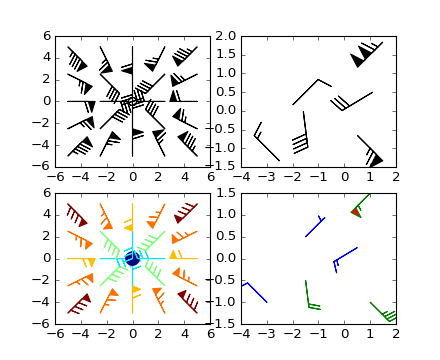
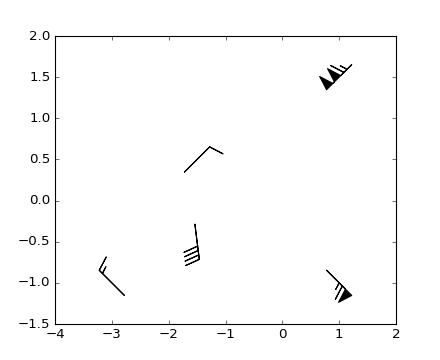
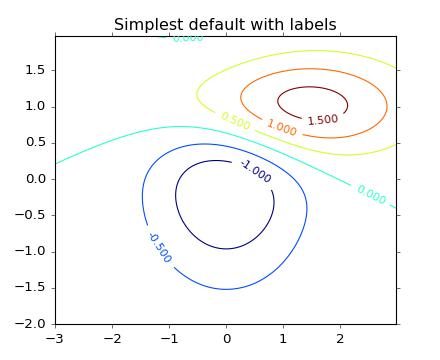
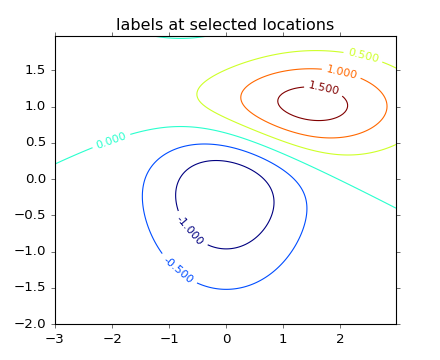
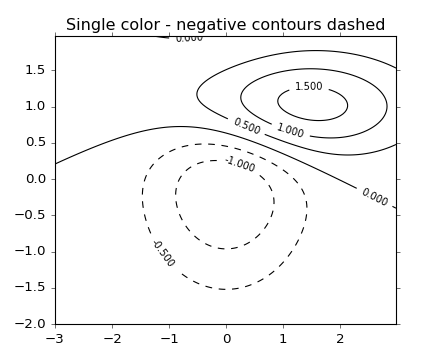
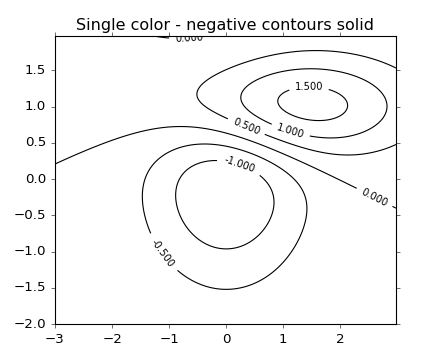

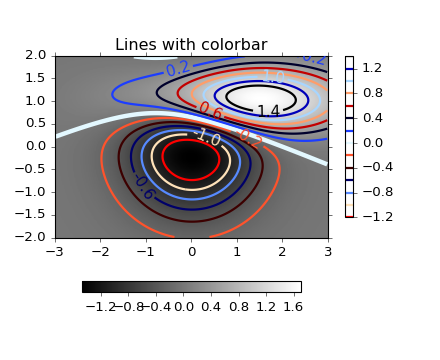
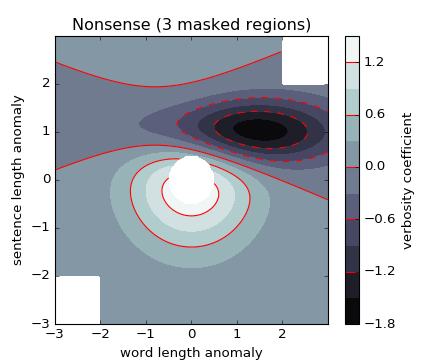

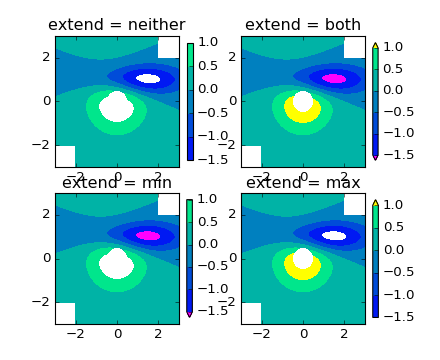
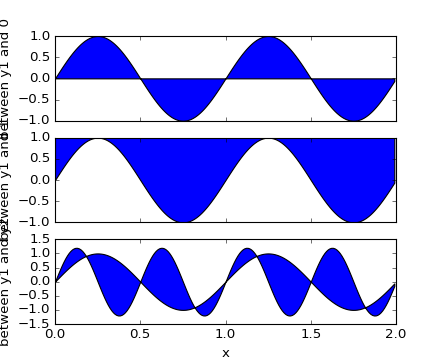
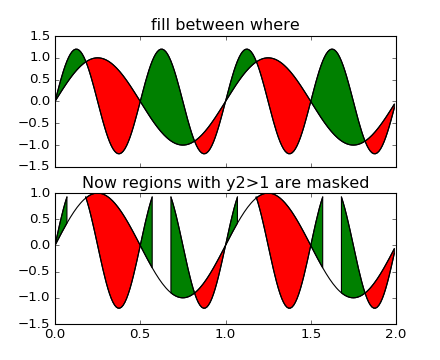
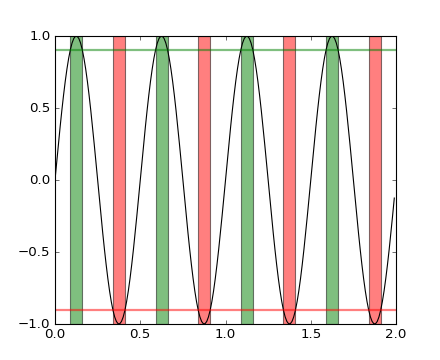
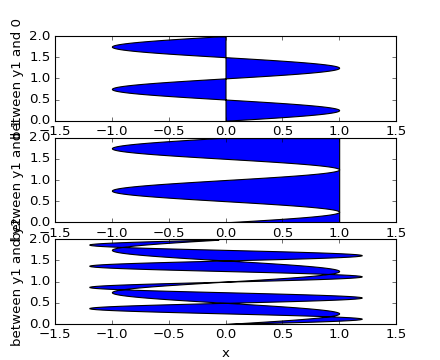
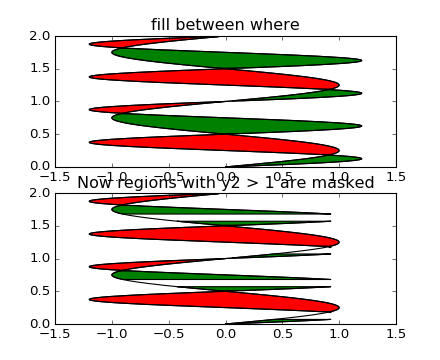
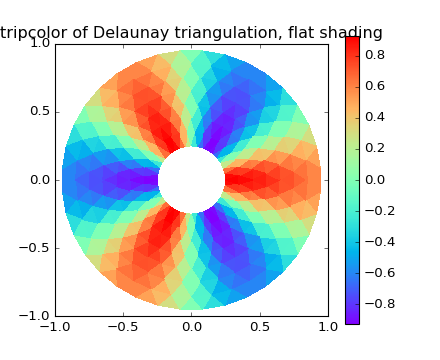
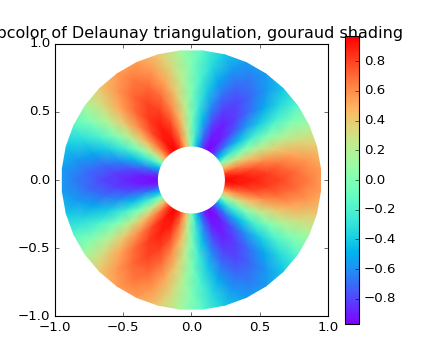
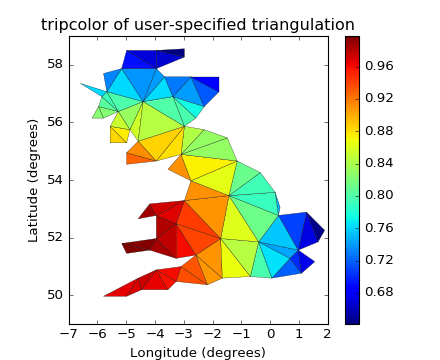
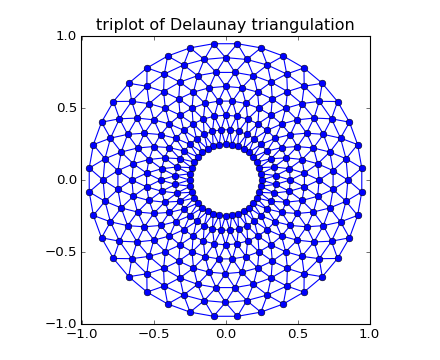
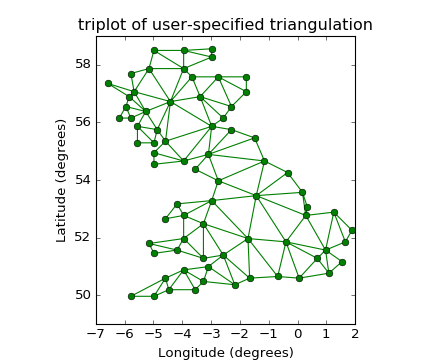
Please login to continue.